Crescent Sustainability Initiatives
Partnerships for the Goals (SDG 17)
Yes. BSACIST have direct involvement in, or input into, national government or regional non-government organisations SDG policy development – including identifying problems and challenges, developing policies and strategies, modelling likely futures with and without interventions, monitoring and reporting on interventions, and enabling adaptive management.
The Crescent Innovation and Incubation council (CIIC) https://ciic.ventures/ provides access to a range of resources and services, including facilities, equipment, and expertise, to tackle challenges and advance projects. Whether you represent a small or medium-sized enterprise, a large multinational corporation, a public sector entity, a charity, or a non-governmental organization, our experts are available to discuss and address your specific needs.
Our Incubators collaborate with regional and governmental organizations to develop policies that align with the United Nations Sustainability Development Goals (SDGs) https://ciic.ventures/wp-content/uploads/2023/04/113-CIIC-Startups-Compendium-compressed.pdf. Explore how our engagement spans various sectors and contributes to best practices in achieving SDGs through international collaborations. Our incubators actively participate in global initiatives, collecting data to drive progress toward the Goals. Much of our incubators are dedicated to addressing SDGs through partnerships with non-governmental organizations.
https://crescent.bytdigital.com/iqac-csi-2021-23/

By 2030, upgrade infrastructure and retrofit industries to make them sustainable, with increased resource-use efficiency and greater adoption of clean and environmentally sound technologies and industrial processes, with all countries taking action in accordance with their respective capabilities.
Smart India Hackathon 2022 (Jointly Organized by Ministry of Education’s Innovation Cell (MIC), Government of India and BSACIST)
B.S. Abdur Rahman Crescent Institute of Science and Technology has been selected as one of the 75 Nodal Centres across India to host Smart India Hackathon 2022 – Hardware Edition.
Smart India Hackathon 2022 is a nationwide initiative by Ministry of Education’s Innovation Cell (MIC), Government of India. to provide students with a platform to solve some of the pressing problems we face in our daily lives, and thus inculcate a culture of product innovation and a mindset of problem.
Smart India Hackathon brings the next generation evolution by inclusion of new methodology to inculcate the culture of startup and innovation ecosystem across different age groups.
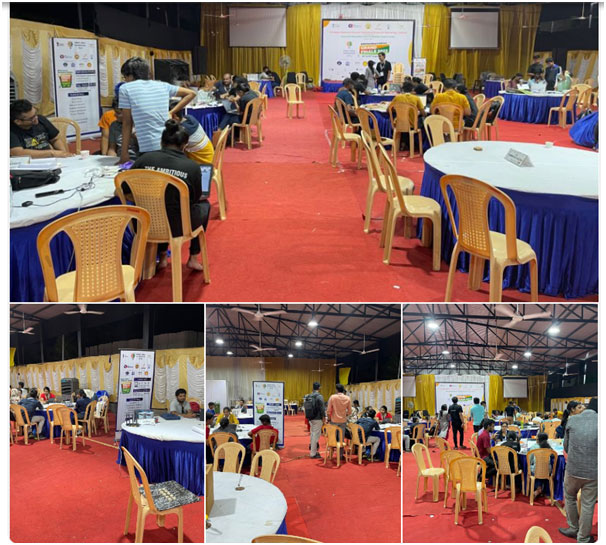
| S. No. | Themes | SDG Addressed |
|---|---|---|
| 1 | SMART AUTOMATION Ideas focused on the intelligent use of resources for transforming and advancements of technology with combining the artificial intelligence to explore more various sources and get valuable insights. | SDG 4 |
| 2 | FITNESS & SPORTS Ideas that can boost fitness activities and assist in keeping fit. | SDG 3 |
| 3 | HERITAGE & CULTURE Ideas that showcase the rich cultural heritage and traditions of India. | SDG 11 |
| 4 | MEDTECH/BIOTECH/ HEALTHTECH Cutting-edge technology in these sectors continues to be in demand. Recent shifts in healthcare trends, growing populations also present an array of opportunities for innovation. | SDG 3 |
| 5 | AGRICULTURE, FOODTECH & RURAL DEVELOPMENT Developing solutions, keeping in mind the need to enhance the primary sector of India – Agriculture and to manage and process our agriculture produce. | SDG 2 |
| 6 | SMART VEHICLES Creating intelligent devices to improve commutation sector. | SDG 7, SDG 11 and SDG 13 |
| 7 | TRANSPORTATION & LOGISTICS Submit your ideas to address the growing pressures on the city’s resources, transport networks, and logistic infrastructure. | SDG 7, SDG 11 and SDG 13 |
| 8 | ROBOTICS AND DRONES There is a need to design drones and robots that can solve some of the pressing challenges of India such as handling medical emergencies, search and rescue operations, etc. | SDG 3 |
| 9 | CLEAN & GREEN TECHNOLOGY Solutions could be in the form of waste segregation, disposal, and improve sanitization system. | SDG 7 |
| 10 | TOURISM A solution/idea that can boost the current situation of the tourism industries including hotels, travel and others. | SDG 11 |
| 11 | RENEWABLE / SUSTAINABLE ENERGY Innovative ideas that help manage and generate renewable /sustainable sources more efficiently. | SDG 7 |
| 12 | BLOCKCHAIN & CYBERSECURITY Provide ideas in a decentralized and distributed ledger technology used to store digital information that powers cryptocurrencies and NFTs and can radically change multiple sectors. | SDG 4 |
| 13 | SMART EDUCATION Smart education,a concept that describes learning in digital age. It enables learners to learn more effectively, efficiently, flexibly and comfortably. | SDG 4 |
| 14 | DISASTER MANAGEMENT Disaster management includes ideas related to risk mitigation, Planning and management before, after or during a disaster. | SDG 13 |
| 15 | TOYS AND GAMES Challenge your creative mind to conceptualize and develop unique toys and games based on our civilization, history, and culture etc. | SDG 11 |
| 16 | MISCELLANEOUS Technology ideas in tertiary sectors like Hospitality, Financial Services, Entertainment and Retail. | SDG 4 |
| 17 | SPACE TECHNOLOGY Space technology refers to the application of engineering principles to the design, development, manufacture, and operation of devices and system | SDG 4 |
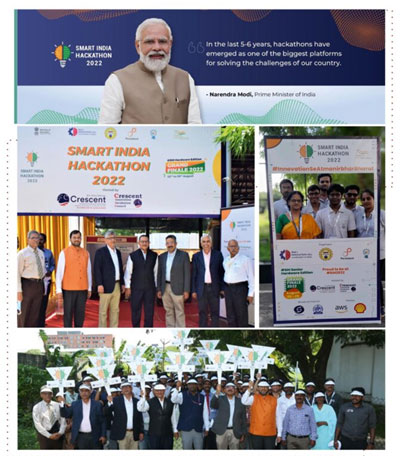
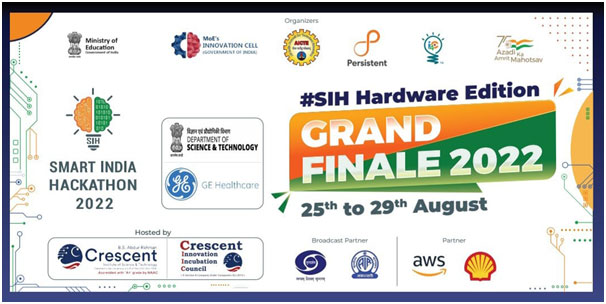

Tamilnadu Pollution Control Board & B.S.Abdur Rahman Crescent Institute of Science & Technology Jointly organized and implemented Continuous Ambient Air Quality Monitoring Station (CAAQMS) in the Campus on 28th October 2020.
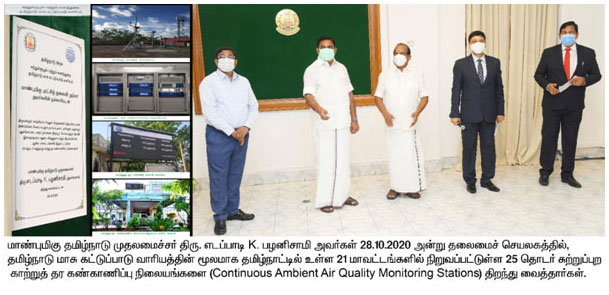
The Project was inaugurated by Mr. D.Vasudevan, District Environmental Engineer, Tamilnadu Pollution Control Board and Dr. A.Peer Mohamed, Pro Vice Chancellor & VC – In Charge. Dr. A.Azad, Registrar, AlhajV.N.A.Jalal, Senior General Manager, Dr. N.Raja Hussain, Deputy Registrar took part in the inauguration.

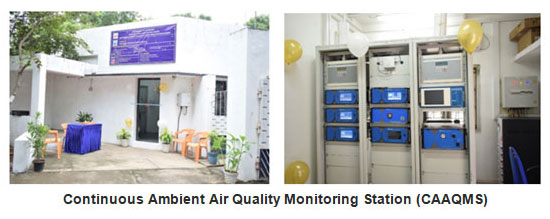

Crescent Innovation and Incubation council (CIIC) is glad to announce the selection as Partner Incubator by Innovation for Defence Excellence (IDEX) by Defence Innovation Organization, Department of Defence Production, Ministry of Defence, Govt of India. The MoU was exchanged in the presence of Honourable Union Defence Minister Shri.Rajnath Singh Ji, Chief of Defence Staff, Chief of Naval Staff, Vice Chief of Army Staff, Vice Chief of Airforce Staff in Bharat Mandapam, New Delhi. During the event, 76 Defence Innovation Startup Challenges (DISC X) were launched to accelerate and build self reliance capacity in the Defence Ecosystem. Startups can apply at https://idex.gov.in/
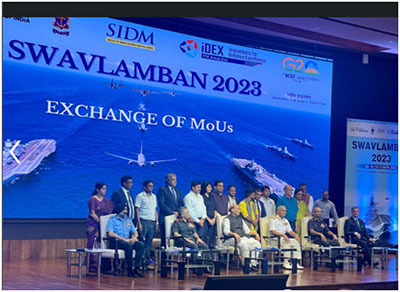

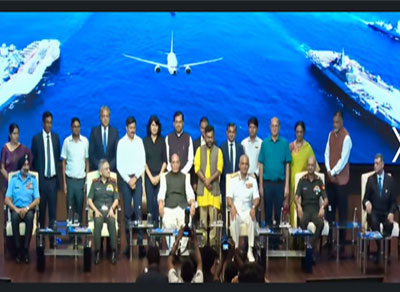
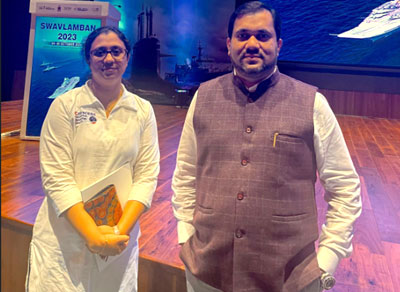

Dr. Faridha Begum, Assistant Professor in School of Life Sciences has been appointed as a member in TNGCA committee form by Environment, Climate Change and Forest Department of Tamil Nadu State.
Government of Tamil Nadu has made an Announcement on the floor of the Tamil Nadu legislative Assembly on 3rd September 2021 that Tamil Nadu Green Champion Awards (TNGCA) would be presented to individuals and organizations to recognize and encourage outstanding contributions in the field of environment protection and the Government has issued G.O.(Ms).No.90 Environment, Climate Change and Forest (EC.2) Department dated 26.10.2021 and has also to constitute a District Level Award Committee in all the Districts. As per the said Government Order, the District Level Award Committee is constituted with following officials.
(i) https://crescent.bytdigital.com/iqac-csi-sdg7-2021-23/#pct
(ii) Dr. N. Ayyanathan, Professor, BSACIST member in INTACH NGO
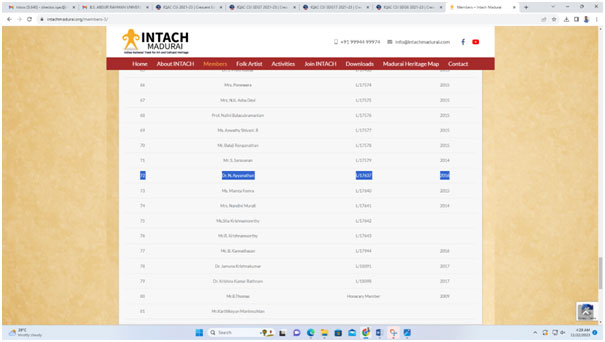
https://intachmadurai.org/members-3/

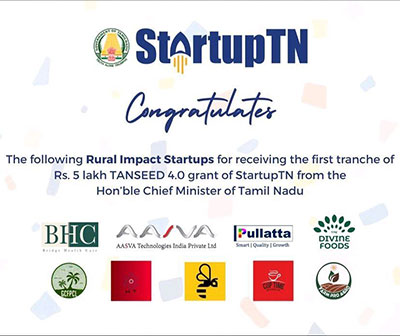

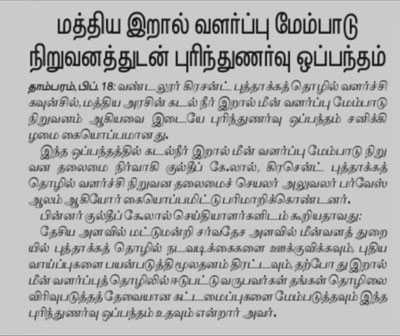
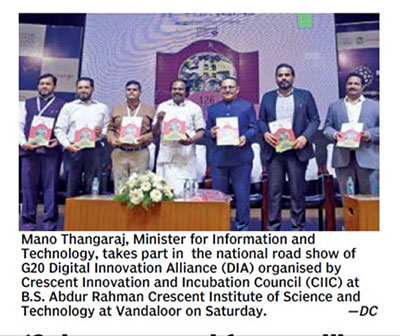
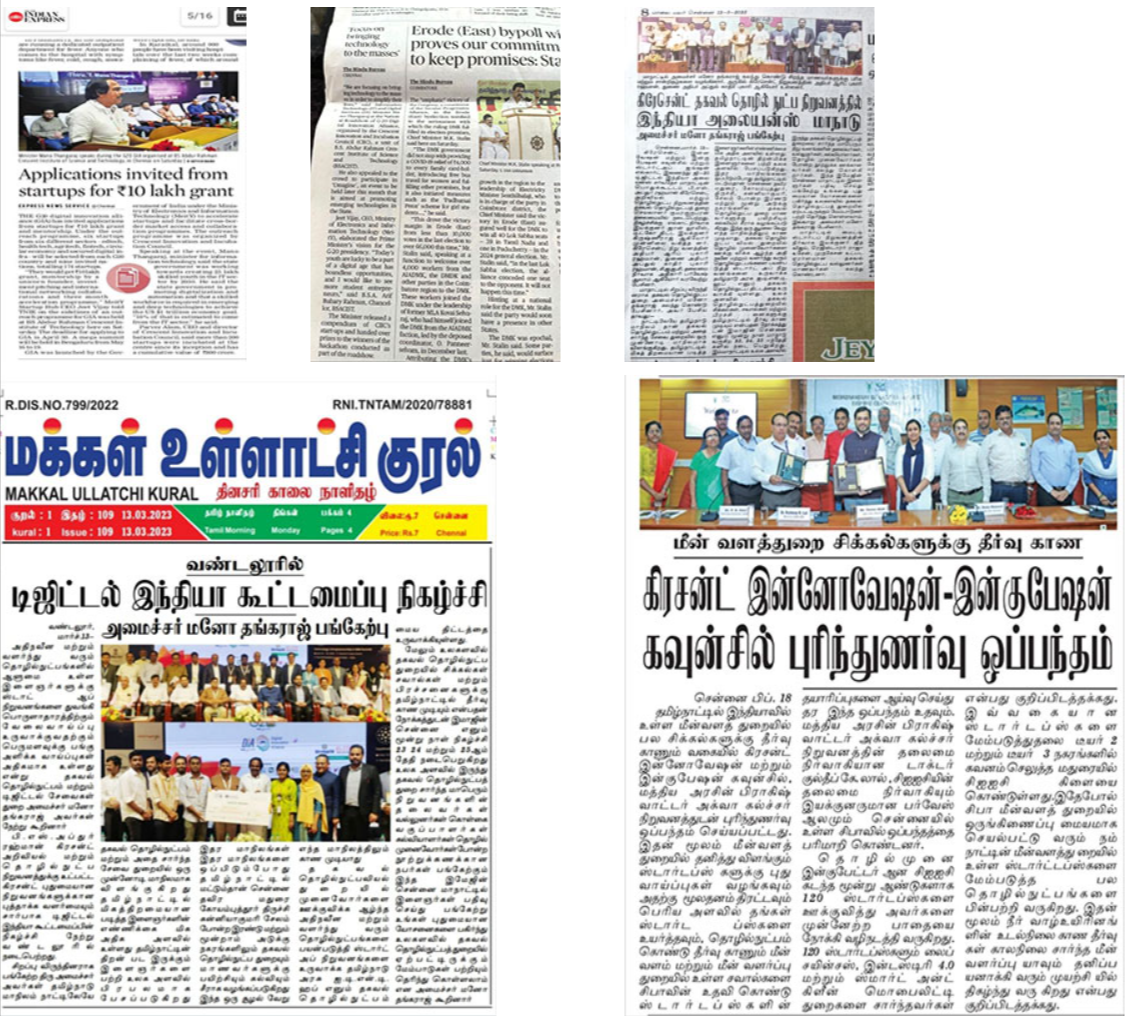
Academic Year 2020-21
Dr. Faridha Begum, Assistant Professor in School of Life Sciences has been appointed as a member in TNGCA committee form by Environment, Climate Change and Forest Department of Tamil Nadu State.
Government of Tamil Nadu has made an Announcement on the floor of the Tamil Nadu legislative Assembly on 3rd September 2021 that Tamil Nadu Green Champion Awards (TNGCA) would be presented to individuals and organizations to recognize and encourage outstanding contributions in the field of environment protection and the Government has issued G.O.(Ms).No.90 Environment, Climate Change and Forest (EC.2) Department dated 26.10.2021 and has also to constitute a District Level Award Committee in all the Districts. As per the said Government Order, the District Level Award Committee is constituted with following officials.
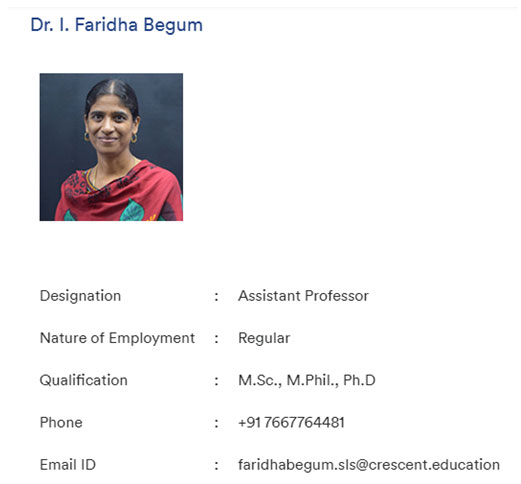
![]()
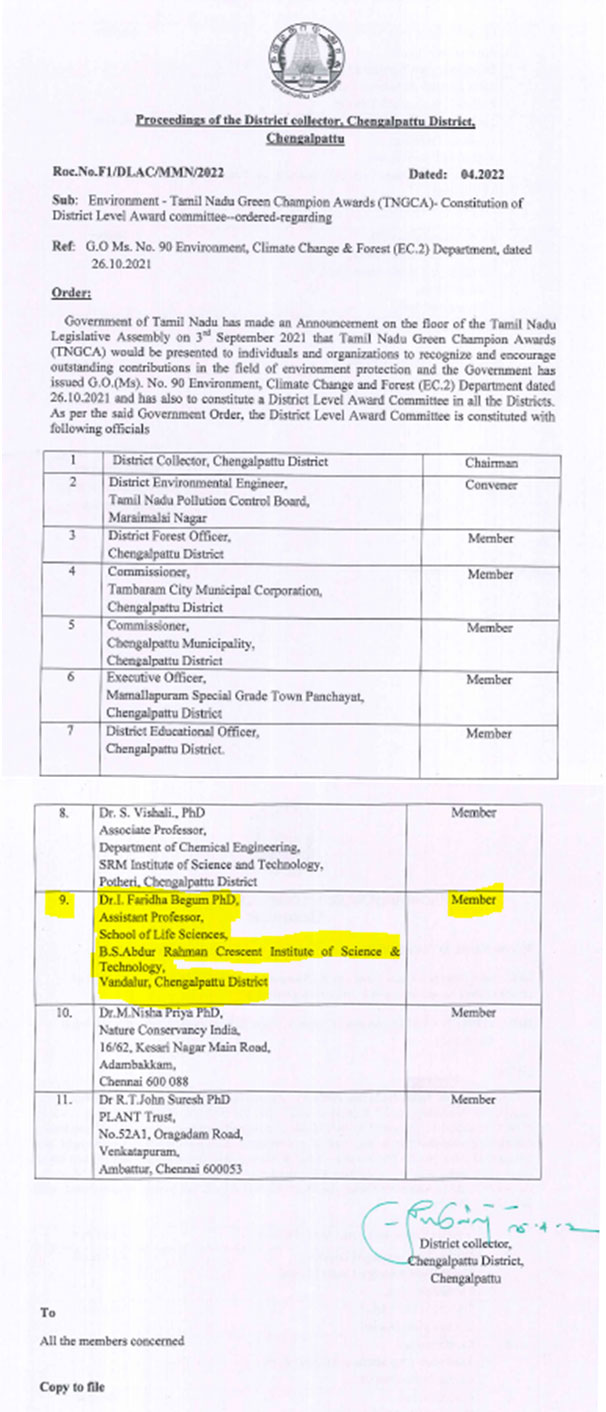


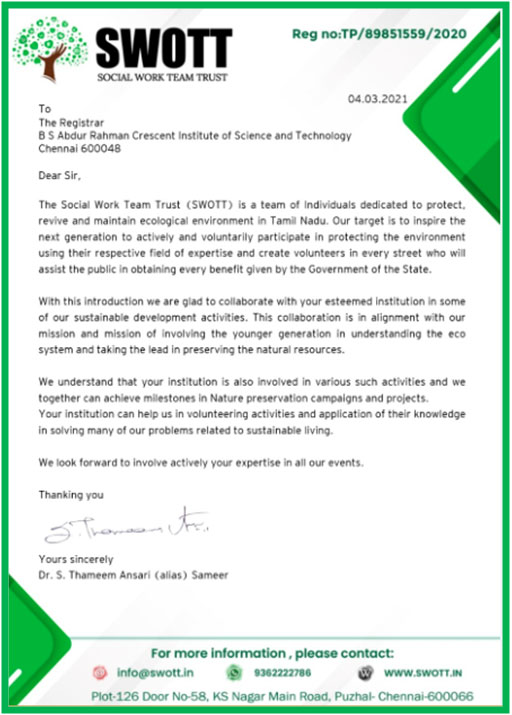
Corporate Social Responsibility (CSR) with Jasmin Infotech Pvt Ltd, Chennai for saranalayam old age home
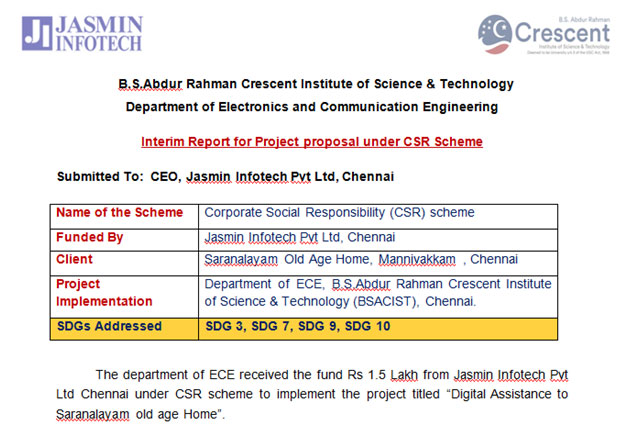
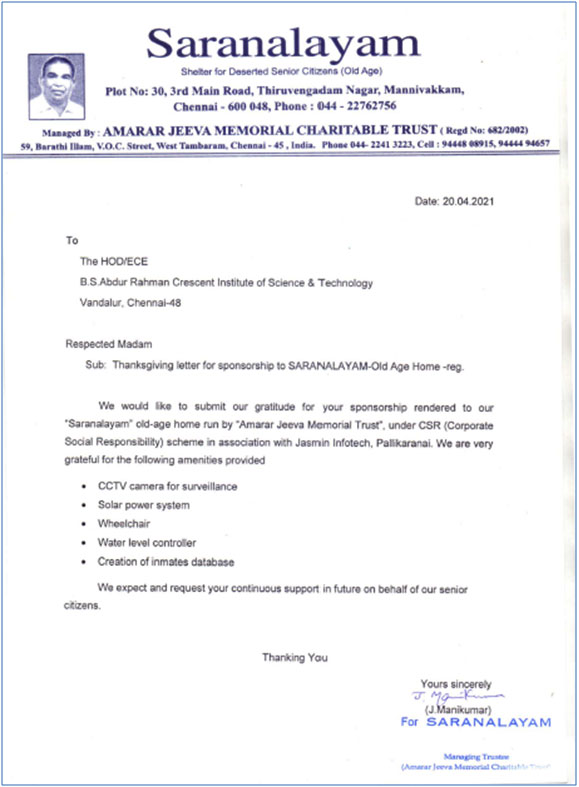
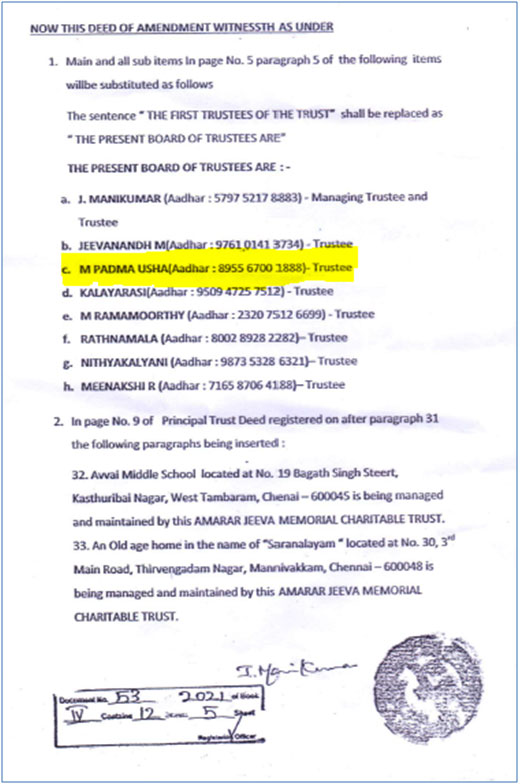

![]()
https://crescent.bytdigital.com/wp-content/uploads/2022/11/Annual-Report-of-NGO.pdf
Promote peaceful and inclusive societies for SDG-16 with Tamilnadu Government – Cyber Crime Awareness
It gives me immense pleasure to inform you all that the office of student affairs of our Institute along with the Cyber crime cell of Greater Chennai Police has created a few cyber-crime awareness videos which went live today.
Many universities and colleges offer programmes on visual communication but our Institute was approached for the videos. Thanks to Dr. Abuthahir Director/IQAC who had referred the strength of our university to them. Our students took this as a challenge and accepted the assignment. It just took three days (weekend and Monday) for our students to conceive the whole idea and make it as short clips. The police personnel rights from the Chennai City Commissioner to the entire team of Chennai city police were highly impressed by the dedication of our students in delivering the video with high standards in record time. Tmt P.C. Thenmozhi IPS, IGP/Additional Commissioner of Police (CCB) thanked the university for the video and recalled her past experience with our university during Prime Ministers visit to Kilambakkam when our team of students submitted the video in Chennai Commissioner Office on 20th of July.
Our Sincere thanks to Our Vice Chancellor, Additional Registrar, General Manager, the team of CIIC and CITL (The effort of D. Surendar of CITL was commendable and much appreciated by the Assistant Commissioner cyber-crime). The enthusiastic participation of faculty members Dr. P.K. Jawahar, Professor/ECE and Dr. S.M. Shaheedha Assoc. Prof. /Pharmacy has impressed the police officials.
This video was released by the cyber crime wing today, video went viral, it was in the headlines in all leading Tamil News channels (example. Puthiyathalaimurai, Polymer, News 7, Sun News and Thanthi TV) and Indian Express published the news in their website thereby giving an excellent visibility to our Institute. The greatest strength of our Institute is our students and they proved it once again by this wonderful achievement.
My heartfelt appreciation to the student team lead by Mohamed Irfan/CSE along with Nithin /ECE, Srinath/BCA(MM), Vaishali/ Biotech, Falak Zohra/Biotech, Evangeline/BBA, Aishwarya/ B.Com(A&F), SaiJayashree/B.Com, Anish Shabiya/ Biotech, Fazul Rahman /Aero and Faraz Khan/B.Sc(CS).
Facebook link for the videos (3000+ views in single day)
![]()
https://www.facebook.com/457621584324537/videos/4138013292956822
https://www.facebook.com/story.php?story_fbid=4174555562631102&id=457621584324537&scmts=scwspsdd
https://www.facebook.com/story.php?story_fbid=4174550839298241&id=457621584324537&scmts=scwspsdd
https://www.youtube.com/watch?v=tPniWz986Ks
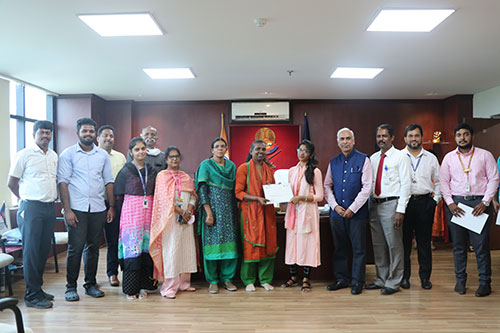
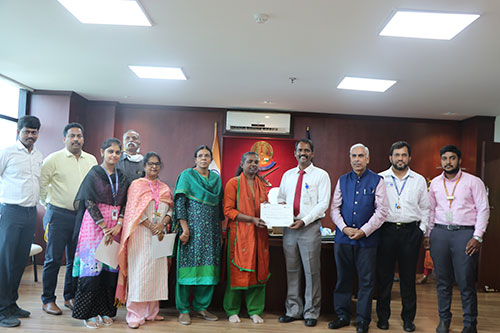
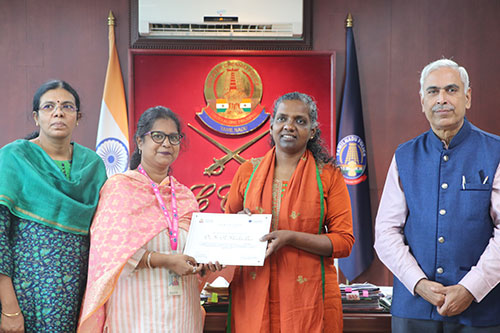
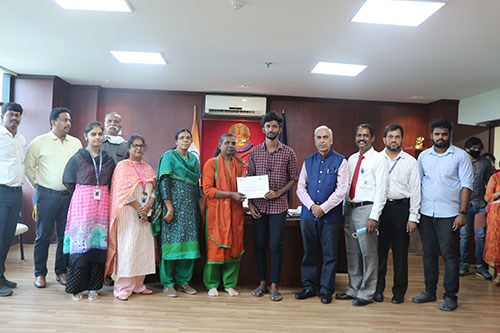
Evaluation of Sacrificial Anode Cathodic Protection (SACP) Systems for Reinforced Concrete Applications

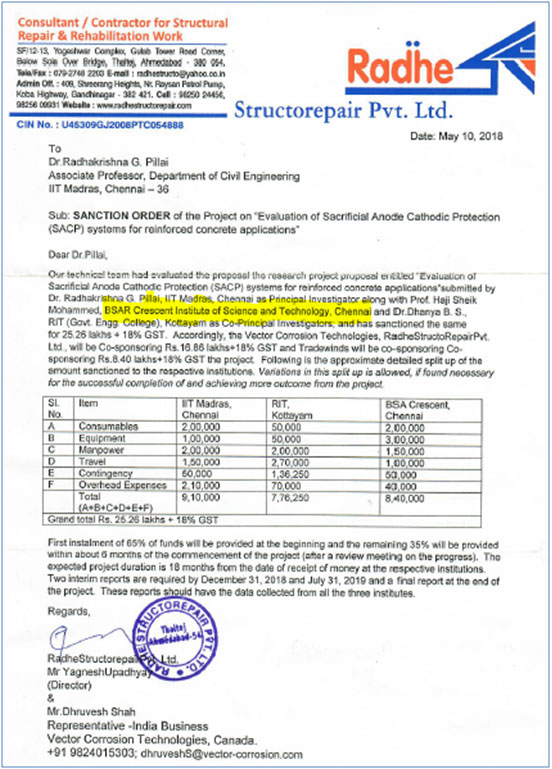
![]()
CIIC is proud to share that we have signed an MoU with TICEL Park, Govt. of Tamil Nadu in the presence of Honourable Thiru M. K. Stalin, Chief Minister of Tamil Nadu. CIIC was greatly appreciated by Honourable Thiru. Thangam Thennarasu, Minister of Industries, Govt. of TN & Honourable Thiru. T. M. Anbarasan, Minister of MSME, Govt. of TN for all the efforts in creating a healthy Startup Ecosystem in Tamil Nadu.
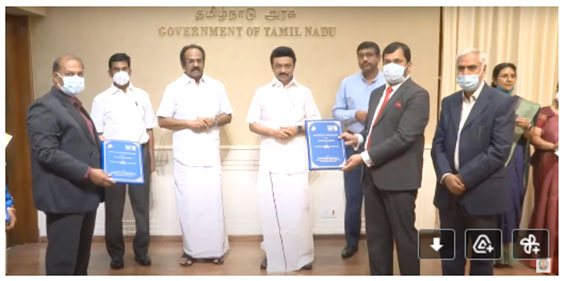
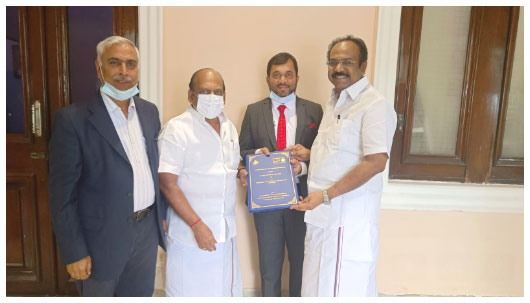
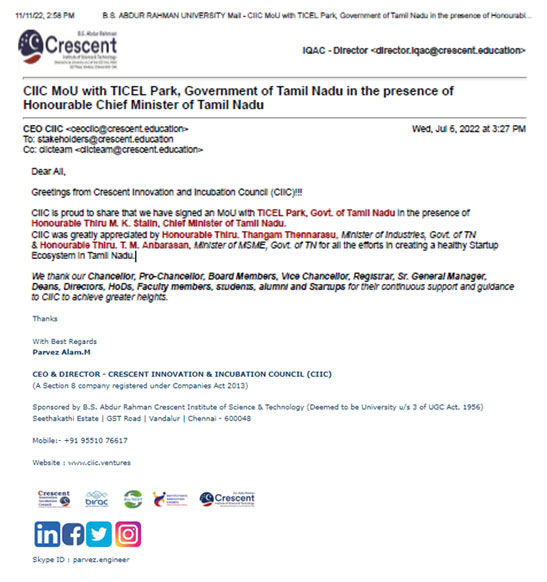
![]()
An MoU was signed between Crescent Innovation and Incubation Council (CIIC) www.ciic.ventures and Cambridge Cleantech cambridgecleantech.org.uk to collaborate towards common goals in respect of the development of the cleantech ecosystem in Tamil Nadu and the United Kingdom (UK). The objective of this collaboration is to develop and sustain cleantech industries and their respective communities through raising capital and scaling up.
The honourable British Deputy High Commissioner, Chennai – Mr. Oliver Ballhatchet, Deputy Head of Mission Chennai- Mr. Paul Dryden graced the occasion with their presence. Mr. Martin Garratt, the CEO of Cleantech and Mr. M Parvez Alam, CEO of CIIC exchanged the MoU at the embassy of British Deputy High Commission, Chennai. Mr. Sam Kumar – Senior Prosperity Adviser, Mr. Sujith Thomas – Head – Engineering & Manufacturing, Future Mobility Sector, India, Ms. Tabinda Bashir – Energy and Climate Change Advisor, Satyajit R Mohanan – Client Relations and Projects Coordinator – Cambridge Cleantech and the CIIC team were also present for the signing.
Crescent Innovation and Incubation Council (CIIC) is a Tamilnadu based Business Incubator fostering startups pertaining to the sectors of Life Sciences, Industry 4.0, Smart and Clean Mobility. CIIC has also established a centre in Madurai focusing on tapping innovations arising from Tier 2 & Tier 3 cities.
Cambridge Cleantech (CCT) connects SMEs, investors, corporate and academics for a smarter, more sustainable future. Founded in 2011, we are the UK’s leading cleantech cluster firmly embedded in the Cambridge, national – including London and Oxford – and international technology eco-systems.
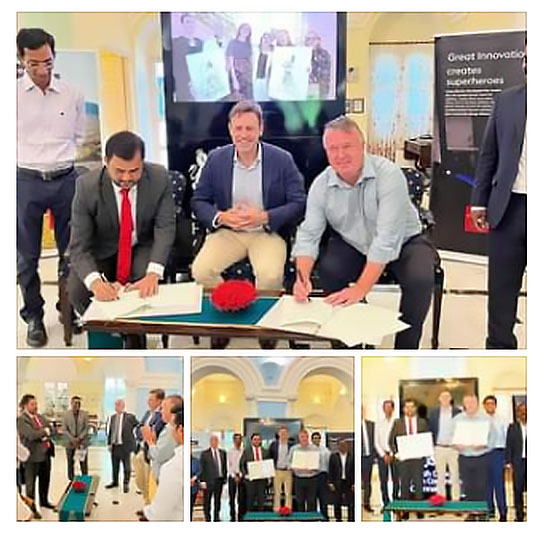
![]()
The 45th Indian Social Science Congress, organized jointly by the Indian Social Science Academy (ISSA) and B.S. Abdur Rahman Crescent Institute of Science and Technology, is scheduled to take place in Chennai from March 28 to April 01, 2022. This prestigious event, recognized by the University Grants Commission at par with the Indian Science Congress, encompasses a diverse range of subjects, including Sciences, Engineering, Humanities, Law, and more, all within the framework of Nature-Human-Society.
The Congress features 28+ subject Research Committees and 21+ interdisciplinary Thematic Panels, serving as platforms for the representation and discussion of current research and theories across various domains. Notably, the Indian Social Science Congress holds distinctive attributes, with a focus on fostering the development of Science and Technology to make India and its people self-reliant.
The overarching theme for the XLV Indian Social Science Congress is ‘Environment, Energy, and Health,’ emphasizing the significance of these interconnected aspects in the contemporary world. Deliberations during the event will cover a wide spectrum of subjects, including law, architecture, and pharmaceuticals, underscoring the interdisciplinary nature of discussions.
Furthermore, the Congress will host an exhibition showcasing industrial products and highlighting ‘Innovations and Discoveries in Science and Technology.’ This initiative aligns with the broader goal of promoting sustainable development and technological advancements for the betterment of society.
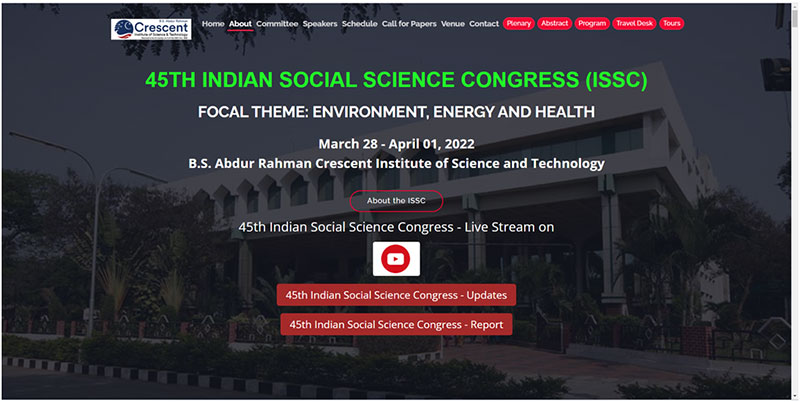
https://crescent.bytdigital.com/45issc-csd/
The purpose of the SDG Accord is two fold
First it is to inspire, celebrate and advance the critical role that education has in delivering the UN Sustainable Development Goals (SDGs) and the value the interlinked objectives brings to governments, business and wider society.
Second, the Accord is a commitment made by learning institutions to one another, to do more to deliver the SDGs, annually report on individual progress as a Signatory, and do so in ways which share the learning with each other both nationally and internationally. Objectives include annually presenting the updated Accord metrics at the UN High Level Political Forum on Sustainable Development.
Academic Year 2020-21
2nd Virtual Annual International Conference on Naturopathy, Nanotechnology, Nutraceuticals and Immunotherapy in Cancer Research – 2021
B.S. Abdur Rahman Crescent Institute of Science & Technology in association with W Purdue University, USA
Sponsored by TamilNadu State Council for Science & Technology (TNSCST) & Microbiologist Society, India (MSI)

on 11th – 12th June 2021
Organizing Secretory
| Dr. S. Hemalatha Professor & Head School of Life Sciences | Dr. Raji Sundararajan Professor, Purdue University, USA | Dr. Ignacio Camarillo Associate Professor, Purdue University, USA |
Dr. P. Ashok Kumar (Assoc. Prof), Dr. Soumen Bera (Asst. Prof), Dr. Neesar Ahmed (Asst. Prof)
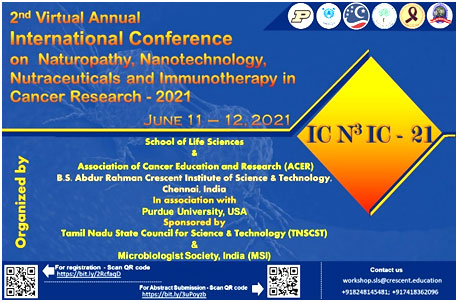
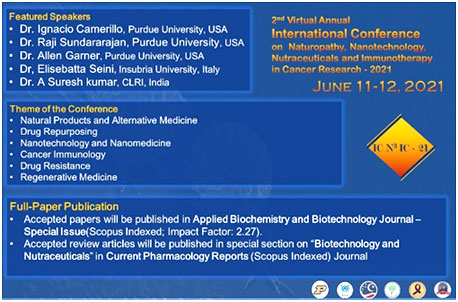
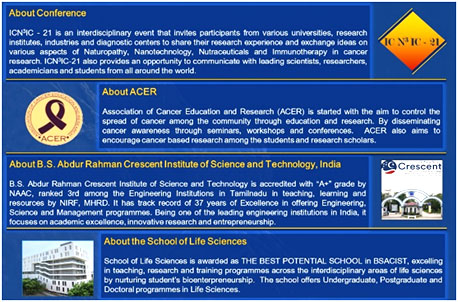
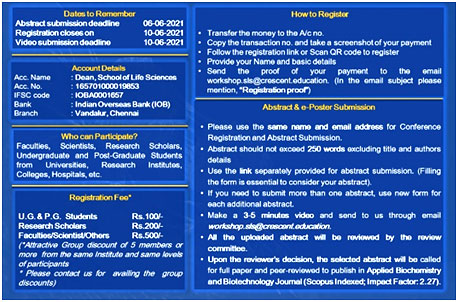
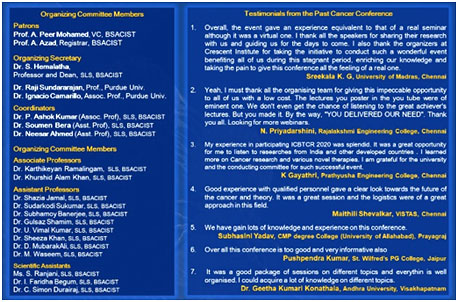
Nature of Participants: Undergraduate and Post graduate students, Research Scholars, Professors, Scientist
Total number of participants: 502
Registration Fee: UG & PG – 100/-, Scholars – 200/-, Faculties/Scientist/ Others – 500/-
Fee Received: 70,700/-/-
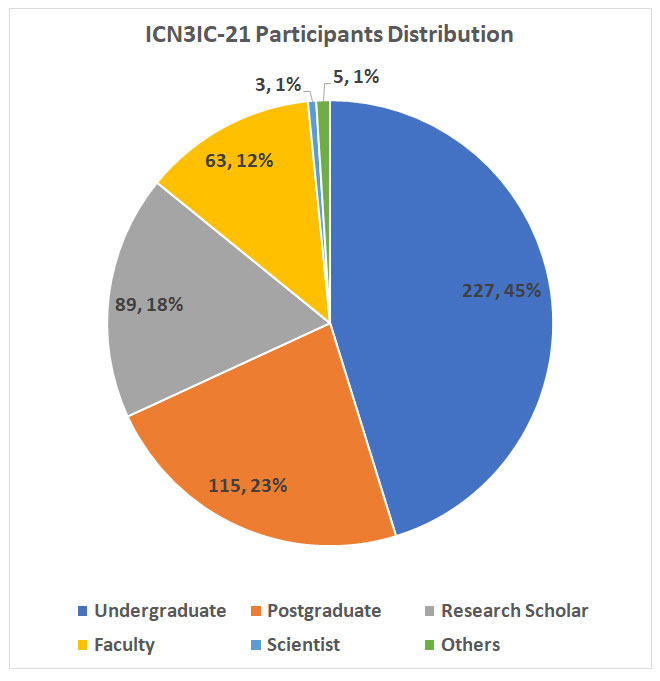
Registration link: https://bit.ly/2RcfaqD
Abstract Submission link: https://bit.ly/3uPoyzb
Day 1 (11.06.2021)
Session 1:
| Inaugural address of ICN3IC-21 Speaker: Dr. S. Hemalatha, Professor & Dean, President, ACER Video URL: https://youtu.be/X8pmObd9zws | 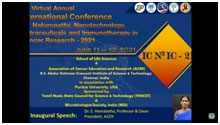 |
About Association of Cancer Research & Education (ACER) Speaker: Dr. Neesar Ahmed, Assistant Professor (Sel.Gr.), School of Life Sciences | 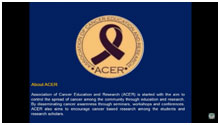 |
Plenary Lecture: Mechanisms of Obesity and Leptin in Breast Cancer | 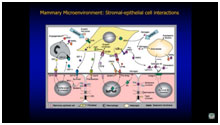 |
Invited Talk 1: 3D scaffolds to mimic extra-cellular matrix: evaluation of the cell electroporation Speaker: Dr. Elisebatta Seini, Department of Theoretical and Applied Science, University of Insubria, Varese, Italy Video URL: https://youtu.be/chWDzrqxnF4
| 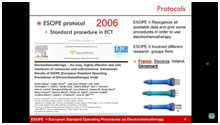 |
Session 2
| Invited Talk 2: Therapeutic aspects of FOXO signaling in breast cancer cells using natural products Speaker: Dr. A. Suresh Kumar, Senior Scientist, Department of Biochemistry and Biotechnology, CSIR-CLRI, Adyar, Chennai, India Video URL: https://youtu.be/2xwdlzRNjRk | 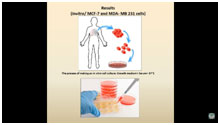 |
Day 2 (12.06.2021)
Session 3
| Invited Talk 3: Characterizing the Interactions of Electromagnetic Field Interactions with Biological Cells to Guide Medical Applications Speaker: Dr. Allen Garner, Associate Professor, School of Nuclear Engineering, School of Electrical and Computer Engineering, Department of Agricultural and Biological Engineering, Purdue University, USA Video URL: https://youtu.be/INZyEQaljR0 |  |
| Invited Talk 4: Cancer therapy: Cues from Nature Speaker: Dr. Kavitha Sankaranarayanan, Head, Ion Channel Biology Laboratory and AYUSH Research Centre, AU-KBC Research Centre, MIT Campus of Anna University, Chennai, India about Cancer therapy: Cures from Nature Video URL: https://youtu.be/jTu5MW4uRjM | 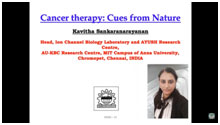 |
Session 4: Valedictory Session
| ICN3IC-21 Report. Speaker: Dr. Soumen Bera, Assistant Professor, School of Life Sciences Video URL: https://youtu.be/BdXwtwSbITA | 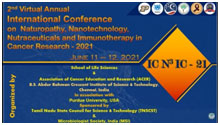 |
| Announcement of awards Speaker: Dr. C Simon Durairaj, Scientific Assistant, School of Life Sciences Video URL: https://youtu.be/SGkXxOGBYp4 | 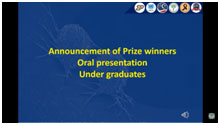 |
| Vote of Thanks Speaker: Dr. Ashok Kumar Pandurangan, Associate Professor, School of Life Sciences Video URL: https://youtu.be/PsRewUr_m2E Video URL: https://youtube.com/playlist?list=PLDdrGwJxD50kVzWccYY2bTCTBIJhwI-eR | 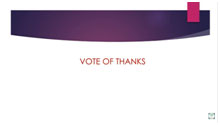 |
Oral / E-poster Presentation
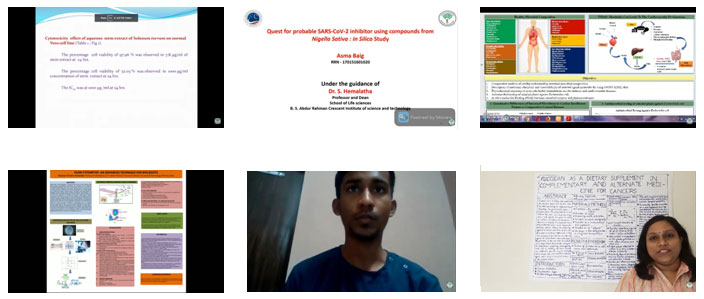
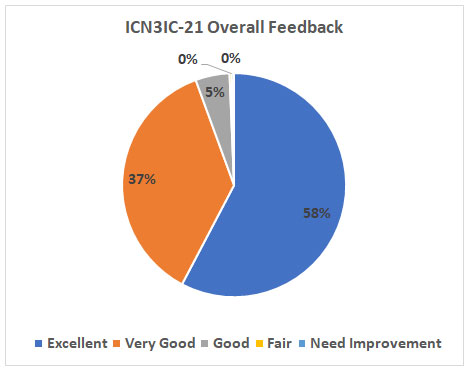
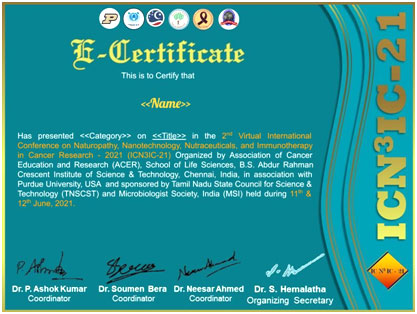
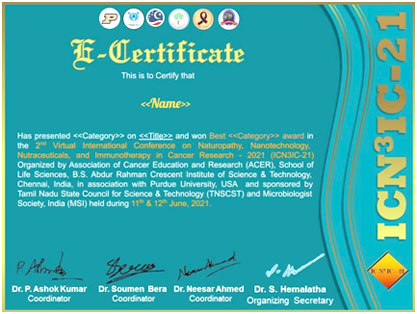
VIRTUAL INTERNATIONAL CONFERENCE ON NOVEL AND ALTERNATIVE THERAPEUTICS FOR NEURODEGENERATIVE DISEASES MEDIATED THROUGH UNFOLDED PROTEIN RESPONSE (UPR) – 2021
Organized by School of Life Sciences & B.S. Abdur Rahman Crescent Institute of Science & Technology
sponsored by International Brain Research Organization (IBRO ) in association with TamilNadu State Council for Science & Technology (TNSCST)

Organizing Secretory Dr. S. Hemalatha | Coordinators Dr. P. Ashok Kumar (Assoc. Prof) |

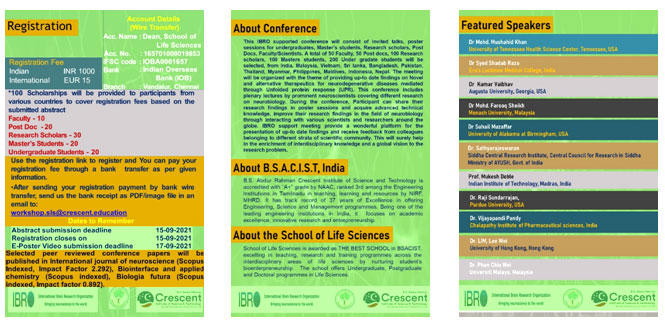
Nature of Participants: Undergraduate and Post graduate students, Research Scholars, Professors, Scientist, Post-Docs
Total number of participants: 537
Registration Fee: Indian – Rs.1000/-, International – EUR 15

Registration link: https://bit.ly/3B72B0Z

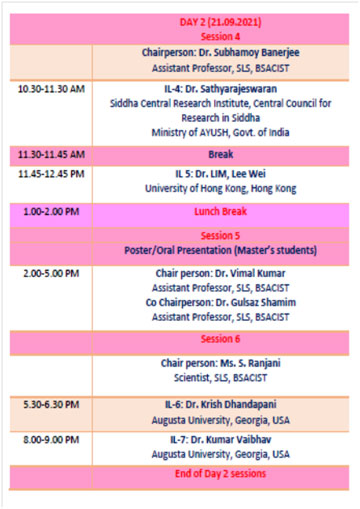
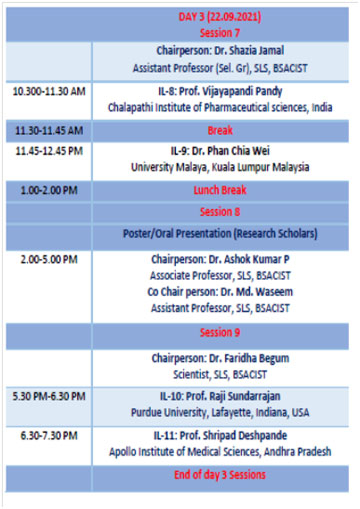

- Had a wonderful time in learning through the conference – Mohamed Juvad. N
- Can conduct many such conferences in future based on cancer biology – S Vaijayanthi
- Well organized conference – Dr L Juliet
- It is very help for us to know more – Mohammed Arsath Farvez K. A
- This conference enlightened us with more knowledge on various neuro degenerative disorders – Aberna
- All the sessions were very informative – Dr.S.Mary Princess Sulekha
- Funtastic conference please continue it every year thank you – Dr. Mohammad Ahmad
- All the participants gave very informative informations what he or she doing in the field of neuroscience.I really enjoyed every session, I hope crescent would organize these kinds of conference in future. – Mohd Kashif
- Chair persons discussion after each presentation was good. – Dr.L.Juliet
- Lots of information has been shared in this conference and congrats to the organizing for this wonderful event. – Vajagathali M
- Thank for all speakers for giving valuable information. Some network issue can be avoided. And sorry for mistaken that iam kavitha doing phd and not ug –
Kavitha. L - Excellent conference. Very well organized. Excellent speakers. We would love to attend more in future. – Koyeli Girigoswami
- Well organized with Technical sessions, excellent speakers and oral presentations – Dr. M. Indira
- Willing to attend more lectures from IBRO and other symposium – Shilpa Kumari
- This conference was very informative even though it was virtual it gave lot of insights across various fields – Hema P
- In the midst of the cytokine strom, the mightier neurostrom took over, well appreciated.well organised, keep it up. – Veni Subramanyam

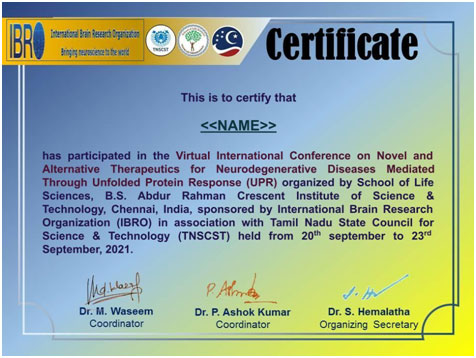

International Conference on Basic and Translational Cancer Research: Novel Ideas and Approaches (ICBTCR-2020)
School of Life Sciences, B.S. Abdur Rahman Crescent Institute of Science & Technology in association with W. M. Keck Center for Cellular Imaging, University of Virginia, USA &
TamilNadu State Council for Science & Technology (TNSCST)

| Dr. S. Hemalatha Professor & Head School of Life Sciences | Dr. Ammasi Periasamy Director and founder, W M Keck Center for Molecular Imaging, University of Virginia, USA |
Dr. Soumen Bera (Asst. Prof)
Dr. Neesar Ahmed (Asst. Prof)
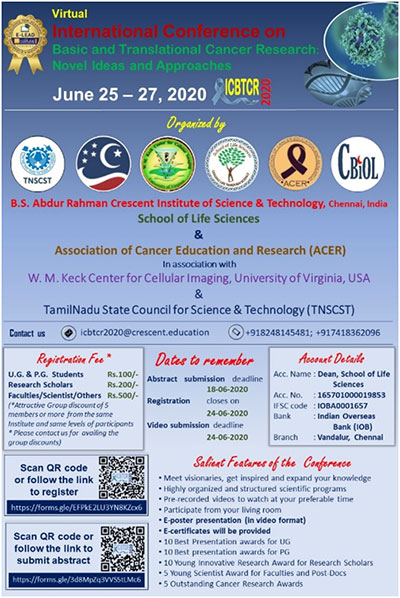
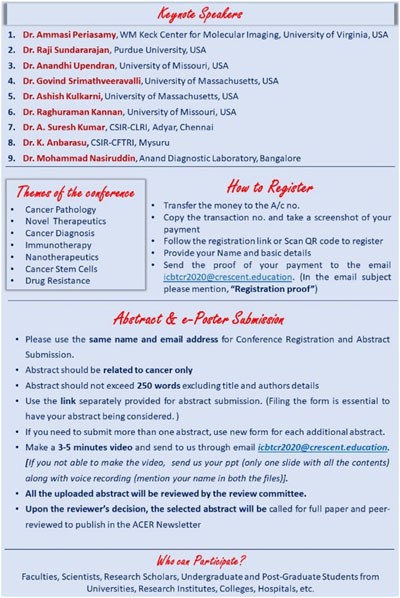
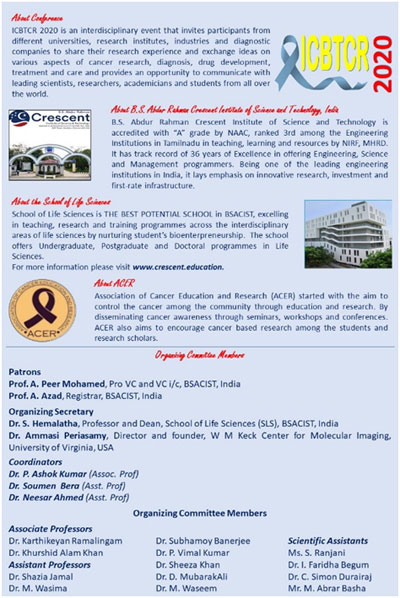
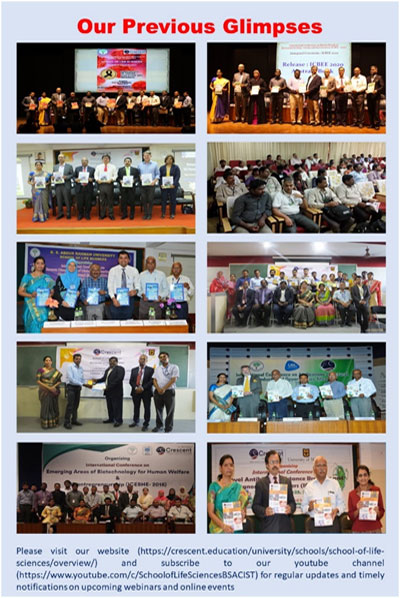
Nature of Participants: Undergraduate and Post graduate students, Research Scholars, Professors, Scientist
Total number of participants: 277
Registration Fee: UG & PG – 100/-, Scholars – 200/-, Faculties/Scientist/ Others – 500/-
Fee Received: 19300/-
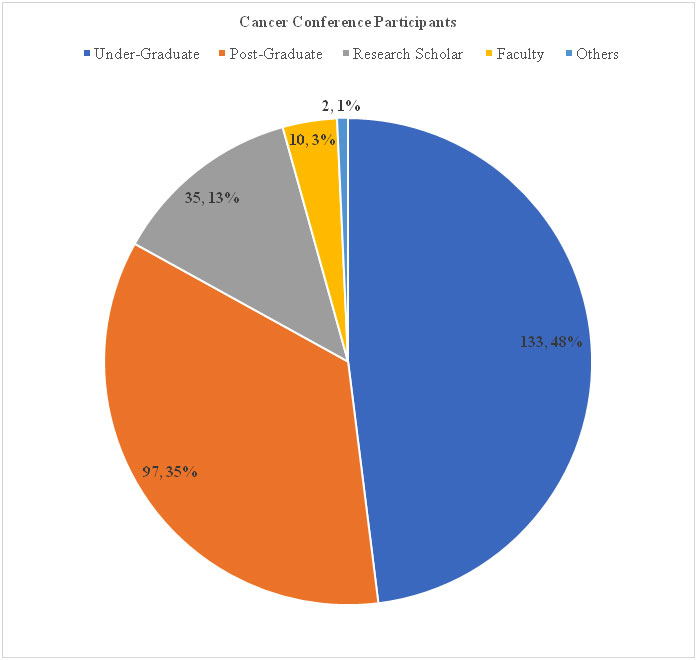
Registration link: https://forms.gle/EFPkE2LU3YN8KZcx6
Day 1 (25.06.2020)
Session 1:
| Inaugural address of ICBTCR-2020 Speaker: Dr. S. Hemalatha, Professor & Dean, President, ACER Video URL: https://youtu.be/As5Y7FpG_58 | 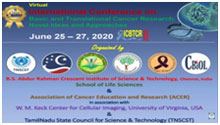 |
| About Association of Cancer Research & Education (ACER) Speaker: Dr. Neesar Ahmed, Assistant Professor (Sel.Gr.), School of Life Sciences Video URL: https://youtu.be/xheXarLP_-M | 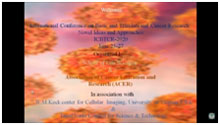 |
| Introduction of Speakers Speaker: Mr. Mohammed Abrar Basha, Scintific Assistant, School of Life Sciences Video URL: https://youtu.be/4vALT5oYYF8 |  |
| Session 2: Investigation of Metabolism in Living Prostate Cells: Two-Photon FLIM-FLIRR Microscopy Speaker: Dr. Ammasi Periasamy, Professor & Center Director, WM Keck Center for Molecular Imaging, University of Virginia, USA Video URL: https://youtu.be/JpjWOb473LU | 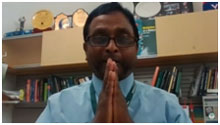 |
| Session 3: Electrical Therapies for Virus-Based Human Cancers: Another View Speaker: Dr. Raji Sundararajan, Purdue University, USA Video URL: https://youtu.be/R_D7ythYt6E | 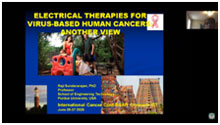 |
| Session 4: Use of Quantitative Proteomics to Define Mechanisms of Lippia origanoides in Activating Apoptosis Speaker: Dr. Ignacio G. Camarillo, PhD, Department of Biological Sciences, Purdue University, West Lafayette IN, USA Video URL: https://youtu.be/dNy0xkyh_GM |  |
| Session 5: Targeting FOXO3 Signaling by Bio-active Natural Product in Breast Cancer Prevention Speaker: Dr. A. Suresh Kumar, Senior Scientist, Biochemistry & Biotechnology Laboratory, CSIR-CLRI, Adyar, Chennai Video URL: https://youtu.be/TSHxPLKRD-U |  |
Day 2 (26.06.2020) Session 1: Energy-Based Cancer Therapy Speaker: Dr. Govind Srimathveeravalli, University of Massachusetts, USA Video URL: https://youtu.be/bh_kwZHUOFE | 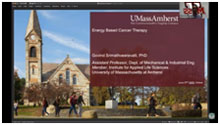 |
| Session 2: A 3D model to study electric field distribution in homogeneous tissue Speaker: Dr Sieni, Department of Theoretical and applied science, University of Insubria, Varese, Italy Video URL: https://youtu.be/gD1rYacvKwU | 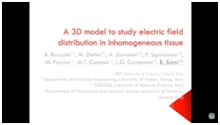 |
| Session 3: Emerging Nanotechnologies for Cancer Immunotherapy Applications Speaker: Dr. Ashish Kulkarni, University of Massachusetts, USA Video URL: https://youtu.be/yPvtNpUzqIQ | 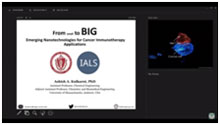 |
| Session 4: Exosomes: A Novel Biomarker for Cancer Speaker: Dr. K. Anbarasu, CSIR-Central Food Technological Research Institute, Mysuru Video URL: https://youtu.be/BNehOpK9Ffw | 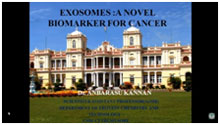 |
Day 3 (27.06.2020) Session 1: AXL Targeted Lung Cancer Therapy Speaker: Dr. Raghuraman Kannan, University of Missouri, USA Video URL: https://youtu.be/PC2Rl4nXqtE | 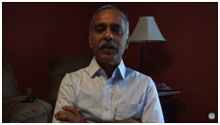 |
| Session 2: Targeting HMGA Protein Inhibits Retinoblastoma Cell Proliferation Speaker: Dr. Anandhi Upendran, University of Missouri, USA Video URL: https://youtu.be/PmqutLhMXpg |  |
| Session 3: Deletion of TRPV6 Channel Attenuates Alcohol & Stress-Induced Gut Barrier Dysfunction, Endotoxemia & Liver Damage Speaker: Dr. Avtar Singh Meena, The University of Tennessee Health Science Center, Memphis, Tennessee, USA Video URL: https://youtu.be/lIWW2CWqXA4 | 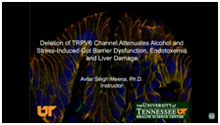 |
| Session 4: Valedictory Session ICBTCR2020 Report. Speaker: Dr. Soumen Bera, Assistant Professor, School of Life Sciences Video URL: https://youtu.be/BdXwtwSbITA | 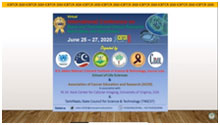 |
| Valedictory Address Speaker: Dr. Ammasi Periasamy, WM Keck Center for Molecular Imaging, University of Virginia, USA Video URL: https://youtu.be/fW7yNqyFmAM |  |
| Announcement of awards Speaker: Dr. C Simon Durairaj, Scientific Assistant, School of Life Sciences Video URL: https://youtu.be/fS6YMZ1JtEo | 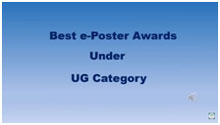 |
| Vote of Thanks Speaker: Dr. Ashok Kumar Pandurangan, Associate Professor, School of Life Sciences Video URL: https://youtu.be/NKXF4eHpKFU | 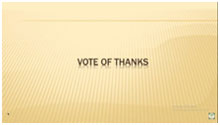 |
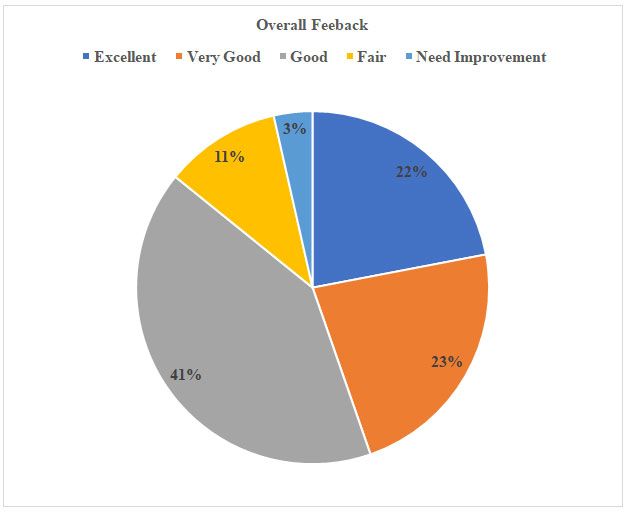
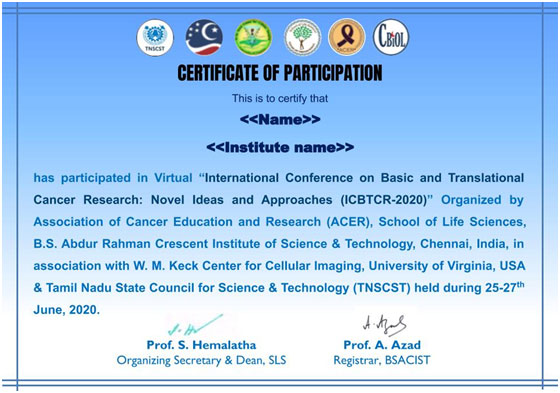
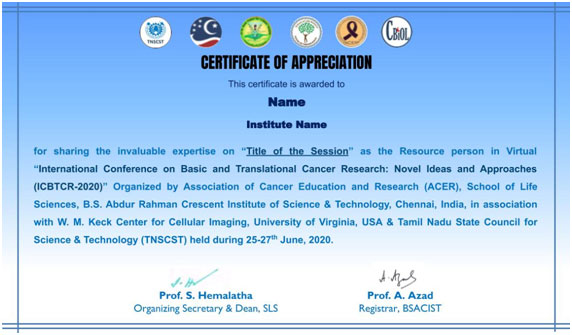
International seminar on Tropical medicinal plants and reproductive health
Date: 2nd November, 2022.
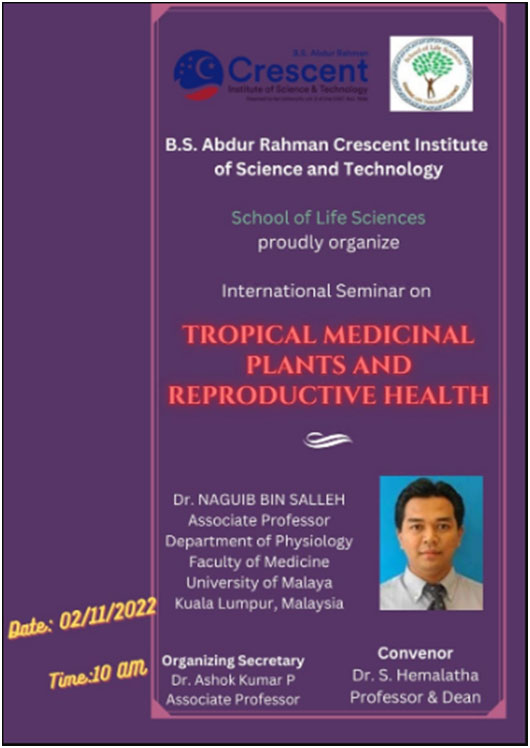
Virtual International Conference on “Basic and Translational Cancer Research: Novel Ideas and Approaches” (June 25 – 27, 2020)
School of Life Sciences & Association of Cancer Education and Research (ACER) in association with W.M. Keck Centre for Cellular Imaging, University of Virginia, USA and Tamil Nadu State Council for Science & Technology (TNSCST) jointly organized virtual International Conference on ‘Basic and Translational Cancer Research: Novel Ideas and Approaches’.
Keynote speakers from University of Virginia, Purdue University, University of Missouri, University of Massachusetts, CSIR-CLRI, Adyar, CSIR_CFTRI & Anand Diagnostic Laboratory.

Guest Lecture: September 2020, Universitas Atma Jaya Yogakarta, Indonesia
The below mentioned 5 faculty members of BSACIST delivered virtual guest lectures during September 2020 to the students of Atma Jaya Yogyakarta.
- Dr. Ayub Khan Dawood, Prof & Dean
- Dr. Aisha Banu W., Professor, CSE
- Dr. C. Tharini, Prof & Head, ECE
- Dr. S. Kaja Mohideen, Senior Prof & Director (PG Admissions)
- Dr. A. K. Kaliluthin, Associate Professor & Dy. Director (Campus Development & Maintenance)
Students of Universitas Atma Jaya Yigyakarta participated in this event.

Virtual International Cross Cultural Day 2020: (Sep 21-22, 2020) Universitas Atma Jaya Yogyakarta, Indonesia
BSACIST has actively participated during Virtual International Cross Cultural Day 2020: My culture is my life organized by the Universitas Atma Jaya Yogyakarta. Dr. D. Ayub Khan Dawood, Prof. & Dean, School of Social Science & Humanities, & Dr. Aisha Banu, Prof, CSE, BSACIST delivered virtual guest lecture. Dr. D. Ayub Khan Dawood, Prof. & Dean, School of Social Science & Humanities, BSACIST is a visiting professor & also involved in the development of teaching and learning process for 3 credit course on Cost Accounting.
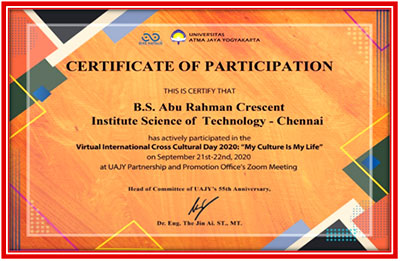

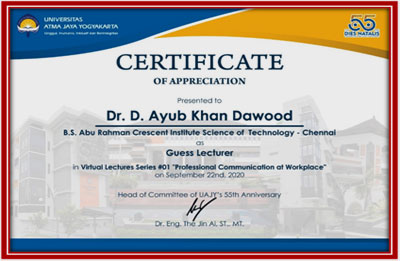
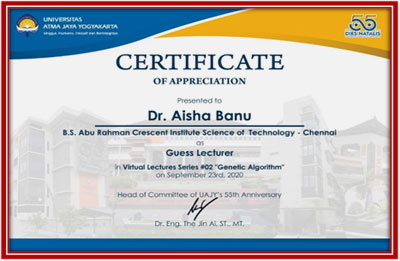
International Conference on Research Outlook, Innovations and Recent Trends (ICROIRT-2020) (Aug 29-30, 2020)
- 18 organizations organized the Virtual Conference in which 9 organizations were from Italy, Malaysia, Ukraine, Uzbekistan, Romania, Russian Federation and Philippines.
- 6 Profs and Deans of BSACIST were the Southern regional coordinators in the virtual international conference ICROIRT 2020
- The purpose was for brand building, networking and collaboration
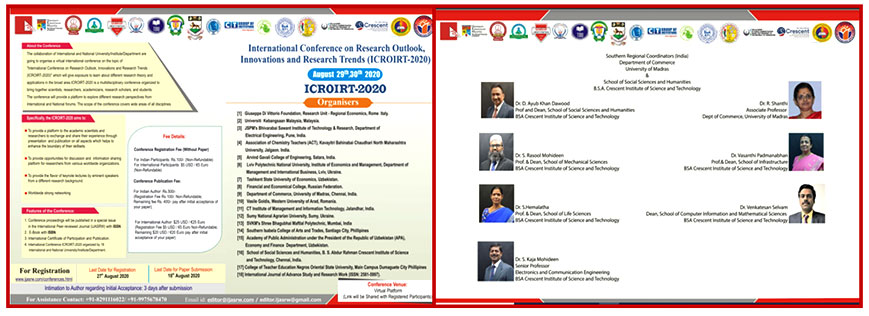
The B.S. Abdur Rahman Crescent Institute of Science and Technology, located in Chennai, has prepared students in India to pursue careers in engineering, science and technology for over 32 years. In addition to inspiring innovation among its students, the university has also chosen to improve its campus by adding green buildings. The new women’s residences and staff quarters have many green features that have all been implemented at no additional cost to the university. When utility bills are taken into consideration, the result is a positive sum gain.
The university has many green features such as solar hot water collectors and energy-saving lighting systems to reduce energy consumption, and UPVC windows to reduce embodied energy in materials. Located in a region that experiences frequent droughts and shortages of water, the university can also conserve its supply of water with the help of low-flow showerheads and faucets and dual flush water closets. The university hopes to use EDGE for future buildings on the campus, to further its resource-efficient and environmentally-friendly approach.
The B.S. Abdur Rahman Crescent Institute has received final EDGE certification from GBCI India.


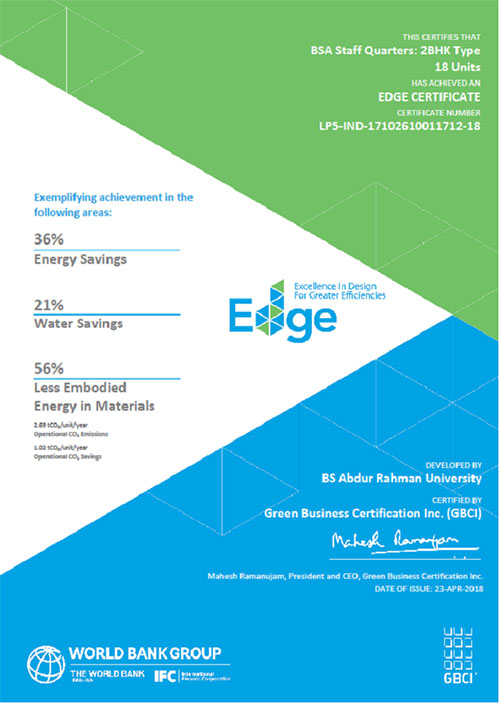

Engage in global partnerships with SDG Accord (https://www.sdgaccord.org/) aimed at collecting or assessing data relevant to the Sustainable Development Goals (SDGs). This involves actively participating in collaborative efforts that span international borders to contribute valuable information and insights crucial for advancing the objectives of the SDGs. International collaboration in data gathering and measurement enhances the comprehensiveness and accuracy of information, fostering a more robust understanding of the challenges and progress associated with sustainable development on a global scale.
Academic Year 2020-21
Edge Green Building Certification
The B.S. Abdur Rahman Crescent Institute of Science and Technology, located in Chennai, has prepared students in India to pursue careers in engineering, science and technology for over 32 years. In addition to inspiring innovation among its students, the university has also chosen to improve its campus by adding green buildings. The new women’s residences and staff quarters have many green features that have all been implemented at no additional cost to the university. When utility bills are taken into consideration, the result is a positive sum gain.
The university has many green features such as solar hot water collectors and energy-saving lighting systems to reduce energy consumption, and UPVC windows to reduce embodied energy in materials. Located in a region that experiences frequent droughts and shortages of water, the university can also conserve its supply of water with the help of low-flow showerheads and faucets and dual flush water closets. The university hopes to use EDGE for future buildings on the campus, to further its resource-efficient and environmentally-friendly approach.
The B.S. Abdur Rahman Crescent Institute has received final EDGE certification from GBCI India.




Continuous Ambient Air Quality Monitoring Station (CAAQMS)
Tamilnadu Pollution Control Board & B.S.Abdur Rahman Crescent Institute of Science & Technology Jointly organized and implemented Continuous Ambient Air Quality Monitoring Station (CAAQMS) in the Campus on 28th October 2020.
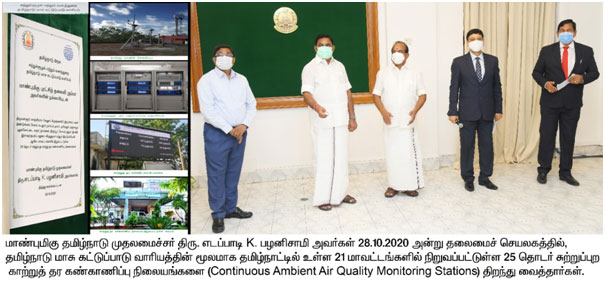
The Project was inaugurated by Mr. D.Vasudevan, District Environmental Engineer, Tamilnadu Pollution Control Board and Dr. A.Peer Mohamed, Pro Vice Chancellor & VC – In Charge. Dr. A.Azad, Registrar, AlhajV.N.A.Jalal, Senior General Manager, Dr. N.Raja Hussain, Deputy Registrar took part in the inauguration.

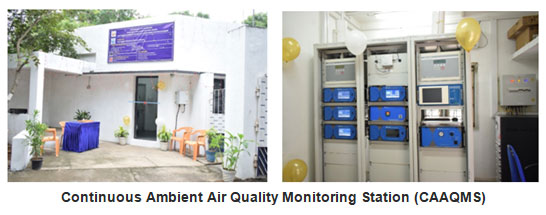
R World Institutional Ranking
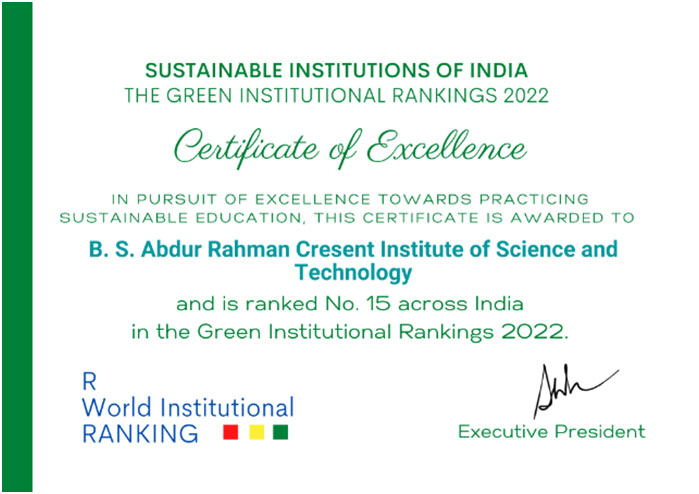

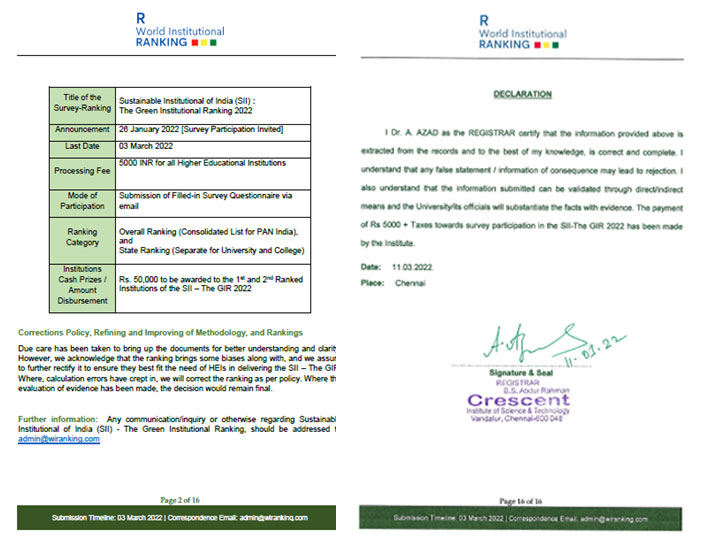
Recognized Social Entrepreneurship, Swachhta & Rural Engagement Cell (SES REC) Institution

![]()
https://crescent.bytdigital.com/wp-content/uploads/2022/11/R-World-Institutional-Ranking-2022.pdf
Envrionment-Green-Water Audit Report
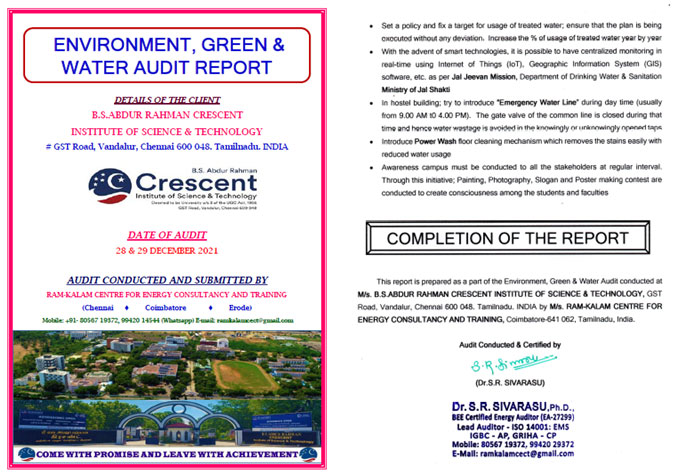
Atal Ranking of Institutions on Innovation Achievements (ARIIA)
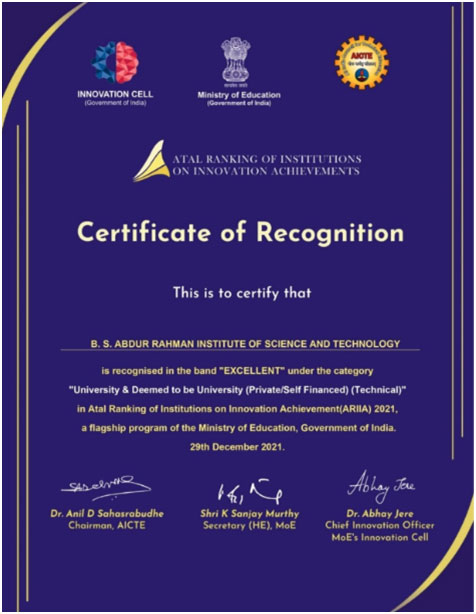
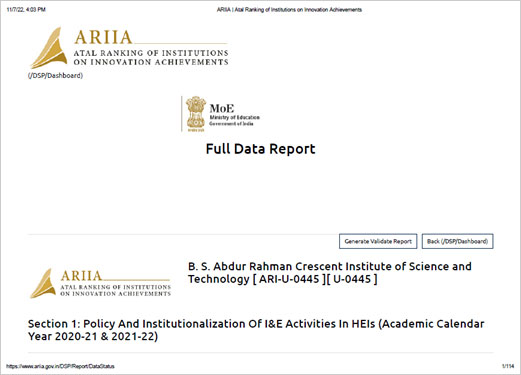
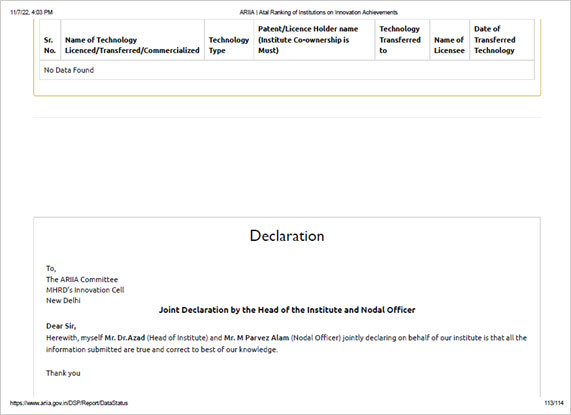
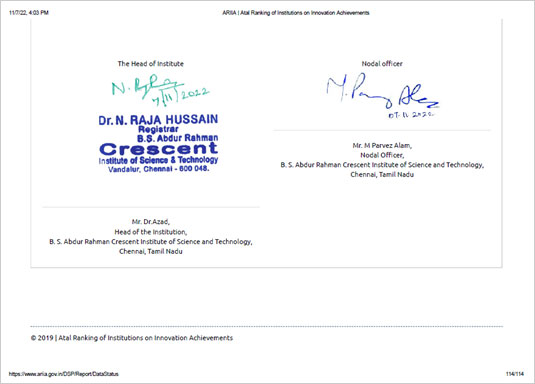
![]()
https://crescent.bytdigital.com/wp-content/uploads/2022/11/ARIIA-2022-Report.pdf
Title of the Practice: SUCCEED – Sustainability Centric Crescent Education for Entrepreneurship Development
To develop the best practice for the implementation of SDGs, MoU was signed with M/s Gibraltar Technologies, Dubai, on 5th November 2020. Several meetings were conducted School/Department-wise involving stakeholders such as faculty members, students and employees of Gibraltar Technologies (GT).
The meeting outcomes resulted in SUCCEED (Sustainability Centric Crescent Education for Entrepreneurship Development), the best practice for implementing SDGs.
Our faculty members and students are carrying out a few projects to address the SDGs in collaboration with GT are listed below.
To bring a holistic transformational change within societies, economies and the environment through sustainable centric education.
To develop and implement a curriculum intended to be flexible and non-prescriptive that follows a competency development model through a combination of knowledge, skills, values and attitudes.
To enable the delivery of the SDGs by ensuring that each learner has the relevant skills, knowledge, values and attitudes for social, economic and environmental development, and to work in partnership to create peaceful societies.
To ensure that all learners acquire the knowledge and skills needed to promote sustainable development by 2030 through education for sustainable development and sustainable lifestyles, human rights, gender equality, promotion of a culture of peace and non-violence, global citizenship and appreciation of cultural diversity and culture’s contribution to sustainable development.
Education is one of the Sustainable Development Goals (SDGs) in itself and as a catalyst for broader change.
Education is critical in shaping individual and collective knowledge, skills, values and attitudes to enable people to move along pathways towards sustainable development, and a catalyst for development itself. It is a key determinant of social and economic transformation, and an essential precursor to peace, tolerance and sustainability. Moreover, it equips learners of all ages with the knowledge, skills, values and attitudes needed to be responsible global citizens, such as respect for human rights, gender equality and environmental sustainability.
The purpose of the SDGs centric education is to develop successful learners, confident individuals, and responsible citizens who are resilient and uphold the core values and principles of the nation.
The curriculum encompasses learning content and outcomes, and shifts learning from being only content-driven to being outcome-driven, action-oriented and participatory. The aim is that all learners can become engaged in promoting the transformation required for sustainable development.
The curriculum deals with the knowledge, skills, attitudes and values in relation to each of the SDGs and outlines:
- The knowledge or content areas to be focused on, making provision for the inclusion of indigenous and traditional knowledge topics.
- The skills to be developed
- The values and attitudes that are desirable for the successful accomplishment of the learning outcome
At present, Core competencies required for sustainable development such as team building, communication, decision making, problem-solving, sense of community, self-esteem, personal responsibility, empathy, moral development, ethics, values, resilience and improved inclination for educational achievement are attained through few of the curricular courses and extension and outreach activities. Integrating the topic of the SDGs into a curriculum allows learners to understand their multiple identities, to work out what their roles should be for living together on a common planet and building a better future in an interdependent world at local, national and global levels.
The Crescent Innovation and Incubation Council (CIIC) encouraged the stakeholders (primarily the start-ups) to address the SDGs. As a result, our university’s faculty, students, and alumni created start-ups with the support of CIIC; 63 external start-ups, ten alumni start-ups, 14 faculty start-ups, and 26 student start-ups. Our university participated in the Times Higher Education (THE) Impact Ranking in 2020 and 2021 in the following SDGs: SDG 4: Quality Education, SDG 5: Gender Equity, SDG 6: Clean Water and Sanitation, SDG 7: Affordable and Clean Energy, SDG 9: Industry Innovation and Infrastructure and SDG 17: Partnership for the Goals. The rank bands are:
Our university participated in the following Green initiative award in 2019 and 2020.
Beema Bamboo is one of the fastest-growing plants on earth under tropical conditions. As a result, it will act as the best carbon sink for carbon-di-oxide emission, one of the major greenhouse gases that can be effectively and quickly brought down by the trees that grow fast by absorbing carbon-di-oxide. About 2000 Beema Bamboos were planted in the university campus during the last two years to reduce carbon footprint and help fight global warming. Our faculty members published quite a few papers in high-quality research journals addressing the SDGs. Complete compulsory courses relevant to the environment, ethics, human values and sustainability were introduced in the curriculum. In addition, about 10% of elective courses addressing the SDGs are offered to the students.
The development of the curriculum involved the identification and description of the competencies that learners should acquire, with an emphasis on the results of learning. In the context of the sustainability centric curriculum, the following was sought: a set of integrated competencies derived from the core competencies that learners need to develop for active and responsible participation in all relevant fields of life and to implement the SDGs, including empathy, ethics, compassionate values, and the ability to express social and environmental concerns and change behaviours. Integrated competencies and learning outcomes, specified in three categories – knowledge, skills, and values and attitudes, are adopted from “A Curriculum Framework for the Sustainable Development Goals – First Edition, Commonwealth, 2017” and “Education for Sustainable Development – Learning Objectives, UNESCO, 2017”.

Partnerships like the SDG Accord (https://www.sdgaccord.org/) and our university exemplify and join in assessing and enhancing our practices, fostering a collaborative approach to building best practices.

Crescent Line is the prestigious official Newsletter of the Institution. Started to connect all the stakeholders and well-wishers of our institution. Published as a monthly periodical with memories of the Crescent in Classic Crescent, potential articles on current topics, placement news, daily happenings of the institution, arts, and photos of faculties and students. Also, notify useful information related to government jobs and scholarship for the students.
https://crescent.bytdigital.com/crescent-line-2/
The Crescent Innovation and Incubation council (CIIC) https://ciic.ventures/ provides access to a range of resources and services, including facilities, equipment, and expertise, to tackle challenges and advance projects. Whether you represent a small or medium-sized enterprise, a large multinational corporation, a public sector entity, a charity, or a non-governmental organization, our experts are available to discuss and address your specific needs.
Our Incubators collaborate with regional and governmental organizations to develop policies that align with the United Nations Sustainability Development Goals (SDGs) https://ciic.ventures/wp-content/uploads/2023/04/113-CIIC-Startups-Compendium-compressed.pdf. Explore how our engagement spans various sectors and contributes to best practices in achieving SDGs through international collaborations. Our incubators actively participate in global initiatives, collecting data to drive progress toward the Goals. Much of our incubators are dedicated to addressing SDGs through partnerships with non-governmental organizations.
Yes. BSACIST have direct involvement in, or input into, national government or regional non-government organisations SDG policy development – including identifying problems and challenges, developing policies and strategies, modelling likely futures with and without interventions, monitoring and reporting on interventions, and enabling adaptive management.
https://crescent.bytdigital.com/iqac-csi-sdg17-2021-23/#rrng
Academic Year 2020-21
Best Practice
Title of the Practice: SUCCEED – Sustainability Centric Crescent Education for Entrepreneurship Development
To develop the best practice for the implementation of SDGs, MoU was signed with M/s Gibraltar Technologies, Dubai, on 5th November 2020. Several meetings were conducted School/Department-wise involving stakeholders such as faculty members, students and employees of Gibraltar Technologies (GT).
The meeting outcomes resulted in SUCCEED (Sustainability Centric Crescent Education for Entrepreneurship Development), the best practice for implementing SDGs.
Our faculty members and students are carrying out a few projects to address the SDGs in collaboration with GT are listed below.
Objectives of the Practice
To bring a holistic transformational change within societies, economies and the environment through sustainable centric education.
To develop and implement a curriculum intended to be flexible and non-prescriptive that follows a competency development model through a combination of knowledge, skills, values and attitudes.
To enable the delivery of the SDGs by ensuring that each learner has the relevant skills, knowledge, values and attitudes for social, economic and environmental development, and to work in partnership to create peaceful societies.
To ensure that all learners acquire the knowledge and skills needed to promote sustainable development by 2030 through education for sustainable development and sustainable lifestyles, human rights, gender equality, promotion of a culture of peace and non-violence, global citizenship and appreciation of cultural diversity and culture’s contribution to sustainable development.
The Context
Education is one of the Sustainable Development Goals (SDGs) in itself and as a catalyst for broader change.
Education is critical in shaping individual and collective knowledge, skills, values and attitudes to enable people to move along pathways towards sustainable development, and a catalyst for development itself. It is a key determinant of social and economic transformation, and an essential precursor to peace, tolerance and sustainability. Moreover, it equips learners of all ages with the knowledge, skills, values and attitudes needed to be responsible global citizens, such as respect for human rights, gender equality and environmental sustainability.
The purpose of the SDGs centric education is to develop successful learners, confident individuals, and responsible citizens who are resilient and uphold the core values and principles of the nation.
The Practice
The curriculum encompasses learning content and outcomes, and shifts learning from being only content-driven to being outcome-driven, action-oriented and participatory. The aim is that all learners can become engaged in promoting the transformation required for sustainable development.
The curriculum deals with the knowledge, skills, attitudes and values in relation to each of the SDGs and outlines:
1. The knowledge or content areas to be focused on, making provision for the inclusion of indigenous and traditional knowledge topics.
2. The skills to be developed.
3. The values and attitudes that are desirable for the successful accomplishment of the learning outcome.
At present, Core competencies required for sustainable development such as team building, communication, decision making, problem-solving, sense of community, self-esteem, personal responsibility, empathy, moral development, ethics, values, resilience and improved inclination for educational achievement are attained through few of the curricular courses and extension and outreach activities. Integrating the topic of the SDGs into a curriculum allows learners to understand their multiple identities, to work out what their roles should be for living together on a common planet and building a better future in an interdependent world at local, national and global levels.
Evidence of Success
The Crescent Innovation and Incubation Council (CIIC) encouraged the stakeholders (primarily the start-ups) to address the SDGs. As a result, our university’s faculty, students, and alumni created start-ups with the support of CIIC; 63 external start-ups, ten alumni start-ups, 14 faculty start-ups, and 26 student start-ups. Our university participated in the Times Higher Education (THE) Impact Ranking in 2020 and 2021 in the following SDGs: SDG 4: Quality Education, SDG 5: Gender Equity, SDG 6: Clean Water and Sanitation, SDG 7: Affordable and Clean Energy, SDG 9: Industry Innovation and Infrastructure and SDG 17: Partnership for the Goals. The rank bands are:
Our university participated in the following Green initiative award in 2019 and 2020.
Beema Bamboo is one of the fastest-growing plants on earth under tropical conditions. As a result, it will act as the best carbon sink for carbon-di-oxide emission, one of the major greenhouse gases that can be effectively and quickly brought down by the trees that grow fast by absorbing carbon-di-oxide. About 2000 Beema Bamboos were planted in the university campus during the last two years to reduce carbon footprint and help fight global warming. Our faculty members published quite a few papers in high-quality research journals addressing the SDGs. Complete compulsory courses relevant to the environment, ethics, human values and sustainability were introduced in the curriculum. In addition, about 10% of elective courses addressing the SDGs are offered to the students.
Problems Encountered and Resources Required
The development of the curriculum involved the identification and description of the competencies that learners should acquire, with an emphasis on the results of learning. In the context of the sustainability centric curriculum, the following was sought: a set of integrated competencies derived from the core competencies that learners need to develop for active and responsible participation in all relevant fields of life and to implement the SDGs, including empathy, ethics, compassionate values, and the ability to express social and environmental concerns and change behaviours. Integrated competencies and learning outcomes, specified in three categories – knowledge, skills, and values and attitudes, are adopted from “A Curriculum Framework for the Sustainable Development Goals – First Edition, Commonwealth, 2017” and “Education for Sustainable Development – Learning Objectives, UNESCO, 2017”.


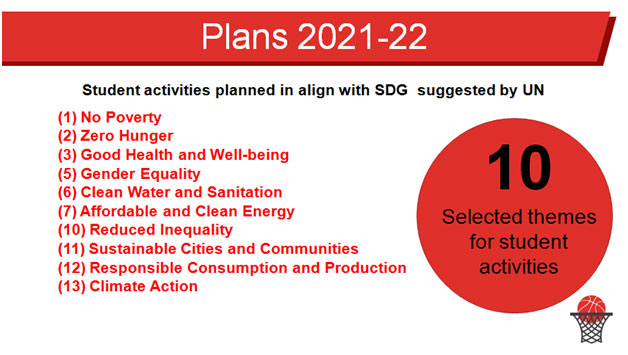
Crescent Line
Crescent Line is the prestigious official Newsletter of the Institution. Started to connect all the stakeholders and well-wishers of our institution. Published as a monthly periodical with memories of the Crescent in Classic Crescent, potential articles on current topics, placement news, daily happenings of the institution, arts, and photos of faculties and students. Also, notify useful information related to government jobs and scholarship for the students.
![]()
https://crescent.bytdigital.com/crescent-line-2/
MOU – Gibraltar Technologies – UAE
Memorandum of Agreement has been signed between BSACIST and Gibraltar Technologies, UAE
Dated: November 05, 2020
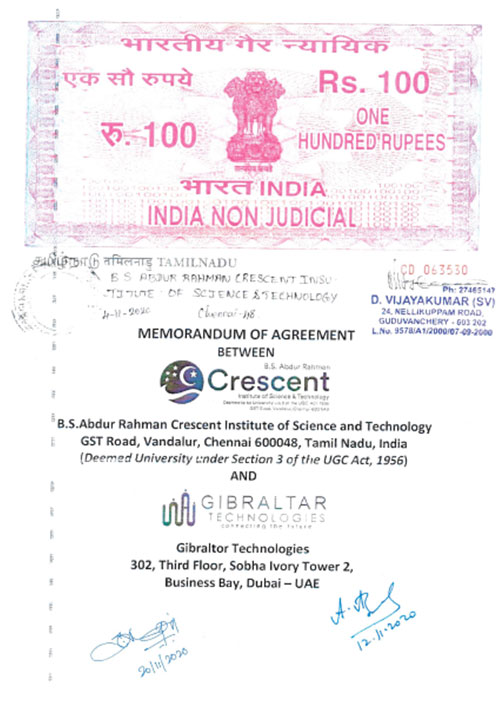

![]()
Gibralter – Industry Collaborative Projects
https://www.gt.technology/
SDG Best Practice – Start-ups
B. S. Abdur Rahman Crescent Institute of Science and Technology possesses one of the top Incubators in India- Crescent Innovation and Incubation Council (CIIC). The CIIC houses 120 start-ups from different sectors, such as Life Sciences, Industry 4.0, and Smart mobility and transportation. The CIIC builds and nurtures our society by nudging entrepreneurs with Integrity, Sustainability, and a Culture of innovation, a Triple ‘M’ Strategy (Mentor, Money, and Market). The CIIC encourages Start-ups to provide the solution for the SDG problem. The Start-ups are as follows:
![]()
https://www.facebook.com/ciicupdates/
| S. No | Startup Name (Incubatee) | Project Description | Startup Website URL (if available) | UN SDG number |
|---|---|---|---|---|
| 1 | Kankyo Cleantech (India) Pvt Ltd | An environmental technology and EPC firm, providing turnkey solutions in water &waste water treatment | http://www.kankyo.global/ | 7 |
| 2 | Kankyo Bert Pvt Ltd. | Developing patented methanol gasification tehnology that transforms a carbon based material into synthesis gas (Syngas) | www.kanyo-bert.com | 7 |
| 3 | Rekindle Automations Pvt Ltd | Rekindle Automations is a healthcare basedstartup with the vision to increase safety of the patients by making the hospitals more Intelligent | www.rekindleautomations.com | 3 |
| 4 | Wegot Utility Solution Pvt Ltd | Providing a low cost, high precision, data driven IoT based water management solution that solves the impending water crisis by reducing water consumption. | https://www.wegot.in/ | 6, 12 |
| 5 | Medcuore Medical solutions | Developing eco-centric AI-IoT integrated smart alert indoor air quality monitor & advanced anti-microbial nanoparticulate carbon-metallic ion six stage purifier with photocatalytic oxidation technology | www.medcuore.com | 3, 11 |
| 6 | Aatrel | Providing solutions to reduce Carbon dioxide emission through algal technologies | aatrel.in | 13, 15 |
| 7 | Acadicell Innovations International Pvt Ltd. | Offers Stem cell-based research & training, and also involved in research on molecular diagnostics | WWW.ACADICELL.COM | 3 |
| 8 | Accelerd Sciences | Predictive toxicity screening of small molecules in non-animal models i e. C. elegans for accelerating drug discovery | NIL | 3 |
| 9 | Careme Health | Creates a digital health care delivery system and provides direct patient care via telemedicine | https://careme.health/ | 3 |
| 10 | Claco Pvt Ltd | R&D: A well-designed research facility for the development of impactful technological advancements to support educational system and caters to Industry 4.0 L&D: Team of expert professionals combined with judicious engineering workforce provides offers programs in cutting-edge Technological domain –– Project based leaning –– From Primary Education to College Students and Working Professionals. | https://fliarbi.com/legalities/claco-private-limited/u80904tn2021ptc143399/ | 4 |
![]()
Our University partner with non-governmental organisations (NGOs) to address the Sustainable Development Goals (SDGs) by engaging in student volunteering initiatives, research programs, or the creation of educational resources. This collaboration involves working closely with NGOs to leverage the collective efforts of students in volunteer programs, conducting research that contributes to SDG-related objectives, and developing educational materials that enhance awareness and understanding of sustainable development issues. By collaborating with NGOs in these various capacities, institutions can play a crucial role in advancing the SDGs and promoting a holistic approach to global development.
https://crescent.bytdigital.com/iqac-csi-sdg7-2021-23/#pct
(i) Dr. N. Ayyanathan, Professor, BSACIST member in INTACH NGO

https://intachmadurai.org/members-3/
Student Affairs – Annual Report 2021-22
NSS Report – 2021-22
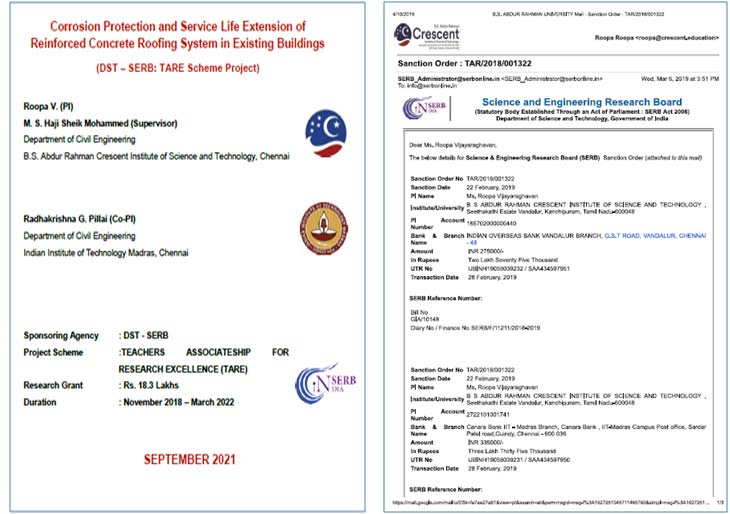
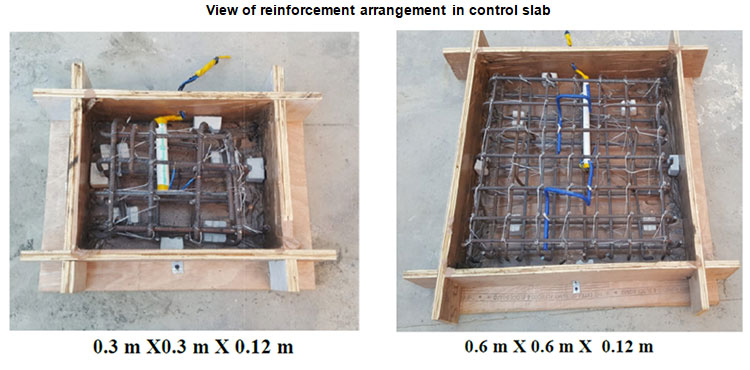
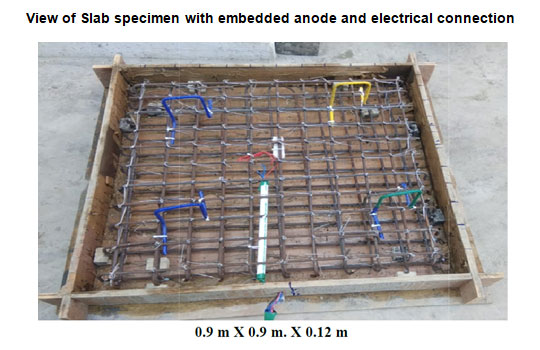
![]()
https://crescent.bytdigital.com/wp-content/uploads/2022/11/3.-TARE-Project-September-2021_V2.pdf
Academic Year 2020-21

REPORT ON PLANTING CEREMONY
On the occasion of 75th Independence Day
Report of the Event:
On the occasion of 75th Independence day, our institution organized an event on tree plantation in collaboration with Government of Tamilnadu and Social Work Team Trust (SWOTT). The District Collector and Magistrate was invited there as a chief guest. Our staff and students actively participated in the ceremony and carried out the plantation of palm seed in and around Thiruvalluvar District along with the volunteers of Social Work Team Trust (SWOTT) and Public Works Department. The ceremony started with prayer.
The program aimed to plant about 75000 palm seeds saplings in and around Thiruvallur district. The forestry coordinator guided students on how to sow seeds and plants. Teachers also participated in that event to help students. At first, we started to implant seedlings along the central road of the district and then along all sides of the main ground. After that, the students also planted in the local areas nearby. Some charts and banners were also designed by the students relevant to tree plantation. These posters were hung there to raise awareness in the people about the needs of tree plantations. Finally, the event ended with an plantation of seed to conserve the ecosystem.
Crescent student volunteering with NGO Social Work Team Trust (SWOTT) to promote sustainable development activities

Collaboration with Saranalayam Old Age Home
Department of Electronics and Communication Engineering
| Name of the Scheme | Corporate Social Responsibility (CSR) scheme |
| Funded By | Jasmin Infotech Pvt Ltd, Chennai |
| Client | Saranalayam Old Age Home, Mannivakkam , Chennai |
| Project Implementation | Department of ECE, B.S.Abdur Rahman Crescent Institute of Science & Technology (BSACIST), Chennai. |
| SDGs Addressed | SDG 3, SDG 7, SDG 9, SDG 10 |
The department of ECE received the fund Rs 1.5 Lakh from Jasmin Infotech Pvt Ltd Chennai under CSR scheme to implement the project titled “Digital Assistance to Saranalayam old age Home”.
Interaction with Saranalayam old age Home
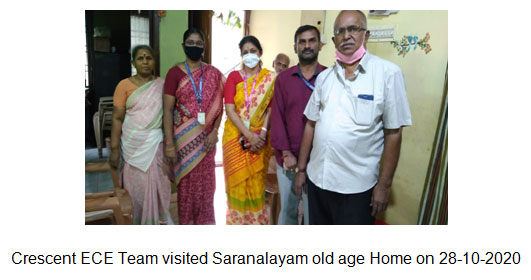
Crescent Team: Dr C.Tharini, Professor & Head, BSACIST, Dr G Kannan, Associate Professor, BSACIST, Ms Padma Usha, Asst Professor (Sr.Grade), BSACIST
Interaction with : Thiru. J.Manikumar, Managing Trustee, Saranalayam, Ms N.Nithya, Care Taker, Saranalayam
Based on the interaction with Saranalayam old age home administrator and care taker the following projects were implemented.
Implementation of Surveillance Cameras in Saranalayam Old age Home with support of Social technical Services club students of ECE department.


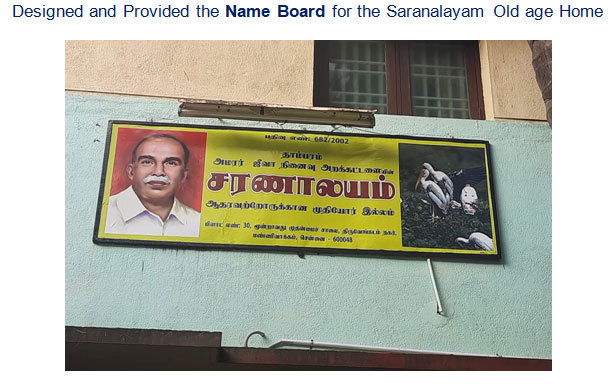
Implementation of Automatic Water Level Controller with the help of our student team along with faculty mentor of B.S.Abdur Rahman Crescent Institute of Science & Technology.


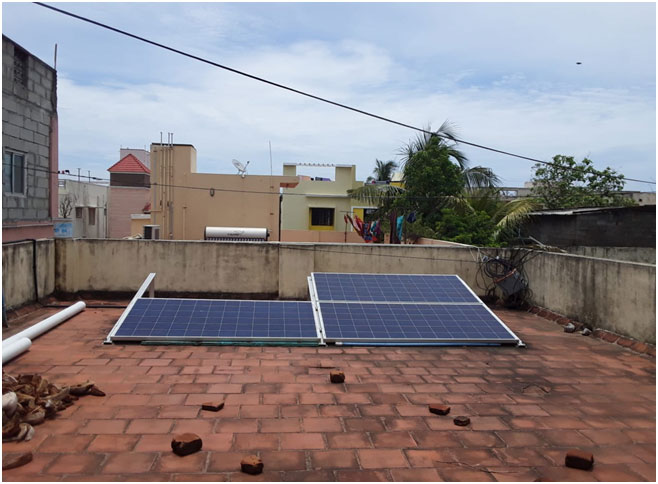

The department of ECE is very much thankful to the Jasmin Infotech Pvt Ltd, for the continuous support and guidance

Collaborate with NGOs to tackle the SDGs through research programmes – SDG7, SDG9, SDG11 & SDG12
Evaluation of Sacrificial Anode Cathodic Protection (SACP) Systems for Reinforced Concrete Applications
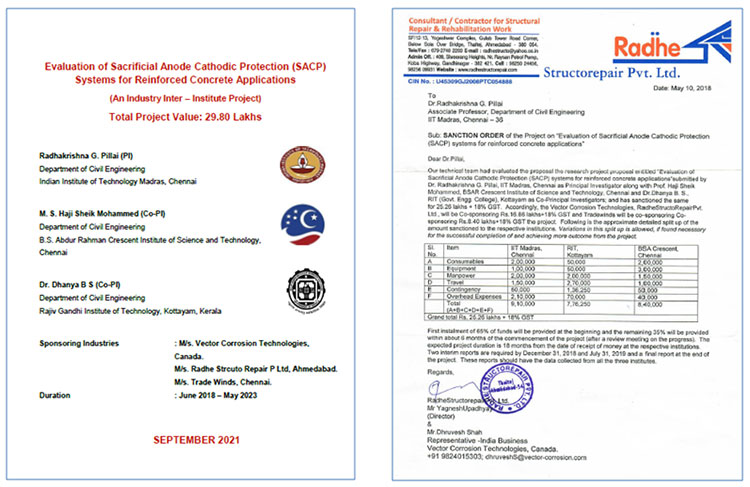

![]()
https://crescent.bytdigital.com/wp-content/uploads/2022/11/1.-SACP-Project-September-2021_V2.pdf
Structural Behavior of Corroding Prestressed Concrete (PSC) Systems and Extension of Service Life Using Cathodic Protection


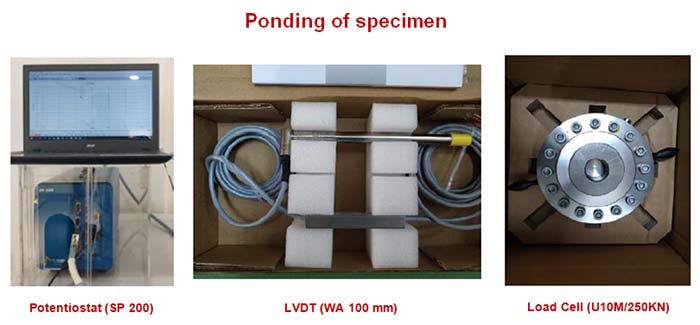
![]()
https://crescent.bytdigital.com/wp-content/uploads/2022/11/2.-DST-SERB-September-2021_V2.pdf
Corrosion Protection and Service Life Extension of Reinforced Concrete Roofing System in Existing Buildings



![]()
https://crescent.bytdigital.com/wp-content/uploads/2022/11/3.-TARE-Project-September-2021_V2.pdf
Rotaract Club of Crescent

![]()
- View – Rotaract Annual Report
- View – Student Affairs – Annual report 2019-2020
- View – Student Affairs – Annual report 2020-2021
- View – Student Affairs – Annual report 2021-2022
Police Commemoration Program – Tree Plantation Drive & Tribute to the Martyred Policemen

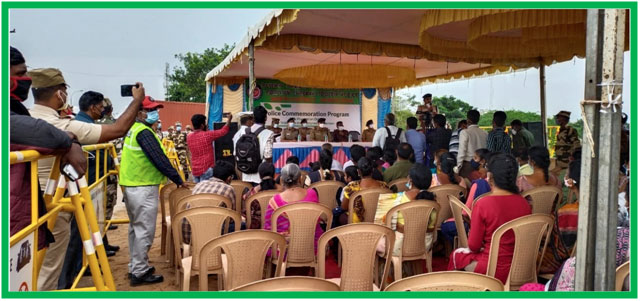
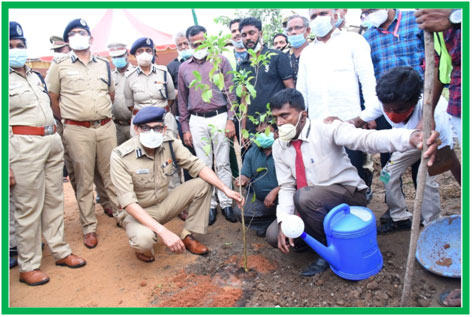
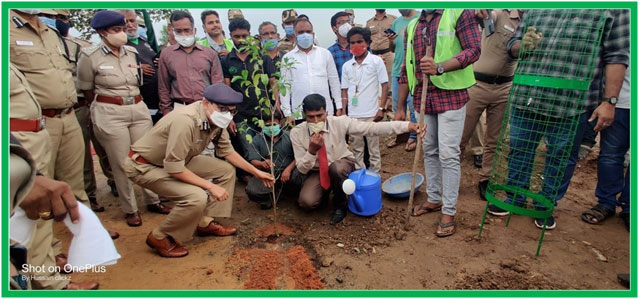

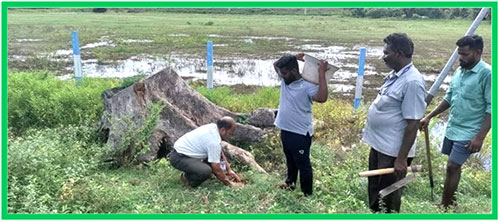

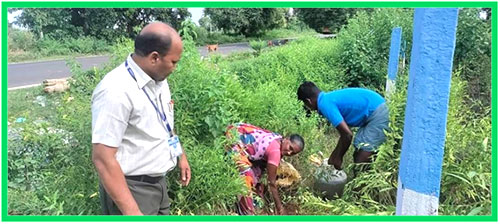



BSA CRESCENT – SUSTAINABILITY REPORT

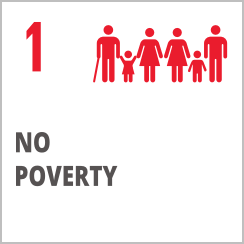
| 4 to 5 | There is significant progress in effective implementation compared to the previous year |
| 3 to 4 | The necessary processes/activities (Support to students based on income, assistance to local start-ups) have been implemented |
| 2 to 3 | There is an explicit plan to address the ‘No Poverty’ and necessitated processes have been initiated |
| 1 to 2 | There is an understanding and willingness to contribute effectively for achieving the UN targets of SDG 1 |
| 0 to 1 | There is no/partial willingness and plan to contribute for achieving the UN targets of SDG 1 No Poverty |
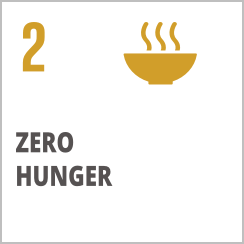
| 4 to 5 | There is significant progress in effective implementation compared to the previous year |
| 3 to 4 | The necessary processes/activities (Food waste tracking, nutritious and affordable food, food security) have been implemented |
| 2 to 3 | There is an explicit plan to address the ‘Zero Hunger’ and necessitated processes have been initiated |
| 1 to 2 | There is an understanding and willingness to contribute effectively for achieving the UN targets of SDG 2 |
| 0 to 1 | There is no/partial willingness and plan to contribute for achieving the UN targets of SDG 2 Zero Hunger |

| 4 to 5 | There is significant progress in effective implementation compared to the previous year |
| 3 to 4 | The necessary processes/activities (Programmes related to the health profession, collaborations with health institutions, Health outreach programmes, Shared sports facilities, healthcare support) have been implemented |
| 2 to 3 | There is an explicit plan to address the ‘Good Health and Well-being’ and necessitated processes have been initiated |
| 1 to 2 | There is an understanding and willingness to contribute effectively for achieving the UN targets of SDG 3 |
| 0 to 1 | There is no/partial willingness and plan to contribute for achieving the UN targets of SDG 3 Good Health and Well-being |
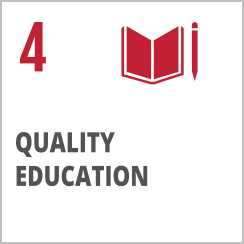
| 4 to 5 | There is significant progress in effective implementation compared to the previous year |
| 3 to 4 | The necessary processes/activities (Graduates with teaching qualification, Lifelong learning measures, admitting first-generation students) have been implemented |
| 2 to 3 | There is an explicit plan to address the ‘Quality Education’ and necessitated processes have been initiated |
| 1 to 2 | There is an understanding and willingness to contribute effectively for achieving the UN targets of SDG 4 |
| 0 to 1 | There is no/partial willingness and plan to contribute for achieving the UN targets of SDG 4 Quality Education |

| 4 to 5 | There is significant progress in effective implementation compared to the previous year |
| 3 to 4 | The necessary processes/activities (First-generation female students, Student access measures, Women in senior roles, Graduation of female students, Women’s progress measures) have been implemented |
| 2 to 3 | There is an explicit plan to address the ‘Gender Equality’ and necessitated processes have been initiated |
| 1 to 2 | There is an understanding and willingness to contribute effectively for achieving the UN targets of SDG 5 |
| 0 to 1 | There is no/partial willingness and plan to contribute for achieving the UN targets of SDG 5 Gender Equality |
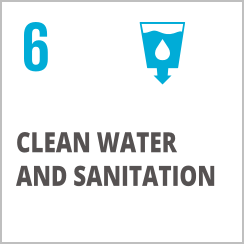
| 4 to 5 | There is significant progress in effective implementation compared to the previous year |
| 3 to 4 | The necessary processes/activities (Water consumption tracking, Water usage and care, Water reuse, Water management) have been implemented |
| 2 to 3 | There is an explicit plan to address the ‘Clean Water and Sanitation’ and necessitated processes have been initiated |
| 1 to 2 | There is an understanding and willingness to contribute effectively for achieving the UN targets of SDG 6 |
| 0 to 1 | There is no/partial willingness and plan to contribute for achieving the UN targets of SDG 6 Clean Water and Sanitation |
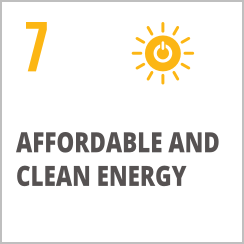
| 4 to 5 | There is significant progress in effective implementation compared to the previous year |
| 3 to 4 | The necessary processes/activities (Energy-efficient renovation and building, Energy use density, Renewable energy, Outreach activities) have been implemented |
| 2 to 3 | There is an explicit plan to address the ‘Affordable and Clean Energy’ and necessitated processes have been initiated |
| 1 to 2 | There is an understanding and willingness to contribute effectively for achieving the UN targets of SDG 7 |
| 0 to 1 | There is no/partial willingness and plan to contribute for achieving the UN targets of SDG 7 Affordable and Clean Energy |
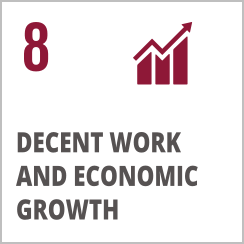
| 4 to 5 | There is significant progress in effective implementation compared to the previous year |
| 3 to 4 | The necessary processes/activities (Employment practice, Expenditure per employee, Students’ placement, ) have been implemented |
| 2 to 3 | There is an explicit plan to address the ‘Decent Work and Economic Growth’ and necessitated processes have been initiated |
| 1 to 2 | There is an understanding and willingness to contribute effectively for achieving the UN targets of SDG 8 |
| 0 to 1 | There is no/partial willingness and plan to contribute for achieving the UN targets of SDG 8 Decent Work and Economic Growth |
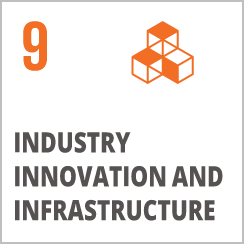
| 4 to 5 | There is significant progress in effective implementation compared to the previous year |
| 3 to 4 | The necessary processes/activities (University spin offs, Research income from industry and commerce) have been implemented |
| 2 to 3 | There is an explicit plan to address the ‘Industry, Innovation and Infrastructure’ and necessitated processes have been initiated |
| 1 to 2 | There is an understanding and willingness to contribute effectively for achieving the UN targets of SDG 9 |
| 0 to 1 | There is no/partial willingness and plan to contribute for achieving the UN targets of SDG 9 Industry, Innovation and Infrastructure |
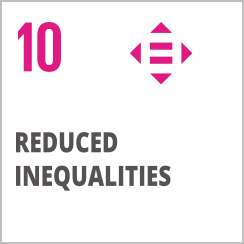
| 4 to 5 | There is significant progress in effective implementation compared to the previous year |
| 3 to 4 | The necessary processes/activities (First-generation students, International students from developing countries, Students and employees with disabilities, Measures against discrimination) have been implemented |
| 2 to 3 | There is an explicit plan to address the ‘Reduced Inequalities’ and necessitated processes have been initiated |
| 1 to 2 | There is an understanding and willingness to contribute effectively for achieving the UN targets of SDG 10 |
| 0 to 1 | There is no/partial willingness and plan to contribute for achieving the UN targets of SDG 10 Reduced Inequalities |
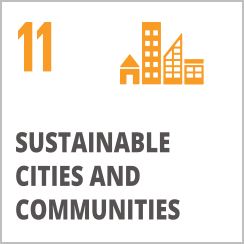
| 4 to 5 | There is significant progress in effective implementation compared to the previous year |
| 3 to 4 | The necessary processes/activities (Support and expenditure on arts and heritage, sustainable transportation and housing) have been implemented |
| 2 to 3 | There is an explicit plan to address the ‘Sustainable Cities and Communities’ and necessitated processes have been initiated |
| 1 to 2 | There is an understanding and willingness to contribute effectively for achieving the UN targets of SDG 11 |
| 0 to 1 | There is no/partial willingness and plan to contribute for achieving the UN targets of SDG 11 Sustainable Cities and Communities |
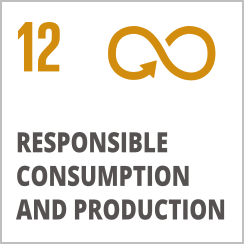
| 4 to 5 | There is significant progress in effective implementation compared to the previous year |
| 3 to 4 | The necessary processes/activities (Responsible consumption and production, Waste recycling, Publication of a sustainability report) have been implemented |
| 2 to 3 | There is an explicit plan to address the ‘Responsible Consumption and Production’ and necessitated processes have been initiated |
| 1 to 2 | There is an understanding and willingness to contribute effectively for achieving the UN targets of SDG 12 |
| 0 to 1 | There is no/partial willingness and plan to contribute for achieving the UN targets of SDG 12 Responsible Consumption and Production |
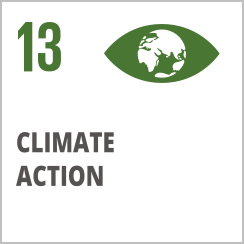
| 4 to 5 | There is significant progress in effective implementation compared to the previous year |
| 3 to 4 | The necessary processes/activities (Low-carbon energy use, Environmental education measures, Commitment to carbon neutral campus) have been implemented |
| 2 to 3 | There is an explicit plan to address the ‘Climate Action’ and necessitated processes have been initiated |
| 1 to 2 | There is an understanding and willingness to contribute effectively for achieving the UN targets of SDG 13 |
| 0 to 1 | There is no/partial willingness and plan to contribute for achieving the UN targets of SDG 13 Climate Action |

| 4 to 5 | There is significant progress in effective implementation compared to the previous year |
| 3 to 4 | The necessary processes/activities (Supporting aquatic ecosystems through education and action, Water sensitive waste disposal, Maintaining a local ecosystem) have been implemented |
| 2 to 3 | There is an explicit plan to address the ‘Life Below Water’ and necessitated processes have been initiated |
| 1 to 2 | There is an understanding and willingness to contribute effectively for achieving the UN targets of SDG 14 |
| 0 to 1 | There is no/partial willingness and plan to contribute for achieving the UN targets of SDG 14 Life Below Water |
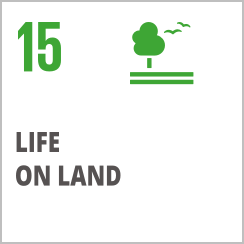
| 4 to 5 | There is significant progress in effective implementation compared to the previous year |
| 3 to 4 | The necessary processes/activities (Supporting land ecosystems through education and action, Land sensitive waste disposal) have been implemented |
| 2 to 3 | There is an explicit plan to address the ‘Life On Land’ and necessitated processes have been initiated |
| 1 to 2 | There is an understanding and willingness to contribute effectively for achieving the UN targets of SDG 15 |
| 0 to 1 | There is no/partial willingness and plan to contribute for achieving the UN targets of SDG 15 Life On Land |

| 4 to 5 | There is significant progress in effective implementation compared to the previous year |
| 3 to 4 | The necessary processes/activities (University governance measures, Stakeholder engagement, University principles on corruption and bribery, Working with government, Graduates in law and civil enforcement) have been implemented |
| 2 to 3 | There is an explicit plan to address the ‘Peace, Justice and Strong Institutions’ and necessitated processes have been initiated |
| 1 to 2 | There is an understanding and willingness to contribute effectively for achieving the UN targets of SDG 16 |
| 0 to 1 | There is no/partial willingness and plan to contribute for achieving the UN targets of SDG 16 Peace, Justice and Strong Institutions |
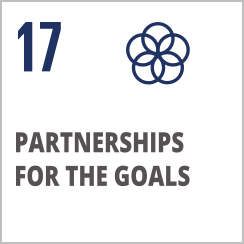
| 4 to 5 | There is significant progress in effective implementation compared to the previous year |
| 3 to 4 | The necessary processes/activities (Relationships with regional NGOs and government for SDG policy, Publication of SDG reports, Education for the SDGs) have been implemented |
| 2 to 3 | There is an explicit plan to address the ‘Partnerships for the goals’ and necessitated processes have been initiated |
| 1 to 2 | There is an understanding and willingness to contribute effectively for achieving the UN targets of SDG 17 |
| 0 to 1 | There is no/partial willingness and plan to contribute for achieving the UN targets of SDG 17 Partnerships for the goals |
Engage in global partnerships with SDG Accord (https://www.sdgaccord.org/) aimed at collecting or assessing data relevant to the Sustainable Development Goals (SDGs). This involves actively participating in collaborative efforts that span international borders to contribute valuable information and insights crucial for advancing the objectives of the SDGs. International collaboration in data gathering and measurement enhances the comprehensiveness and accuracy of information, fostering a more robust understanding of the challenges and progress associated with sustainable development on a global scale.
Academic Year 2020-21
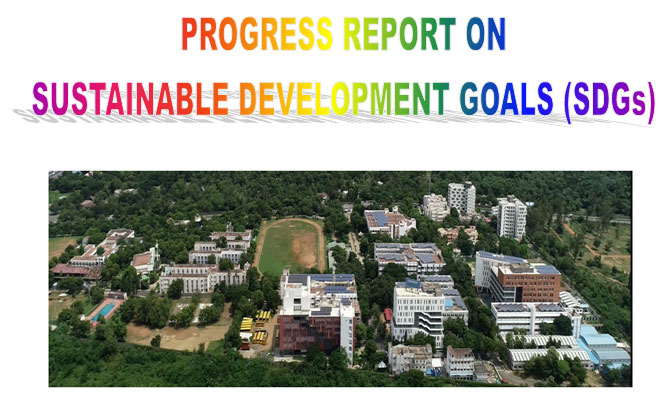
by
The Office of Director (IQAC)
Period : Three Years (2019, 2020 & 2021)
![]()
Progress Report on SDGs for the Period – 2019 to 2021
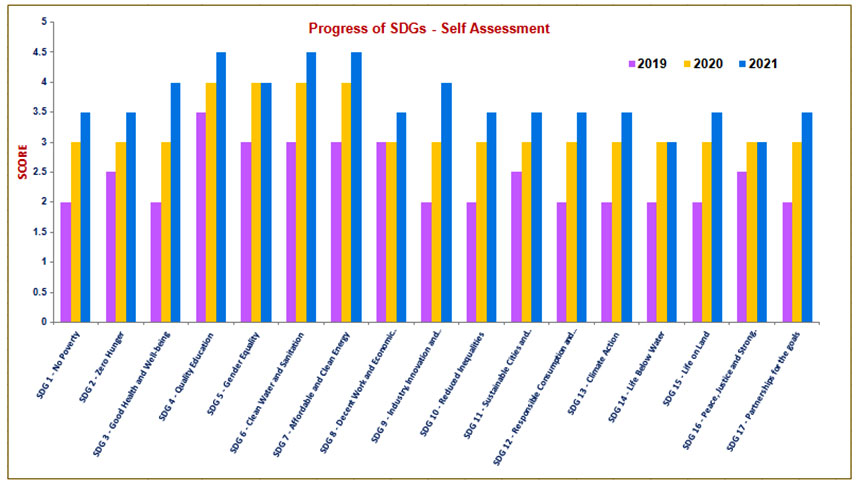
Rubrics for Assessing the Progress of Sustainable Development Goals (SDGs)

| 4 to 5 | There is significant progress in effective implementation compared to the previous year |
| 3 to 4 | The necessary processes/activities (Support to students based on income, assistance to local start-ups) have been implemented |
| 2 to 3 | There is an explicit plan to address the ‘No Poverty’ and necessitated processes have been initiated |
| 1 to 2 | There is an understanding and willingness to contribute effectively for achieving the UN targets of SDG 1 |
| 0 to 1 | There is no/partial willingness and plan to contribute for achieving the UN targets of SDG 1 No Poverty |

| 4 to 5 | There is significant progress in effective implementation compared to the previous year |
| 3 to 4 | The necessary processes/activities (Food waste tracking, nutritious and affordable food, food security) have been implemented |
| 2 to 3 | There is an explicit plan to address the ‘Zero Hunger’ and necessitated processes have been initiated |
| 1 to 2 | There is an understanding and willingness to contribute effectively for achieving the UN targets of SDG 2 |
| 0 to 1 | There is no/partial willingness and plan to contribute for achieving the UN targets of SDG 2 Zero Hunger |

| 4 to 5 | There is significant progress in effective implementation compared to the previous year |
| 3 to 4 | The necessary processes/activities (Programmes related to the health profession, collaborations with health institutions, Health outreach programmes, Shared sports facilities, healthcare support) have been implemented |
| 2 to 3 | There is an explicit plan to address the ‘Good Health and Well-being’ and necessitated processes have been initiated |
| 1 to 2 | There is an understanding and willingness to contribute effectively for achieving the UN targets of SDG 3 |
| 0 to 1 | There is no/partial willingness and plan to contribute for achieving the UN targets of SDG 3 Good Health and Well-being |

| 4 to 5 | There is significant progress in effective implementation compared to the previous year |
| 3 to 4 | The necessary processes/activities (Graduates with teaching qualification, Lifelong learning measures, admitting first-generation students) have been implemented |
| 2 to 3 | There is an explicit plan to address the ‘Quality Education’ and necessitated processes have been initiated |
| 1 to 2 | There is an understanding and willingness to contribute effectively for achieving the UN targets of SDG 4 |
| 0 to 1 | There is no/partial willingness and plan to contribute for achieving the UN targets of SDG 4 Quality Education |

| 4 to 5 | There is significant progress in effective implementation compared to the previous year |
| 3 to 4 | The necessary processes/activities (First-generation female students, Student access measures, Women in senior roles, Graduation of female students, Women’s progress measures) have been implemented |
| 2 to 3 | There is an explicit plan to address the ‘Gender Equality’ and necessitated processes have been initiated |
| 1 to 2 | There is an understanding and willingness to contribute effectively for achieving the UN targets of SDG 5 |
| 0 to 1 | There is no/partial willingness and plan to contribute for achieving the UN targets of SDG 5 Gender Equality |

| 4 to 5 | There is significant progress in effective implementation compared to the previous year |
| 3 to 4 | The necessary processes/activities (Water consumption tracking, Water usage and care, Water reuse, Water management) have been implemented |
| 2 to 3 | There is an explicit plan to address the ‘Clean Water and Sanitation’ and necessitated processes have been initiated |
| 1 to 2 | There is an understanding and willingness to contribute effectively for achieving the UN targets of SDG 6 |
| 0 to 1 | There is no/partial willingness and plan to contribute for achieving the UN targets of SDG 6 Clean Water and Sanitation |

| 4 to 5 | There is significant progress in effective implementation compared to the previous year |
| 3 to 4 | The necessary processes/activities (Energy-efficient renovation and building, Energy use density, Renewable energy, Outreach activities) have been implemented |
| 2 to 3 | There is an explicit plan to address the ‘Affordable and Clean Energy’ and necessitated processes have been initiated |
| 1 to 2 | There is an understanding and willingness to contribute effectively for achieving the UN targets of SDG 7 |
| 0 to 1 | There is no/partial willingness and plan to contribute for achieving the UN targets of SDG 7 Affordable and Clean Energy |

| 4 to 5 | There is significant progress in effective implementation compared to the previous year |
| 3 to 4 | The necessary processes/activities (Employment practice, Expenditure per employee, Students’ placement, ) have been implemented |
| 2 to 3 | There is an explicit plan to address the ‘Decent Work and Economic Growth’ and necessitated processes have been initiated |
| 1 to 2 | There is an understanding and willingness to contribute effectively for achieving the UN targets of SDG 8 |
| 0 to 1 | There is no/partial willingness and plan to contribute for achieving the UN targets of SDG 8 Decent Work and Economic Growth |

| 4 to 5 | There is significant progress in effective implementation compared to the previous year |
| 3 to 4 | The necessary processes/activities (University spin offs, Research income from industry and commerce) have been implemented |
| 2 to 3 | There is an explicit plan to address the ‘Industry, Innovation and Infrastructure’ and necessitated processes have been initiated |
| 1 to 2 | There is an understanding and willingness to contribute effectively for achieving the UN targets of SDG 9 |
| 0 to 1 | There is no/partial willingness and plan to contribute for achieving the UN targets of SDG 9 Industry, Innovation and Infrastructure |

| 4 to 5 | There is significant progress in effective implementation compared to the previous year |
| 3 to 4 | The necessary processes/activities (First-generation students, International students from developing countries, Students and employees with disabilities, Measures against discrimination) have been implemented |
| 2 to 3 | There is an explicit plan to address the ‘Reduced Inequalities’ and necessitated processes have been initiated |
| 1 to 2 | There is an understanding and willingness to contribute effectively for achieving the UN targets of SDG 10 |
| 0 to 1 | There is no/partial willingness and plan to contribute for achieving the UN targets of SDG 10 Reduced Inequalities |

| 4 to 5 | There is significant progress in effective implementation compared to the previous year |
| 3 to 4 | The necessary processes/activities (Support and expenditure on arts and heritage, sustainable transportation and housing) have been implemented |
| 2 to 3 | There is an explicit plan to address the ‘Sustainable Cities and Communities’ and necessitated processes have been initiated |
| 1 to 2 | There is an understanding and willingness to contribute effectively for achieving the UN targets of SDG 11 |
| 0 to 1 | There is no/partial willingness and plan to contribute for achieving the UN targets of SDG 11 Sustainable Cities and Communities |

| 4 to 5 | There is significant progress in effective implementation compared to the previous year |
| 3 to 4 | The necessary processes/activities (Responsible consumption and production, Waste recycling, Publication of a sustainability report) have been implemented |
| 2 to 3 | There is an explicit plan to address the ‘Responsible Consumption and Production’ and necessitated processes have been initiated |
| 1 to 2 | There is an understanding and willingness to contribute effectively for achieving the UN targets of SDG 12 |
| 0 to 1 | There is no/partial willingness and plan to contribute for achieving the UN targets of SDG 12 Responsible Consumption and Production |

| 4 to 5 | There is significant progress in effective implementation compared to the previous year |
| 3 to 4 | The necessary processes/activities (Low-carbon energy use, Environmental education measures, Commitment to carbon neutral campus) have been implemented |
| 2 to 3 | There is an explicit plan to address the ‘Climate Action’ and necessitated processes have been initiated |
| 1 to 2 | There is an understanding and willingness to contribute effectively for achieving the UN targets of SDG 13 |
| 0 to 1 | There is no/partial willingness and plan to contribute for achieving the UN targets of SDG 13 Climate Action |

| 4 to 5 | There is significant progress in effective implementation compared to the previous year |
| 3 to 4 | The necessary processes/activities (Supporting aquatic ecosystems through education and action, Water sensitive waste disposal, Maintaining a local ecosystem) have been implemented |
| 2 to 3 | There is an explicit plan to address the ‘Life Below Water’ and necessitated processes have been initiated |
| 1 to 2 | There is an understanding and willingness to contribute effectively for achieving the UN targets of SDG 14 |
| 0 to 1 | There is no/partial willingness and plan to contribute for achieving the UN targets of SDG 14 Life Below Water |

| 4 to 5 | There is significant progress in effective implementation compared to the previous year |
| 3 to 4 | The necessary processes/activities (Supporting land ecosystems through education and action, Land sensitive waste disposal) have been implemented |
| 2 to 3 | There is an explicit plan to address the ‘Life On Land’ and necessitated processes have been initiated |
| 1 to 2 | There is an understanding and willingness to contribute effectively for achieving the UN targets of SDG 15 |
| 0 to 1 | There is no/partial willingness and plan to contribute for achieving the UN targets of SDG 15 Life On Land |

| 4 to 5 | There is significant progress in effective implementation compared to the previous year |
| 3 to 4 | The necessary processes/activities (University governance measures, Stakeholder engagement, University principles on corruption and bribery, Working with government, Graduates in law and civil enforcement) have been implemented |
| 2 to 3 | There is an explicit plan to address the ‘Peace, Justice and Strong Institutions’ and necessitated processes have been initiated |
| 1 to 2 | There is an understanding and willingness to contribute effectively for achieving the UN targets of SDG 16 |
| 0 to 1 | There is no/partial willingness and plan to contribute for achieving the UN targets of SDG 16 Peace, Justice and Strong Institutions |

| 4 to 5 | There is significant progress in effective implementation compared to the previous year |
| 3 to 4 | The necessary processes/activities (Relationships with regional NGOs and government for SDG policy, Publication of SDG reports, Education for the SDGs) have been implemented |
| 2 to 3 | There is an explicit plan to address the ‘Partnerships for the goals’ and necessitated processes have been initiated |
| 1 to 2 | There is an understanding and willingness to contribute effectively for achieving the UN targets of SDG 17 |
| 0 to 1 | There is no/partial willingness and plan to contribute for achieving the UN targets of SDG 17 Partnerships for the goals |
B.S. Abdur Rahman Crescent Institute of Science and Technology has been following outcome-based education since 2013 and adopted the graduate attributes of the National Board of Accreditation (NBA), New Delhi, which is a signatory member of the Washington Accord. Our curriculum of each undergraduate and postgraduate degree program is designed by following an outcome-based framework and Commonwealth curriculum framework for Sustainable Development goals. The revised graduate attributes of WA are:

| Differentiating Characteristic | Engineer Graduate |
|---|---|
| Engineering Knowledge: Breadth, depth and type of knowledge, both theoretical and practical | WA1: Apply knowledge of mathematics, natural science, computing and engineering fundamentals, and an engineering specialization as specified in WK1 to WK4 respectively to develop solutions to complex engineering problems |
| Problem Analysis Complexity of analysis | WA2: Identify, formulate, research literature and analyze complex engineering problems reaching substantiated conclusions using first principles of mathematics, natural sciences and engineering sciences with holistic considerations for sustainable development* (WK1 to WK4) |
| Design/developm ent of solutions: Breadth and uniqueness of engineering problems i.e., the extent to which problems are original and to which solutions have not previously been identified or codified | WA3: Design creative solutions for complex engineering problems and design systems, components or processes to meet identified needs with appropriate consideration for public health and safety, whole-life cost, net zero carbon as well as resource, cultural, societal, and environmental considerations as required (WK5) |
| Investigation: Breadth and depth of investigation and experimentation | WA4: Conduct investigations of complex engineering problems using research methods including research- based knowledge, design of experiments, analysis and interpretation of data, and synthesis of information to provide valid conclusions (WK8) |
| Tool Usage: Level of understanding of the appropriateness of technologies and tools | WA5: Create, select and apply, and recognize limitations of appropriate techniques, resources, and modern engineering and IT tools, including prediction and modelling, to complex engineering problems (WK2 and WK6) |
| The Engineer and the World: Level of knowledge and responsibility for sustainable development | WA6: When solving complex engineering problems, analyze and evaluate sustainable development impacts* to: society, the economy, sustainability, health and safety, legal frameworks, and the environment (WK1, WK5, and WK7) |
| Ethics: Understanding and level of practice | WA7: Apply ethical principles and commit to professional ethics and norms of engineering practice and adhere to relevant national and international laws. Demonstrate an understanding of the need for diversity and inclusion (WK9) |
| Individual and Collaborative Team work: Role in and diversity of team | WA8: Function effectively as an individual, and as a member or leader in diverse and inclusive teams and in multi-disciplinary, face-to-face, remote and distributed settings (WK9) |
| Communication: Level of communication according to type of activities performed | WA9: Communicate effectively and inclusively on complex engineering activities with the engineering community and with society at large, such as being able to comprehend and write effective reports and design documentation, make effective presentations, taking into account cultural, language, and learning differences. |
| Project Management and Finance: Level of management required for differing types of activity | WA10: Apply knowledge and understanding of engineering management principles and economic decision-making and apply these to one’s own work, as a member and leader in a team, and to manage projects and in multidisciplinary environments. |
| Lifelong learning: Duration and manner | WA11: Recognize the need for, and have the preparation and ability for i) independent and life-long learning ii) adaptability to new and emerging technologies and iii) critical thinking in the broadest context of technological change (WK8) |
| *Represented by the 17 UN Sustainable Development Goals (UN-SDG) | |
Aim of the Curriculum Framework
The Curriculum Framework is intended to be a flexible, non-prescriptive tool that follows a competency development model through a combination of knowledge, skills, values and attitudes. It also aims to enable the delivery of the SDGs by ensuring that each population has the relevant skills, knowledge, values and attitudes for social, economic and environmental development, and to work in partnership to create peaceful societies.
The Curriculum Framework can support the design, delivery and evaluation of national curricula across the Commonwealth, set the foundations for research and development, provide consistency across programmes for achieving the SDGs, and support the creation of learning and evaluation tools to align with the framework.
This framework will guide degree programmes in defining their contextual needs and the basic requirements related to competencies that must be demonstrated or acquired in order to achieve the objectives of the SDGs through education.
The framework includes the following three components, which make up the competencies that learners develop (i.e. integrated competencies that consist of an interrelated set of competencies including foundational knowledge): (1) knowledge, (2) skills, and (3) values and attitudes. Appropriate knowledge and understanding provide fundamental opportunities for skills development and sharing of values and attitudes, while values and attitudes enable skills to be successfully deployed within the knowledge context.
Purpose of the Curriculum Framework
The purpose of the framework is to develop successful learners, confident individuals, and responsible citizens who are resilient and uphold the core values and principles
Core competencies
Sustainable development depends critically on the competencies of all citizens to cover knowledge, skills, values and attitudes that build on individual capacity. These include team building, communication, decision making, problem solving, sense of community, self-esteem, personal responsibility, empathy, moral development, ethics, values, resilience and improved inclination for educational achievement.
Alongside traditional learning outcomes, core competencies for achieving the SDGs are:
- Envisioning – being able to imagine a better future. The premise is that when we know where we want to go, we will be better able to work out how to get there. The objective is to establish a link between long-term goals and immediate actions, and to motivate people to take action by harnessing their deep aspirations. Under this competency, key elements are: – identifying relevance and meaning to different people; – exploring how to achieve change; – offering direction and inspiration to take action; and – taking ownership of visions, processes and outcomes.
- Critical thinking and reflection – learning to question our current belief systems and to recognise the assumptions underlying our knowledge, perspectives and opinions. Critical thinking helps people learn to examine economic, environmental, social and cultural structures in the context of sustainable development, and challenges people to examine and question the underlying assumptions that influence their world views by having them reflect on unsustainable practices. Critical thinking leads to confidence in addressing the dilemmas and challenges of sustainable development. It encompasses the knowledge, skills and processes associated with intellectual development. Under this competency, key elements are: – developing the ability to participate in change; – providing a new perspective; – promoting alternative ways of thinking; and – developing metacognitive awareness.
- Systemic thinking – acknowledging complexities and looking for links and synergies when trying to find solutions to problems. Systemic thinking helps us recognise that the whole is more than the sum of its parts, and it is a better way to understand and manage complex situations. Under this competency, key elements are: – shifts in thinking from ‘things’ to wholes, and linking these to ‘processes’ and functions – understanding the nature of feedback and how feedback affects system behaviour; and – integrating decision-making and adaptive management techniques
- Building partnerships – promoting dialogue and negotiation, learning to work together so as to strengthen ownership of and commitment to sustainable action through education and learning. Under this competency, key elements are: – building a shared vision among a diverse range of stakeholders; – motivating and adding value to initiatives; and – communicating, imparting and exchanging information.
- Participation in decision-making – empowering oneself and others. This means being involved and involving people in joint analysis, planning and control of local decisions. Under this competency, key elements are: – decision-making and responsibility for outcomes; – a greater sense of ownership of and commitment to responsible action; – building capacity for self-reliance and self-organisation; and – empowering individuals to take action. Competencies relate to an aggregation of corresponding cognitive and practical skills, knowledge, motivation, values and ethics, attitudes, emotions, and other social and behavioural components that can be pulled together to achieve an aim in a specific setting (Rychen and Tiana 2004). According to the Institute of Electrical and Electronics Engineers (IEEE) reusable competency definition, a competency is defined as any form of knowledge, skill, attitude, ability or educational objective that can be described in a context of learning, education or training: ‘The goal of most learning, education and training is to acquire skills, knowledge and ability, i.e. competencies. Recognizing and validating the competencies that individuals have or should acquire are also fundamental to staffing, recruiting, credentialing, personal advancement, workforce development, curriculum development and policy making.
Methodology and review process
The methodology and review process for developing the Curriculum Framework entailed a number of phases: a literature review, including available national curricula, and consultative processes with member countries and relevant experts and partners. These included several technical workshops, as well as internal cross-divisional discussions and feedback.
Integrated competencies and learning outcomes are specified in three categories – knowledge, skills, and values and attitudes are shown in Figure.

The framework is developed as a matrix model with indicative core competencies that could be used to map the 17 SDGs (or as an auditing tool for the 17 SDGs).
Curriculum Framework mapping: overview
The following tables describe how education across all levels can shape learning outcomes, applying the competencies-based methodology. Each SDG is broken down to illustrate how this systematic methodology can be applied at technical/higher education and across all SDGs for the development of engaged global citizens, driven to support the achievement of the SDGs.
![]()
References:
https://www.ieagreements.org/assets/Uploads/IEA-Graduate-Attributes-and-Professional-Competencies-2021.1-Sept-2021.pdf
https://www.greenwich.edu.pk/images/PDFs/CFSDG_UPDF-003.pdf
Goal 1 – No Poverty
| Knowledge and understanding | Skills and applications | Values and attitudes | |
|---|---|---|---|
| TVET |
|
|
|
| Tertiary education |
|
|
|
Goal 2 – Zero Hunger
| Knowledge and understanding | Skills and applications | Values and attitudes | |
|---|---|---|---|
| TVET |
|
|
|
| Tertiary education |
|
|
|
Goal 3 – Good Health and Well-being
| Knowledge and understanding | Skills and applications | Values and attitudes | |
|---|---|---|---|
| TVET |
|
|
|
| Tertiary education |
|
|
|
Goal 4 – Quality Education
| Knowledge and understanding | Skills and applications | Values and attitudes | |
|---|---|---|---|
| TVET |
|
|
|
| Tertiary education |
|
|
|
|
|
|
Goal 5 – Gender Equality
| Knowledge and understanding | Skills and applications | Values and attitudes | |
|---|---|---|---|
| TVET |
|
|
|
| Tertiary education |
|
|
|
Goal 6 – Clean Water and Sanitation
| Knowledge and understanding | Skills and applications | Values and attitudes | |
|---|---|---|---|
| TVET |
|
|
|
| Tertiary education |
|
|
|
Goal 7 – Affordable and Clean Energy
| Knowledge and understanding | Skills and applications | Values and attitudes | |
|---|---|---|---|
| TVET |
|
|
|
| Tertiary education |
|
|
|
Goal 8 – Decent Work and Economic Growth
| Knowledge and understanding | Skills and applications | Values and attitudes | |
|---|---|---|---|
| TVET |
|
|
|
|
|
| |
|
|
| |
| Tertiary education |
|
|
|
Goal 9 – Industry, Innovation and Infrastructure
| Knowledge and understanding | Skills and applications | Values and attitudes | |
|---|---|---|---|
| TVET |
|
|
|
|
|
|
|
Goal 10 – Reduced Inequalities
| Knowledge and understanding | Skills and applications | Values and attitudes | |
|---|---|---|---|
| TVET |
|
|
|
| Tertiary education |
|
|
|
Goal 11 – Sustainable Cities and Communities
| Knowledge and understanding | Skills and applications | Values and attitudes | |
|---|---|---|---|
| TVET |
|
|
|
|
|
| |
|
|
| |
| Tertiary education |
|
|
|
|
|
| |
|
|
|
Goal 12 – Responsible Consumption and Production
| Knowledge and understanding | Skills and applications | Values and attitudes | |
|---|---|---|---|
| TVET |
|
|
|
| Tertiary education |
|
|
|
|
|
|
Goal 13 – Climate Action
| Knowledge and understanding | Skills and applications | Values and attitudes | |
|---|---|---|---|
| TVET |
|
|
|
| Tertiary education |
|
|
|
Goal 14 – Life below Water
| Knowledge and understanding | Skills and applications | Values and attitudes | |
|---|---|---|---|
| TVET |
|
|
|
| Tertiary education |
|
|
|
|
|
|
Goal 15 – Life on Land
| Knowledge and understanding | Skills and applications | Values and attitudes | |
|---|---|---|---|
| TVET |
|
|
|
| Tertiary education |
|
|
|
|
|
|
Goal 16 – Peace, Justice and Strong Institutions
| Knowledge and understanding | Skills and applications | Values and attitudes | |
|---|---|---|---|
| TVET |
|
|
|
|
|
| |
| Tertiary education |
|
|
|
|
|
| |
|
|
| |
|
|
|
Goal 17 – Partnership for the Goals
| Knowledge and understanding | Skills and applications | Values and attitudes | |
|---|---|---|---|
| TVET |
|
|
|
| Tertiary education |
|
|
|
COMMITMENT TO MEANINGFUL EDUCATION AROUND THE SDGs ACROSS THE UNIVERSITY
B.S. Abdur Rahman Crescent Institute of Science and Technology initiated its curriculum for teaching the next generation to adopt sustainability in their Professional Career and in their personal lives. Targeted to commit a meaningful education around the SDGs, all the UG and PG programmes offered by this institute are framed and mapped with SDGs. Some of the sample courses for selected programmes are shown below. The detailed version of the curriculum and syllabi, which are mapped with SDGs is uploaded in the Institute Website and the links for the same are given below.
| S. No. | Course Code | Course Name | L | T | P | C | Mapped with SDG |
|---|---|---|---|---|---|---|---|
| 1 | CHD1181 | ENGINEERING MATERIALS AND APPLICATIONS | 3 | 0 | 2 | 4 | 9 |
| 2 | GED 1101 | ENGINEERING GRAPHICS | 2 | 0 | 2 | 3 | 9 |
| 4 | GED 1104 | PROGRAMMING FOR PROBLEM SOLVING | 1 | 0 | 2 | 2 | 8 |
| 5 | END 1281 | ENGLISH FOR ENGINEERS | 3 | 0 | 0 | 3 | 4 |
| 6 | GED 1202 | BASIC ELECTRICAL AND ELECTRONICS ENGINEERING | 3 | 0 | 2 | 4 | 3, 8, 12 |
| 7 | GED 1206 | ENVIRONMENTAL SCIENCES | 2 | 0 | 0 | 2 | 3, 5, 6, 7, 13 |
| 8 | GED 2101 | ESSENTIAL SKILLS AND APTITUDE FOR ENGINEER | 0 | 0 | 2 | 1 | 17 |
| 9 | GED 2201 | WORKPLACE SKILLS AND APTITUDE FOR ENGINEERS | 0 | 0 | 2 | 1 | 8 |
| 10 | GED 2202 | INDIAN CONSTITUTION AND HUMAN RIGHTS | 2 | 0 | 0 | 2 | 16 |
![]()
Weblink for the entire Curriculum and Syllabus :
https://crescent.bytdigital.com/wp-content/uploads/2022/06/Dean-AA-B.Tech_.-Mechanical-R2021-CS-Amended-upto-Feb.2022-23.05.22.pdf
| GED 2201 | WORKPLACE SKILLS AND APTITUDE FOR ENGINEERS | L | T | P | C |
| SDG: 8 | 0 | 0 | 2 | 1 | |
| COURSE OBJECTIVES: | |||||
| COB1:To expose them to reading for specific purposes, especially in professional contexts | |||||
| COB2:To expose them to the process of different kinds of formal writing | |||||
| COB3:To prepare the students to be successful in their career | |||||
| COB4:To familiarize various problem-solving techniques in aptitude and puzzles. | |||||
| MODULE I | EXTENSIVE READING & WRITING | 07 | |||
| Reading for comprehension – inferring and note-making – Process of writing- paragraph development – elements of business writing: Email, memos. | |||||
| MODULE II | INTENSIVE READING & WRITING | 08 | |||
| Intensive reading and reviewing – Interpretation of charts, graphs – Résumé – Letter of enquiry, thanksgiving letters. | |||||
| MODULE III | QUANTITATIVE APTITUDE | 08 | |||
| Percentage – Ratio and Proportion – Profit and Loss – Averages, Allegations and Mixtures. | |||||
| MODULE IV | LOGICAL COMPETENCY | 07 | |||
| Syllogism – Blood Relations- Number, Alpha and Alpha numeric series – Puzzles – Cubes and Dice – Odd One Out-Coding and Decoding | |||||
| L – 30; TOTAL HOURS – 30 | |||||
| REFERENCES: | |||||
| 1. Sharma, R.C. and Mohan, Krishna (2010). Business Correspondence and Report Writing. 4th edition. Tata McGraw Hill Education Private Limited, New Delhi 2. Whitby, Norman (2014). Business Benchmark: Pre-Intermediate to Intermediate. Cambridge University Press, UK 3. Tyra .M, Magical Book On Quicker Maths, BSC Publishing Company Pvt. Limited, 2009 4. R. S. Aggarwal , Quantitative Aptitude for Competitive Examinations, S. Chand Limited, 2017 5. R. S. Aggarwal , A Modern Approach to Verbal & Non-Verbal | |||||
| SDG 8:Promote sustained, inclusive and sustainable economic growth, full and productive employment and decent work for all. | |||||
| GED 2202 | INDIAN CONSTITUTION AND HUMAN RIGHTS | L | T | P | C |
| SDG: 16 | 2 | 0 | 0 | 0 | |
| COURSE OBJECTIVES: | |||||
| COB1: To explicate the emergence and evolution of Indian Constitution. | |||||
| COB2: To have an insight into the philosophy of fundamental rights and duties, and Directive Principles. | |||||
| COB3: To differentiate the structure of executive, legislature and judiciary. | |||||
| COB4: To understand human rights and its implication – local and international and redressal mechanism. | |||||
| MODULE I | INTRODUCTION AND BASIC INFORMATION ABOUT INDIAN CONSTITUTION | 8 | |||
| Meaning of the constitution law and constitutionalism – Historical Background of the Constituent Assembly – Government of India Act of 1935 and Indian Independence Act of 1947 – The Constituent Assembly of India – Enforcement of the Constitution – Indian Constitution and its Salient Features – The Preamble of the Constitution. Citizenship. | |||||
| MODULE II | FUNDAMENTAL RIGHTS, DUTIES AND DIRECTIVE PRINCIPLES | 7 | |||
| Fundamental Rights and its Restriction and limitations in different complex situations – Directive Principles of State Policy (DPSP) & its present relevance in our society with examples- Fundamental Duties and its Scope and significance in nation building – Right to Information Act 2005. | |||||
| MODULE III | GOVERNANCE IN INDIA | 8 | |||
| The Union Executive – the President and the Vice-President – The Council of Ministers and the Prime Minister – Powers and functions. The Union legislature – The Parliament – The Lok Sabha and the Rajya Sabha, Composition, powers and functions – Government of the State – The Governor – the Council of Ministers and the Chief Minister – Powers and Functions-Elections-Electoral Process and Election Commission of India – Indian judicial system. | |||||
| MODULE IV | HUMAN RIGHTS AND INDIAN CONSTITUTION | 7 | |||
| Human rights – meaning and significance – Covenant on civil and political rights – Covenant on Economic, Social and Cultural rights – UN mechanism and agencies – The Protection of Human Rights Act, 1993 – watch on human rights and enforcement – Roles of National Human Rights | |||||
| Commission of India – Special Constitutional Provisions for SC & ST, OBC – Special Provision for Women, Children & Backward Classes. | |||||
| L – 30; TOTAL HOURS –30 | |||||
| TEXT BOOKS: | |||||
| 1. B.K. Sharma, Introduction to the Constitution of India, 6th ed., PHI Learning Private Limited, New Delhi 2011 2. Durga Das Basu ―Introduction to the Constitution on India‖, (Students Edition.) Prentice –Hall EEE, 19th / 20th Edn. 2008 3. M.P. Jain, Indian Constitutional Law, 7th ed., LexisNexis, Gurgaon. 2014. | |||||
| COURSE OUTCOMES: At the end of the course, the students will be able to | |||||
| CO1: describe the emergence and evolution of Indian Constitution. | |||||
| CO2: realize the status and importance of fundamental rights, fundamental duties and directive principles of state policy and relation among them by understanding the articulation of its basic value under the Constitution of India. | |||||
| CO3: compare the various structure of Indian government. | |||||
| CO4: recognize the human rights, cultural, social and political rights and its relationship with Indian constitution. . | |||||
| Board of Studies (BoS) : 4th BoS of SSSH held on 28.06.2021 | Academic Council: 17th AC held on 15.07.2021 |
| PO1 | PO2 | PO3 | PO4 | PO5 | PO6 | PO7 | PO8 | PO9 | PO 10 | PO11 | PO 12 | |
| CO1 | M | H | M | L | M | M | ||||||
| CO2 | H | M | H | M | H | |||||||
| CO3 | M | H | M | L | L | |||||||
| CO4 | H | H | H | M | M | H |
Note: L – Low Correlation M – Medium Correlation H – High Correlation
| SDG 16: Promote peaceful and inclusive societies for sustainable development, provide access to justice for all and build effective, accountable and inclusive institutions at all levels |
| Application of human, legal and political rights leading to empowerment in real-life situations for protection of fundamental freedoms and freedom from violence, abuse, trafficking and exploitation are at the core of human rights. |
| S. No. | Course Code | Course Name | L | T | P | C | Mapped with SDG |
|---|---|---|---|---|---|---|---|
| 1 | PHD 1183 | MECHANICS OF SOLIDS | 3 | 0 | 2 | 4 | 4 |
| 2 | CHD 1181 | ENGINEERING MATERIALS AND APPLICATIONS | 3 | 0 | 2 | 4 | 9 |
| 3 | CED 2101 | MECHANICS OF STRUCTURES | 3 | 0 | 0 | 3 | 9, 11 |
| 4 | CED 2102 | MECHANICS OF FLUIDS | 3 | 0 | 0 | 3 | 6 |
| 5 | CED 2103 | CONCRETE TECHNOLOGY | 3 | 0 | 0 | 3 | 11 |
| 6 | CED 2104 | WATER AND WASTEWATER ENGINEERING | 3 | 0 | 2 | 4 | 6 |
| 7 | CED 2106 | CONCRETE AND HIGHWAY LABORATORY | 0 | 0 | 2 | 1 | 11 |
| 8 | GED 2101 | ESSENTIAL SKILLS AND APTITUDE FOR ENGINEERS | 0 | 0 | 2 | 1 | 17 |
| 9 | CED 2204 | ESTIMATION AND COSTING OF INFRASTRUCTURE PROJECTS | 2 | 0 | 2 | 3 | 8 |
| 10 | CED 2206 | SURVEY AND SOIL INVESTIGATION CAMP | 0 | 0 | 2 | 1 | 11 |
![]()
Weblink for the entire Curriculum and Syllabus :
https://crescent.bytdigital.com/wp-content/uploads/2022/08/Dean-AA-B.Tech_.-Civil-R2021-CSAmended-upto-Feb.2022-12.08.22.pdf
| PHD 1183 | MECHANICS OF SOLIDS (For Civil Engineering) | L | T | P | C |
| SDG: 4 | 3 | 0 | 2 | 4 | |
| COURSE OBJECTIVES: The objectives of the course are to impart knowledge on | |||||
| COB1: the basic concepts of stresses, strains and deformation due to internal forces | |||||
| COB2: the principal stresses, strains and theories of failure | |||||
| COB3: theory of torsion and stresses and deformation in circular and hallow shafts. | |||||
| COB4: concept of stresses in thin cylinders and spheres with its application. | |||||
| COB5: concept of stresses and strains in thick cylinders | |||||
| MODULE I | PROPERTIES OF MATERIALS | 9 | ||||
| Introduction – stress – Types of stress – strain – Types of strain – Poisson’s ratio –Hooke’s Law – Elastic constants and their relationship – Volumetric Strain – Plastic deformation of metals; Tensile test – standards for different material (brittle, quasi-brittle, elastic and ductile) – True stress – strain interpretation of tensile test; and hardness of materials; | ||||||
| MODULE II | SIMPLE & COMPOUND STRESSES AND STRAINS | 9 | ||||
| Deformation of simple and compound bars – Bar with uniform and varying section – Thermal Stresses – Principal Stresses, strain and maximum shear stresses – Mohr’s Circle for Plane stress – Principal theories of failure for a member subjected to biaxial stress. | ||||||
| MODULE III | TORSION | 9 | ||||
| Theory of simple torsion – Stresses and deformation in circular and hollow shafts – Stepped shafts – Shafts fixed at both ends – Stresses and deflection of Leaf springs and helical springs. | ||||||
| MODULE IV | THIN CYLINDERS AND SPHERES | 9 | ||||
| Thin Cylinders and Spheres- Derivation of formulae and calculations of hoop stress, longitudinal stress in a cylinder, and sphere subjected to internal pressures. | ||||||
| MODULE V | THICK CYLINDERS | 9 | ||||
| Stresses in Thick cylinders subjected to internal and external pressure and compound cylinders – Stresses and strains in thick spherical shell. | ||||||
| PRACTICALS | ||||||
| 1. Properties of steel rebar by tension test 2. Determination of hardness of metal by Rockwell and Brinell hardness test. 3. Determination of impact strength of metal by Izod and Charpy method. 4. Investigation of Hooke’s Law using timber and steel. 5. Determination of Stiffness and Modulus of rigidity of steel specimen by torsion test. 6. Determination of Stiffness and Modulus of rigidity of open coil spring | ||||||
| L – 45; P – 30; Total Hours – 75 | ||||||
| TEXT BOOKS: | ||
| 1. Popov, E.P and Balan, T.A., “Engineering Mechanics of Solids”, Pearson India Education Services, 2nd Edition, India, 2018. 2. Stephen Timoshenko, “Strength of Materials: Elementary Theory and Problems”, CBS Publishers & Distributors, 3rd Edition, New Delhi, 2004. | ||
| REFERENCES: | ||
| 1. Jindal, U.C., “Strength of Materials”, Pearson Education, India, 2012 2. Ramamrutham, S and Narayan, S., “Strength of Materials”, Dhanpat Rai Publishing Company Pvt. Ltd., New Delhi, 2008. | ||
| COURSE OUTCOMES: At the end of the course, the student will be able to | ||
| CO1: describe stress, strain, elastic constants and their relationship. | ||
| CO2: determine the principal stresses and strains based on various methods. | ||
| CO3: develop the torsion equation and solve the problems based on torsion. | ||
| CO4: determine the stress in thin cylinders and spheres | ||
| CO5: determine the stress in thick cylinders and spheres | ||
| Board of Studies (BoS) : BOS of Physics was held on 21.6.21 | Academic Council: 17th AC held on 15.07.2021 | |
| PO1 | PO2 | PO3 | PO4 | PO5 | PO6 | PO7 | PO8 | PO9 | PO 10 | PO 11 | PO 12 | PSO1 | PSO2 | PSO3 | |
| CO1 | H | M | L | L | M | M | M | L | L | L | M | M | – | – | – |
| CO2 | H | M | M | L | L | M | L | L | L | L | L | M | – | – | – |
| CO3 | H | M | M | L | L | L | L | L | L | L | L | M | – | – | – |
| CO4 | H | M | M | L | M | M | M | L | L | L | M | M | – | – | – |
| CO5 | H | M | M | L | M | M | M | L | L | L | M | M | – | – | – |
Note: L – Low Correlation M – Medium Correlation H – High Correlation
| SDG 4: Ensuring inclusive and equitable quality education for all persons and promote lifelong learning opportunities. |
| ED 2102 | MECHANICS OF FLUIDS | L | T | P | C |
| SDG: 6 | 3 | 0 | 0 | 3 | |
| COURSE OBJECTIVES: | |||||
| COB1: To impart understanding of key concepts and fundamental principles pertaining to fluid behavior. | |||||
| COB2: To provide sufficient knowledge to understand the basic concepts of fluid flow. | |||||
| COB3: To impart the basic knowledge on the dynamics of fluids and flow through pipes. | |||||
| COB4: To expose to the significance of boundary layer theory and its applications. | |||||
| COB5: To develop the basic knowledge on the dimensional analysis and model study. | |||||
| MODULE I | FLUID PROPERTIES AND PRESSURE MEASUREMENTS | 10 | |||
| Dimensions and units – Properties of Fluids – Ideal and Real fluid – Definition of pressure – Pressure at a point- Pascal’s law- Absolute and Gauge pressure – Measurement of pressure – Simple and Differential Manometer theory and problems – Pressure gauges. | |||||
| MODULE II | FLUID STATICS AND FLUID KINEMATICS | 10 | |||
| Fluid Statics – Hydrostatic law – Definition of total pressure, Center of pressure, Metacentric height, Buoyant force –Problems on hydrostatic force and depth of center of pressure on plane surfaces and submerged surfaces (Vertical, Inclined and curved). Fluid Kinematics – Velocity and Acceleration- Stream, Streak and Path lines – Classification of flows – Continuity equation (one-, two- and three- dimensional forms) – Stream and Potential functions – Flow nets. | |||||
| MODULE III | FLUID DYNAMICS | 9 | |||
| Euler and Bernoulli’s equations – Application of Bernoulli’s equation – Venturimeter–Orifice meter- Laminar flow through pipes– Hagen Poiseuille equation – Turbulent flow – Darcy-Weisbach formula – Major and minor losses of flow in pipes – Pipes in series and in parallel – Moody diagram. | |||||
| MODULE IV | BOUNDARY LAYER | 8 | |||
| Definition of boundary layer – Thickness and classification –Displacement | |||||
| and momentum thickness – Separation of boundary layer – Development of laminar and turbulent flows in circular pipes. | |||||
| MODULE V | SIMILITUDE AND MODEL STUDY | 8 | |
| Dimensional Analysis – Rayleigh’s method, Buckingham’s Pi- theorem – Similitude and Models- Dimensionless numbers – Scale effect and Distorted models | |||
| L –45; Total Hours– 45 | |||
| TEXT BOOKS: | |||
| 1. Bansal R.K.,“A textbook of Fluid mechanics and hydraulic machines”, Laxmi Publications (P) Ltd., New Delhi, 10th Edition, 2019. 2. Modi, P.N. and Seth, S.M.,” Hydraulics and Fluid Mechanics including Hydraulics Machines”, 21st Edition, Standard Book House, New Delhi, 2018. 3. Som. S.K., Gautam Biswas and Chakraborty. S., “Introduction to Fluid Mechanics and Fluid Machines”, Tata McGraw Hill Education Pvt. Ltd., 2012. | |||
| COURSE OUTCOMES: At the end of the course the students will be able to | |||
| CO1: describe fluid properties, forces causing flow and will be able to solve problems involving fluid properties and fluid pressure measurements. | |||
| CO2: assess the knowledge related to hydrostatic forces acting on the floating bodies and analyze the flow using principles of fluid kinematics. | |||
| CO3: solve fluid problems using principle of fluid dynamics, estimate losses in pipelines and analysis of pipes connected in series and parallel. | |||
| CO4: demonstrate the concept of boundary layer and its application to find the drag force excreted by the fluid on the flat solid surface. | |||
| CO5: formulate the relationship among the parameters involved in the given fluid phenomenon and to predict the performances of prototype by model studies. | |||
| Board of Studies (BoS) : 16th BOS of Civil held on 5.1.2022 | Academic Council: 18th Academic Council held on 24.02.2022 | ||
| PO 1 | PO 2 | PO 3 | PO 4 | PO 5 | PO 6 | PO 7 | PO 8 | PO 9 | PO 10 | PO 11 | PO 12 | PSO1 | PSO2 | PSO3 | |
| CO1 | H | M | L | L | L | L | M | L | L | L | L | M | L | L | L |
| CO2 | H | M | L | L | L | L | M | L | L | L | L | M | L | L | L |
| CO3 | H | M | H | L | L | M | H | L | L | L | L | H | L | L | M |
| CO4 | H | M | M | M | L | L | M | L | L | L | L | H | L | L | L |
| CO5 | H | M | M | M | L | L | H | L | L | L | L | H | L | L | L |
Note: L – Low Correlation M – Medium Correlation H – High Correlation
SDG 6: Clean, accessible water for all is an essential part of the world we want to live in.
| CED 2103 | CONCRETE TECHNOLOGY | L | T | P | C | ||
| SDG: 11 | 3 | 0 | 0 | 3 | |||
| COURSE OBJECTIVES: The main objective of this course is to impart adequate knowledge on | |||||||
| COB1:significance of concrete constituent materials | |||||||
| COB2:workability of concrete and concrete mix design | |||||||
| COB3:hardened concrete properties and its significance | |||||||
| COB4: durability properties of concrete | |||||||
| COB5: different types of concrete currently used in the construction projects | |||||||
| MODULE I | CONCRETE CONSTITUENT MATERIALS AND WORKABILITY | 9 | |||||
| Overview and significance of concrete constituent materials – Cement : chemical composition and compounds, hydration process, microstructure of concrete–Workability : water-cement ratio, influencing factors, site and laboratory methods to determine workability – Mineral and chemical admixtures : overview | |||||||
| MODULE II | CONCRETE MIX DESIGN | 9 | |||||
| Manufacture of concrete: Construction practices to be followed in site – Concrete Mix Design: significance, salient parameters, mix design as per Indian Standards and American Concrete Institute method, validation of mix design, fresh concrete properties. | |||||||
| MODULE III | HARDENED CONCRETE PROPERTIES | 9 | |||||
| Hardened concrete properties: overview and significance – compressive strength, flexural strength, splitting tensile strength, modulus of elasticity, bond strength, creep and shrinkage: test methods as per Indian standards, estimation of strength properties – NDT techniques for hardened concrete strength assessment : overview. | |||||||
| MODULE IV DURABILITY PROPERTIES OF CONCRETE 9 | |||||||
| Sustainable construction – Durable concrete – life cycle cost benefits – Mechanisms affecting durability of concrete: physical mechanisms and chemical mechanisms : overview – Significance of proper selection of construction materials, mix design and good construction practices – Tests to assess durability of concrete : water absorption, water permeability, water | |||||||
| sorptivity, rapid chloride penetration test, accelerated corrosion test – test procedures and estimation methods. | |||||||
| MODULE V | CONCRETE FOR SPECIAL APPLICATIONS | 9 | |||||
| High performance concrete – fibre reinforced concrete – polymer modified concrete – shotcrete – self compacting concrete | |||||||
| L – 45 ; TOTAL HOURS – 60 | |||||||
| TEXT BOOKS: | |||||||
| 1. Shetty.M.S., and A.K. Jain “Concrete Technology (Theory and Practice)”, S. Chand and Company Ltd.,2010. 2. Gambhir.M.L., “Concrete Technology”, 5th Edition, Tata McGraw Hill Education, 2017 | |||||||
| COURSE OUTCOMES: On completion of the course the student will be able to | |||||||
| CO1: describe the composition and compounds of cement, hydration process and workability of concrete. | |||||||
| CO2: perform mix design of concrete as per Indian Standards and ACI method | |||||||
| CO3: describe the hardened concrete properties including its test method as per Indian Standard | |||||||
| CO4: describe the durability properties of concrete including its test method as per Indian Standard / ASTM | |||||||
| CO5: specify and describe the type of concrete for special applications. | |||||||
| Board of Studies (BoS) : 16thBoS of Civil held on 05.01.2022 | Academic Council: 18th AC held on 24.02.2022 | ||||||
| PO1 | PO2 | PO3 | PO4 | PO5 | PO6 | PO7 | PO8 | PO9 | PO 10 | PO 11 | PO 12 | PSO1 | PSO2 | PSO3 | |
| CO1 | L | H | |||||||||||||
| CO2 | M | H | |||||||||||||
| CO3 | M | M | M | H | |||||||||||
| CO4 | M | M | M | H | |||||||||||
| CO5 | M | M | H | H |
Note: L – Low Correlation M – Medium Correlation H – High Correlation
| SDG 11: Make cities and human settlements inclusive, safe, resilient and sustainable |
| Designing of durable concrete by properly understanding the properties of concrete constituent materials, expected strength, exposure conditions and application; make the human settlements safe and resilient and leads to sustainable development. |
| S. No. | Course Code | Course Name | L | T | P | C | Mapped with SDG |
|---|---|---|---|---|---|---|---|
| 1 | EED 2201 | AC Machines | 3 | 0 | 0 | 3 | 8, 9 |
| 2 | EED 2204 | Power System Protection | 3 | 0 | 0 | 3 | 7, 9 |
| 3 | EEDX 62 | Solar Energy Technology | 3 | 0 | 0 | 3 | 7, 13 |
| 4 | PHDX 01 | Non Destructive Testing of Materials | 3 | 0 | 0 | 3 | 4 |
| 5 | PHDX 03 | Biomaterials | 2 | 0 | 0 | 2 | 4, 7, 14 |
| 6 | PHDX 07 | Fundamentals of Nanotechnology and its Applications | 2 | 0 | 0 | 2 | 4 |
| 7 | SSDX 02 | Sociology Of Science And Technology | 3 | 0 | 0 | 3 | 17 |
| 8 | SSDX 03 | Industrial Economics and Management | 3 | 0 | 0 | 3 | 8, 9 |
| 9 | SSDX 11 | Economics of Sustainable Development | 2 | 0 | 0 | 2 | 9, 12 |
| 10 | GEDX 216 | IPR and Patent Laws | 3 | 0 | 0 | 3 | 9, 16 |
![]()
Weblink for the entire Curriculum and Syllabus :
https://crescent.bytdigital.com/wp-content/uploads/2022/05/Dean-AA-B.Tech_.-EEE-R2021_CS-Amendments-updated-upto-February-2022.pdf
| GED 2101 | ESSENTIAL SKILLS AND APTITUDE FOR ENGINEERS | L | T | P | C | |
| SDG: 17 | 0 | 0 | 2 | 1 | ||
| COURSE OBJECTIVES: | ||||||
| COB1:To enable them to make effective business presentations | ||||||
| COB2:To train them to participate in group discussions | ||||||
| COB3:To enhance the problem-solving skills | ||||||
| COB4:To train students in solving analytical problems | ||||||
| MODULE I | ORAL DISCOURSE | 07 | ||||
| Importance of oral communication-verbal and non-verbal communication, Presentation Strategies- one minute presentation (using Audacity/vocaro) – Effective listening skills, listening for specific information | ||||||
| MODULE II | VERBAL COMMUNICATION | 08 | ||||
| Understanding negotiation, persuasion & marketing skills – Listening to short conversations & monologues – Group Discussion techniques – Role plays – Interview techniques | ||||||
| MODULE III | BASIC NUMERACY | 08 | ||||
| Simplification and Approximation – Competitive Examination Shortcut Techniques – Number Systems – Simple and Compound Interest-Progression | ||||||
| MODULE IV | ANALYTICAL COMPETENCY | 07 | ||||
| Blood Relations – Clocks and Calendars – Coding and Decoding – Analytical Reasoning(Linear Arrangement, Circular Arrangement, Cross Variable Relationship and Linear Relationship)– Directions . | ||||||
| L – 30; TOTAL HOURS 30 | ||||||
| REFERENCES: | ||||||
| 1. Whitby, Norman (2014). Business Benchmark: Pre-Intermediate to Intermediate. Cambridge University Press, UK 2. Swan, Michael (2005). Practical English Usage, Oxford University Press 3. Bhattacharya. Indrajit (2008). An Approach to Communication Skills, Dhanpat Rai& Co., (Pvt.) Ltd. New Delhi. | ||||||
| COURSE OUTCOMES: | ||||||
| CO1: Make effective business presentations | ||||||
| CO2: Speak English intelligibly, fluently and accurately in group discussions | ||||||
| CO3: To apply the various problem-solving techniques | ||||||
| CO4: Understand and solve aptitude problem | ||||||
| Board of Studies (BoS) : 13thBoS of the Department of English held on 17.6.2021 | Academic Council: 17th AC held on 15.07.2021 | |||||
| PO 1 | PO 2 | PO 3 | PO 4 | PO 5 | PO 6 | PO 7 | PO 8 | PO 9 | PO 10 | PO 11 | PO 12 | PSO 1 | PSO 2 | PSO 3 | |
| CO1 | H | ||||||||||||||
| CO2 | M | H | |||||||||||||
| CO3 | L | L | |||||||||||||
| CO4 | M | L | |||||||||||||
| CO5 |
Note: L- Low Correlation M – Medium Correlation H – High Correlation
SDG 17: Strengthen the means of implementation and revitalize the global partnership for sustainable development
As part of the MoU signed with M/s.Wadhwani Foundation, National Entrepreneurship Network (NEN), Bangalore Basic Course in Entrepreneurship were taught to the students of B.Tech. programmes across discipline.
The course Advanced Entrepreneurship was offered as an elective for B.Tech. Students aiming to become real-time entrepreneurs.
The following is the brief account of the activities undertaken through Wadhwani Foundation, National Entrepreneurship Network (NEN):
| Month & Year | Social Entrepreneurship Course | Advanced Entrepreneurship Course | Total No. of Students Enrolled |
|---|---|---|---|
| ODD 2021-22 July – Dec. 2021 | 378 | 28 | 406 |
| EVEN 2021-22 Jan. – June 2022 | 232 | – | 232 |
| Total | 610 | 28 | 638 |
The staffs and students of all programmes were encouraged to enroll in value added courses through IIT Bombay Spoken Tutorials portal. The courses help to enrich their knowledge and gather expertise in their areas of interest.
The details of the students enrolled in the courses were given as follows:
| Details | Odd Semester (2021-22) | Even Semester (2021-22) |
|---|---|---|
| Total number of courses enrolled | 18 | 24 |
| Total number of faculty involved | 47 | 50 |
| Total number of candidates enrolled | 2012 | 2190 |
Our Institute signed a MoU with L&T Edu Tech on 01.02.2022 to offer courses in innovative areas in L&T Edu Tech for our students. As a part of this MoU, the following courses are offered in the Even Semester 2021-22:
| Sl. No. | Offered Department | Course Name & Credits | No. of Students |
|---|---|---|---|
| 1. | Civil Engineering | Design of Structural Steel Members – 4 | 40 |
| 2. | EEE and E&I | Applied Industrial IoT – 3 | 53 |
Academic Year 2020-21
SDGs interwoven Curriculum Development considering Washington Accord Graduate Attributes and Professional Competencies
B.S. Abdur Rahman Crescent Institute of Science and Technology has been following outcome-based education since 2013 and adopted the graduate attributes of the National Board of Accreditation (NBA), New Delhi, which is a signatory member of the Washington Accord. Our curriculum of each undergraduate and postgraduate degree program is designed by following an outcome-based framework and Commonwealth curriculum framework for Sustainable Development goals. The revised graduate attributes of WA are:
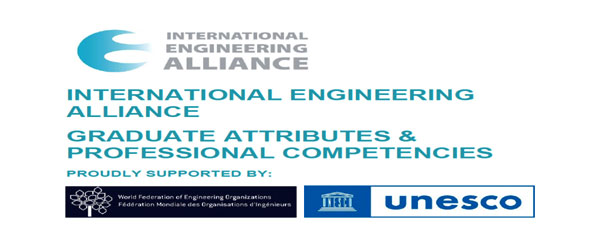
| Differentiating Characteristic | Engineer Graduate |
|---|---|
| Engineering Knowledge: Breadth, depth and type of knowledge, both theoretical and practical | WA1: Apply knowledge of mathematics, natural science, computing and engineering fundamentals, and an engineering specialization as specified in WK1 to WK4 respectively to develop solutions to complex engineering problems |
| Problem Analysis Complexity of analysis | WA2: Identify, formulate, research literature and analyze complex engineering problems reaching substantiated conclusions using first principles of mathematics, natural sciences and engineering sciences with holistic considerations for sustainable development* (WK1 to WK4) |
| Design/developm ent of solutions: Breadth and uniqueness of engineering problems i.e., the extent to which problems are original and to which solutions have not previously been identified or codified | WA3: Design creative solutions for complex engineering problems and design systems, components or processes to meet identified needs with appropriate consideration for public health and safety, whole-life cost, net zero carbon as well as resource, cultural, societal, and environmental considerations as required (WK5) |
| Investigation: Breadth and depth of investigation and experimentation | WA4: Conduct investigations of complex engineering problems using research methods including research- based knowledge, design of experiments, analysis and interpretation of data, and synthesis of information to provide valid conclusions (WK8) |
| Tool Usage: Level of understanding of the appropriateness of technologies and tools | WA5: Create, select and apply, and recognize limitations of appropriate techniques, resources, and modern engineering and IT tools, including prediction and modelling, to complex engineering problems (WK2 and WK6) |
| The Engineer and the World: Level of knowledge and responsibility for sustainable development | WA6: When solving complex engineering problems, analyze and evaluate sustainable development impacts* to: society, the economy, sustainability, health and safety, legal frameworks, and the environment (WK1, WK5, and WK7) |
| Ethics: Understanding and level of practice | WA7: Apply ethical principles and commit to professional ethics and norms of engineering practice and adhere to relevant national and international laws. Demonstrate an understanding of the need for diversity and inclusion (WK9) |
| Individual and Collaborative Team work: Role in and diversity of team | WA8: Function effectively as an individual, and as a member or leader in diverse and inclusive teams and in multi-disciplinary, face-to-face, remote and distributed settings (WK9) |
| Communication: Level of communication according to type of activities performed | WA9: Communicate effectively and inclusively on complex engineering activities with the engineering community and with society at large, such as being able to comprehend and write effective reports and design documentation, make effective presentations, taking into account cultural, language, and learning differences. |
| Project Management and Finance: Level of management required for differing types of activity | WA10: Apply knowledge and understanding of engineering management principles and economic decision-making and apply these to one’s own work, as a member and leader in a team, and to manage projects and in multidisciplinary environments. |
| Lifelong learning: Duration and manner | WA11: Recognize the need for, and have the preparation and ability for i) independent and life-long learning ii) adaptability to new and emerging technologies and iii) critical thinking in the broadest context of technological change (WK8) |
| *Represented by the 17 UN Sustainable Development Goals (UN-SDG) | |
Aim of the Curriculum Framework
The Curriculum Framework is intended to be a flexible, non-prescriptive tool that follows a competency development model through a combination of knowledge, skills, values and attitudes. It also aims to enable the delivery of the SDGs by ensuring that each population has the relevant skills, knowledge, values and attitudes for social, economic and environmental development, and to work in partnership to create peaceful societies.
The Curriculum Framework can support the design, delivery and evaluation of national curricula across the Commonwealth, set the foundations for research and development, provide consistency across programmes for achieving the SDGs, and support the creation of learning and evaluation tools to align with the framework.
This framework will guide degree programmes in defining their contextual needs and the basic requirements related to competencies that must be demonstrated or acquired in order to achieve the objectives of the SDGs through education.
The framework includes the following three components, which make up the competencies that learners develop (i.e. integrated competencies that consist of an interrelated set of competencies including foundational knowledge): (1) knowledge, (2) skills, and (3) values and attitudes. Appropriate knowledge and understanding provide fundamental opportunities for skills development and sharing of values and attitudes, while values and attitudes enable skills to be successfully deployed within the knowledge context.
Purpose of the Curriculum Framework
The purpose of the framework is to develop successful learners, confident individuals, and responsible citizens who are resilient and uphold the core values and principles
Core competencies
Sustainable development depends critically on the competencies of all citizens to cover knowledge, skills, values and attitudes that build on individual capacity. These include team building, communication, decision making, problem solving, sense of community, self-esteem, personal responsibility, empathy, moral development, ethics, values, resilience and improved inclination for educational achievement.
Alongside traditional learning outcomes, core competencies for achieving the SDGs are:
- Envisioning – being able to imagine a better future. The premise is that when we know where we want to go, we will be better able to work out how to get there. The objective is to establish a link between long-term goals and immediate actions, and to motivate people to take action by harnessing their deep aspirations. Under this competency, key elements are: – identifying relevance and meaning to different people; – exploring how to achieve change; – offering direction and inspiration to take action; and – taking ownership of visions, processes and outcomes.
- Critical thinking and reflection – learning to question our current belief systems and to recognise the assumptions underlying our knowledge, perspectives and opinions. Critical thinking helps people learn to examine economic, environmental, social and cultural structures in the context of sustainable development, and challenges people to examine and question the underlying assumptions that influence their world views by having them reflect on unsustainable practices. Critical thinking leads to confidence in addressing the dilemmas and challenges of sustainable development. It encompasses the knowledge, skills and processes associated with intellectual development. Under this competency, key elements are: – developing the ability to participate in change; – providing a new perspective; – promoting alternative ways of thinking; and – developing metacognitive awareness.
- Systemic thinking – acknowledging complexities and looking for links and synergies when trying to find solutions to problems. Systemic thinking helps us recognise that the whole is more than the sum of its parts, and it is a better way to understand and manage complex situations. Under this competency, key elements are: – shifts in thinking from ‘things’ to wholes, and linking these to ‘processes’ and functions – understanding the nature of feedback and how feedback affects system behaviour; and – integrating decision-making and adaptive management techniques
- Building partnerships – promoting dialogue and negotiation, learning to work together so as to strengthen ownership of and commitment to sustainable action through education and learning. Under this competency, key elements are: – building a shared vision among a diverse range of stakeholders; – motivating and adding value to initiatives; and – communicating, imparting and exchanging information.
- Participation in decision-making – empowering oneself and others. This means being involved and involving people in joint analysis, planning and control of local decisions. Under this competency, key elements are: – decision-making and responsibility for outcomes; – a greater sense of ownership of and commitment to responsible action; – building capacity for self-reliance and self-organisation; and – empowering individuals to take action. Competencies relate to an aggregation of corresponding cognitive and practical skills, knowledge, motivation, values and ethics, attitudes, emotions, and other social and behavioural components that can be pulled together to achieve an aim in a specific setting (Rychen and Tiana 2004). According to the Institute of Electrical and Electronics Engineers (IEEE) reusable competency definition, a competency is defined as any form of knowledge, skill, attitude, ability or educational objective that can be described in a context of learning, education or training: ‘The goal of most learning, education and training is to acquire skills, knowledge and ability, i.e. competencies. Recognizing and validating the competencies that individuals have or should acquire are also fundamental to staffing, recruiting, credentialing, personal advancement, workforce development, curriculum development and policy making.
Methodology and review process
The methodology and review process for developing the Curriculum Framework entailed a number of phases: a literature review, including available national curricula, and consultative processes with member countries and relevant experts and partners. These included several technical workshops, as well as internal cross-divisional discussions and feedback.
Integrated competencies and learning outcomes are specified in three categories – knowledge, skills, and values and attitudes are shown in Figure.
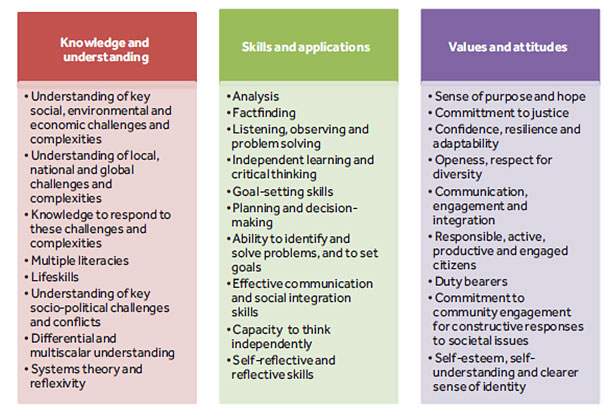
The framework is developed as a matrix model with indicative core competencies that could be used to map the 17 SDGs (or as an auditing tool for the 17 SDGs).
Curriculum Framework mapping: overview
The following tables describe how education across all levels can shape learning outcomes, applying the competencies-based methodology. Each SDG is broken down to illustrate how this systematic methodology can be applied at technical/higher education and across all SDGs for the development of engaged global citizens, driven to support the achievement of the SDGs.
![]()
References:
https://www.ieagreements.org/assets/Uploads/IEA-Graduate-Attributes-and-Professional-Competencies-2021.1-Sept-2021.pdf
https://www.greenwich.edu.pk/images/PDFs/CFSDG_UPDF-003.pdf
Goal 1 – No Poverty
| Knowledge and understanding | Skills and applications | Values and attitudes | |
|---|---|---|---|
| TVET |
|
|
|
| Tertiary education |
|
|
|
Goal 2 – Zero Hunger
| Knowledge and understanding | Skills and applications | Values and attitudes | |
|---|---|---|---|
| TVET |
|
|
|
| Tertiary education |
|
|
|
Goal 3 – Good Health and Well-being
| Knowledge and understanding | Skills and applications | Values and attitudes | |
|---|---|---|---|
| TVET |
|
|
|
| Tertiary education |
|
|
|
Goal 4 – Quality Education
| Knowledge and understanding | Skills and applications | Values and attitudes | |
|---|---|---|---|
| TVET |
|
|
|
| Tertiary education |
|
|
|
|
|
|
Goal 5 – Gender Equality
| Knowledge and understanding | Skills and applications | Values and attitudes | |
|---|---|---|---|
| TVET |
|
|
|
| Tertiary education |
|
|
|
Goal 6 – Clean Water and Sanitation
| Knowledge and understanding | Skills and applications | Values and attitudes | |
|---|---|---|---|
| TVET |
|
|
|
| Tertiary education |
|
|
|
Goal 7 – Affordable and Clean Energy
| Knowledge and understanding | Skills and applications | Values and attitudes | |
|---|---|---|---|
| TVET |
|
|
|
| Tertiary education |
|
|
|
Goal 8 – Decent Work and Economic Growth
| Knowledge and understanding | Skills and applications | Values and attitudes | |
|---|---|---|---|
| TVET |
|
|
|
|
|
| |
|
|
| |
| Tertiary education |
|
|
|
Goal 9 – Industry, Innovation and Infrastructure
| Knowledge and understanding | Skills and applications | Values and attitudes | |
|---|---|---|---|
| TVET |
|
|
|
|
|
|
|
Goal 10 – Reduced Inequalities
| Knowledge and understanding | Skills and applications | Values and attitudes | |
|---|---|---|---|
| TVET |
|
|
|
| Tertiary education |
|
|
|
Goal 11 – Sustainable Cities and Communities
| Knowledge and understanding | Skills and applications | Values and attitudes | |
|---|---|---|---|
| TVET |
|
|
|
|
|
| |
|
|
| |
| Tertiary education |
|
|
|
|
|
| |
|
|
|
Goal 12 – Responsible Consumption and Production
| Knowledge and understanding | Skills and applications | Values and attitudes | |
|---|---|---|---|
| TVET |
|
|
|
| Tertiary education |
|
|
|
|
|
|
Goal 13 – Climate Action
| Knowledge and understanding | Skills and applications | Values and attitudes | |
|---|---|---|---|
| TVET |
|
|
|
| Tertiary education |
|
|
|
Goal 14 – Life below Water
| Knowledge and understanding | Skills and applications | Values and attitudes | |
|---|---|---|---|
| TVET |
|
|
|
| Tertiary education |
|
|
|
|
|
|
Goal 15 – Life on Land
| Knowledge and understanding | Skills and applications | Values and attitudes | |
|---|---|---|---|
| TVET |
|
|
|
| Tertiary education |
|
|
|
|
|
|
Goal 16 – Peace, Justice and Strong Institutions
| Knowledge and understanding | Skills and applications | Values and attitudes | |
|---|---|---|---|
| TVET |
|
|
|
|
|
| |
| Tertiary education |
|
|
|
|
|
| |
|
|
| |
|
|
|
Goal 17 – Partnership for the Goals
| Knowledge and understanding | Skills and applications | Values and attitudes | |
|---|---|---|---|
| TVET |
|
|
|
| Tertiary education |
|
|
|
COMMITMENT TO MEANINGFUL EDUCATION AROUND THE SDGs ACROSS THE UNIVERSITY
B.S. Abdur Rahman Crescent Institute of Science and Technology initiated its curriculum for teaching the next generation to adopt sustainability in their Professional Career and in their personal lives. Targeted to commit a meaningful education around the SDGs, all the UG and PG programmes offered by this institute are framed and mapped with SDGs. Some of the sample courses for selected programmes are shown below. The detailed version of the curriculum and syllabi, which are mapped with SDGs is uploaded in the Institute Website and the links for the same are given below.
| S. No. | Course Code | Course Name | L | T | P | C | Mapped with SDG |
|---|---|---|---|---|---|---|---|
| 1 | CHD1181 | ENGINEERING MATERIALS AND APPLICATIONS | 3 | 0 | 2 | 4 | 9 |
| 2 | GED 1101 | ENGINEERING GRAPHICS | 2 | 0 | 2 | 3 | 9 |
| 4 | GED 1104 | PROGRAMMING FOR PROBLEM SOLVING | 1 | 0 | 2 | 2 | 8 |
| 5 | END 1281 | ENGLISH FOR ENGINEERS | 3 | 0 | 0 | 3 | 4 |
| 6 | GED 1202 | BASIC ELECTRICAL AND ELECTRONICS ENGINEERING | 3 | 0 | 2 | 4 | 3, 8, 12 |
| 7 | GED 1206 | ENVIRONMENTAL SCIENCES | 2 | 0 | 0 | 2 | 3, 5, 6, 7, 13 |
| 8 | GED 2101 | ESSENTIAL SKILLS AND APTITUDE FOR ENGINEER | 0 | 0 | 2 | 1 | 17 |
| 9 | GED 2201 | WORKPLACE SKILLS AND APTITUDE FOR ENGINEERS | 0 | 0 | 2 | 1 | 8 |
| 10 | GED 2202 | INDIAN CONSTITUTION AND HUMAN RIGHTS | 2 | 0 | 0 | 2 | 16 |
![]()
Weblink for the entire Curriculum and Syllabus :
https://crescent.bytdigital.com/wp-content/uploads/2024/02/Dean-AA-B.Tech_.-Mechanical-R2021-CS-Amended-upto-Feb.2022-23.05.22.pdf
| GED 2201 | WORKPLACE SKILLS AND APTITUDE FOR ENGINEERS | L | T | P | C |
| SDG: 8 | 0 | 0 | 2 | 1 | |
| COURSE OBJECTIVES: | |||||
| COB1:To expose them to reading for specific purposes, especially in professional contexts | |||||
| COB2:To expose them to the process of different kinds of formal writing | |||||
| COB3:To prepare the students to be successful in their career | |||||
| COB4:To familiarize various problem-solving techniques in aptitude and puzzles. | |||||
| MODULE I | EXTENSIVE READING & WRITING | 07 | |||
| Reading for comprehension – inferring and note-making – Process of writing- paragraph development – elements of business writing: Email, memos. | |||||
| MODULE II | INTENSIVE READING & WRITING | 08 | |||
| Intensive reading and reviewing – Interpretation of charts, graphs – Résumé – Letter of enquiry, thanksgiving letters. | |||||
| MODULE III | QUANTITATIVE APTITUDE | 08 | |||
| Percentage – Ratio and Proportion – Profit and Loss – Averages, Allegations and Mixtures. | |||||
| MODULE IV | LOGICAL COMPETENCY | 07 | |||
| Syllogism – Blood Relations- Number, Alpha and Alpha numeric series – Puzzles – Cubes and Dice – Odd One Out-Coding and Decoding | |||||
| L – 30; TOTAL HOURS – 30 | |||||
| REFERENCES: | |||||
| 1. Sharma, R.C. and Mohan, Krishna (2010). Business Correspondence and Report Writing. 4th edition. Tata McGraw Hill Education Private Limited, New Delhi 2. Whitby, Norman (2014). Business Benchmark: Pre-Intermediate to Intermediate. Cambridge University Press, UK 3. Tyra .M, Magical Book On Quicker Maths, BSC Publishing Company Pvt. Limited, 2009 4. R. S. Aggarwal , Quantitative Aptitude for Competitive Examinations, S. Chand Limited, 2017 5. R. S. Aggarwal , A Modern Approach to Verbal & Non-Verbal | |||||
| SDG 8:Promote sustained, inclusive and sustainable economic growth, full and productive employment and decent work for all. | |||||
| GED 2202 | INDIAN CONSTITUTION AND HUMAN RIGHTS | L | T | P | C |
| SDG: 16 | 2 | 0 | 0 | 0 | |
| COURSE OBJECTIVES: | |||||
| COB1: To explicate the emergence and evolution of Indian Constitution. | |||||
| COB2: To have an insight into the philosophy of fundamental rights and duties, and Directive Principles. | |||||
| COB3: To differentiate the structure of executive, legislature and judiciary. | |||||
| COB4: To understand human rights and its implication – local and international and redressal mechanism. | |||||
| MODULE I | INTRODUCTION AND BASIC INFORMATION ABOUT INDIAN CONSTITUTION | 8 | |||
| Meaning of the constitution law and constitutionalism – Historical Background of the Constituent Assembly – Government of India Act of 1935 and Indian Independence Act of 1947 – The Constituent Assembly of India – Enforcement of the Constitution – Indian Constitution and its Salient Features – The Preamble of the Constitution. Citizenship. | |||||
| MODULE II | FUNDAMENTAL RIGHTS, DUTIES AND DIRECTIVE PRINCIPLES | 7 | |||
| Fundamental Rights and its Restriction and limitations in different complex situations – Directive Principles of State Policy (DPSP) & its present relevance in our society with examples- Fundamental Duties and its Scope and significance in nation building – Right to Information Act 2005. | |||||
| MODULE III | GOVERNANCE IN INDIA | 8 | |||
| The Union Executive – the President and the Vice-President – The Council of Ministers and the Prime Minister – Powers and functions. The Union legislature – The Parliament – The Lok Sabha and the Rajya Sabha, Composition, powers and functions – Government of the State – The Governor – the Council of Ministers and the Chief Minister – Powers and Functions-Elections-Electoral Process and Election Commission of India – Indian judicial system. | |||||
| MODULE IV | HUMAN RIGHTS AND INDIAN CONSTITUTION | 7 | |||
| Human rights – meaning and significance – Covenant on civil and political rights – Covenant on Economic, Social and Cultural rights – UN mechanism and agencies – The Protection of Human Rights Act, 1993 – watch on human rights and enforcement – Roles of National Human Rights | |||||
| Commission of India – Special Constitutional Provisions for SC & ST, OBC – Special Provision for Women, Children & Backward Classes. | |||||
| L – 30; TOTAL HOURS –30 | |||||
| TEXT BOOKS: | |||||
| 1. B.K. Sharma, Introduction to the Constitution of India, 6th ed., PHI Learning Private Limited, New Delhi 2011 2. Durga Das Basu ―Introduction to the Constitution on India‖, (Students Edition.) Prentice –Hall EEE, 19th / 20th Edn. 2008 3. M.P. Jain, Indian Constitutional Law, 7th ed., LexisNexis, Gurgaon. 2014. | |||||
| COURSE OUTCOMES: At the end of the course, the students will be able to | |||||
| CO1: describe the emergence and evolution of Indian Constitution. | |||||
| CO2: realize the status and importance of fundamental rights, fundamental duties and directive principles of state policy and relation among them by understanding the articulation of its basic value under the Constitution of India. | |||||
| CO3: compare the various structure of Indian government. | |||||
| CO4: recognize the human rights, cultural, social and political rights and its relationship with Indian constitution. . | |||||
| Board of Studies (BoS) : 4th BoS of SSSH held on 28.06.2021 | Academic Council: 17th AC held on 15.07.2021 |
| PO1 | PO2 | PO3 | PO4 | PO5 | PO6 | PO7 | PO8 | PO9 | PO 10 | PO11 | PO 12 | |
| CO1 | M | H | M | L | M | M | ||||||
| CO2 | H | M | H | M | H | |||||||
| CO3 | M | H | M | L | L | |||||||
| CO4 | H | H | H | M | M | H |
Note: L – Low Correlation M – Medium Correlation H – High Correlation
| SDG 16: Promote peaceful and inclusive societies for sustainable development, provide access to justice for all and build effective, accountable and inclusive institutions at all levels |
| Application of human, legal and political rights leading to empowerment in real-life situations for protection of fundamental freedoms and freedom from violence, abuse, trafficking and exploitation are at the core of human rights. |
| S. No. | Course Code | Course Name | L | T | P | C | Mapped with SDG |
|---|---|---|---|---|---|---|---|
| 1 | PHD 1183 | MECHANICS OF SOLIDS | 3 | 0 | 2 | 4 | 4 |
| 2 | CHD 1181 | ENGINEERING MATERIALS AND APPLICATIONS | 3 | 0 | 2 | 4 | 9 |
| 3 | CED 2101 | MECHANICS OF STRUCTURES | 3 | 0 | 0 | 3 | 9, 11 |
| 4 | CED 2102 | MECHANICS OF FLUIDS | 3 | 0 | 0 | 3 | 6 |
| 5 | CED 2103 | CONCRETE TECHNOLOGY | 3 | 0 | 0 | 3 | 11 |
| 6 | CED 2104 | WATER AND WASTEWATER ENGINEERING | 3 | 0 | 2 | 4 | 6 |
| 7 | CED 2106 | CONCRETE AND HIGHWAY LABORATORY | 0 | 0 | 2 | 1 | 11 |
| 8 | GED 2101 | ESSENTIAL SKILLS AND APTITUDE FOR ENGINEERS | 0 | 0 | 2 | 1 | 17 |
| 9 | CED 2204 | ESTIMATION AND COSTING OF INFRASTRUCTURE PROJECTS | 2 | 0 | 2 | 3 | 8 |
| 10 | CED 2206 | SURVEY AND SOIL INVESTIGATION CAMP | 0 | 0 | 2 | 1 | 11 |
![]()
Weblink for the entire Curriculum and Syllabus :
https://crescent.bytdigital.com/wp-content/uploads/2024/02/Dean-AA-B.Tech_.-Civil-R2021-CSAmended-upto-Feb.2022-12.08.22.pdf
| PHD 1183 | MECHANICS OF SOLIDS (For Civil Engineering) | L | T | P | C |
| SDG: 4 | 3 | 0 | 2 | 4 | |
| COURSE OBJECTIVES: The objectives of the course are to impart knowledge on | |||||
| COB1: the basic concepts of stresses, strains and deformation due to internal forces | |||||
| COB2: the principal stresses, strains and theories of failure | |||||
| COB3: theory of torsion and stresses and deformation in circular and hallow shafts. | |||||
| COB4: concept of stresses in thin cylinders and spheres with its application. | |||||
| COB5: concept of stresses and strains in thick cylinders | |||||
| MODULE I | PROPERTIES OF MATERIALS | 9 | ||||
| Introduction – stress – Types of stress – strain – Types of strain – Poisson’s ratio –Hooke’s Law – Elastic constants and their relationship – Volumetric Strain – Plastic deformation of metals; Tensile test – standards for different material (brittle, quasi-brittle, elastic and ductile) – True stress – strain interpretation of tensile test; and hardness of materials; | ||||||
| MODULE II | SIMPLE & COMPOUND STRESSES AND STRAINS | 9 | ||||
| Deformation of simple and compound bars – Bar with uniform and varying section – Thermal Stresses – Principal Stresses, strain and maximum shear stresses – Mohr’s Circle for Plane stress – Principal theories of failure for a member subjected to biaxial stress. | ||||||
| MODULE III | TORSION | 9 | ||||
| Theory of simple torsion – Stresses and deformation in circular and hollow shafts – Stepped shafts – Shafts fixed at both ends – Stresses and deflection of Leaf springs and helical springs. | ||||||
| MODULE IV | THIN CYLINDERS AND SPHERES | 9 | ||||
| Thin Cylinders and Spheres- Derivation of formulae and calculations of hoop stress, longitudinal stress in a cylinder, and sphere subjected to internal pressures. | ||||||
| MODULE V | THICK CYLINDERS | 9 | ||||
| Stresses in Thick cylinders subjected to internal and external pressure and compound cylinders – Stresses and strains in thick spherical shell. | ||||||
PRACTICALS | ||||||
| 1. Properties of steel rebar by tension test 2. Determination of hardness of metal by Rockwell and Brinell hardness test. 3. Determination of impact strength of metal by Izod and Charpy method. 4. Investigation of Hooke’s Law using timber and steel. 5. Determination of Stiffness and Modulus of rigidity of steel specimen by torsion test. 6. Determination of Stiffness and Modulus of rigidity of open coil spring | ||||||
| L – 45; P – 30; Total Hours – 75 | ||||||
| TEXT BOOKS: | ||
| 1. Popov, E.P and Balan, T.A., “Engineering Mechanics of Solids”, Pearson India Education Services, 2nd Edition, India, 2018. 2. Stephen Timoshenko, “Strength of Materials: Elementary Theory and Problems”, CBS Publishers & Distributors, 3rd Edition, New Delhi, 2004. | ||
| REFERENCES: | ||
| 1. Jindal, U.C., “Strength of Materials”, Pearson Education, India, 2012 2. Ramamrutham, S and Narayan, S., “Strength of Materials”, Dhanpat Rai Publishing Company Pvt. Ltd., New Delhi, 2008. | ||
| COURSE OUTCOMES: At the end of the course, the student will be able to | ||
| CO1: describe stress, strain, elastic constants and their relationship. | ||
| CO2: determine the principal stresses and strains based on various methods. | ||
| CO3: develop the torsion equation and solve the problems based on torsion. | ||
| CO4: determine the stress in thin cylinders and spheres | ||
| CO5: determine the stress in thick cylinders and spheres | ||
| Board of Studies (BoS) : BOS of Physics was held on 21.6.21 | Academic Council: 17th AC held on 15.07.2021 | |
| PO1 | PO2 | PO3 | PO4 | PO5 | PO6 | PO7 | PO8 | PO9 | PO 10 | PO 11 | PO 12 | PSO1 | PSO2 | PSO3 | |
| CO1 | H | M | L | L | M | M | M | L | L | L | M | M | – | – | – |
| CO2 | H | M | M | L | L | M | L | L | L | L | L | M | – | – | – |
| CO3 | H | M | M | L | L | L | L | L | L | L | L | M | – | – | – |
| CO4 | H | M | M | L | M | M | M | L | L | L | M | M | – | – | – |
| CO5 | H | M | M | L | M | M | M | L | L | L | M | M | – | – | – |
Note: L – Low Correlation M – Medium Correlation H – High Correlation
| SDG 4: Ensuring inclusive and equitable quality education for all persons and promote lifelong learning opportunities. |
| ED 2102 | MECHANICS OF FLUIDS | L | T | P | C |
| SDG: 6 | 3 | 0 | 0 | 3 | |
| COURSE OBJECTIVES: | |||||
| COB1: To impart understanding of key concepts and fundamental principles pertaining to fluid behavior. | |||||
| COB2: To provide sufficient knowledge to understand the basic concepts of fluid flow. | |||||
| COB3: To impart the basic knowledge on the dynamics of fluids and flow through pipes. | |||||
| COB4: To expose to the significance of boundary layer theory and its applications. | |||||
| COB5: To develop the basic knowledge on the dimensional analysis and model study. | |||||
| MODULE I | FLUID PROPERTIES AND PRESSURE MEASUREMENTS | 10 | |||
| Dimensions and units – Properties of Fluids – Ideal and Real fluid – Definition of pressure – Pressure at a point- Pascal’s law- Absolute and Gauge pressure – Measurement of pressure – Simple and Differential Manometer theory and problems – Pressure gauges. | |||||
| MODULE II | FLUID STATICS AND FLUID KINEMATICS | 10 | |||
| Fluid Statics – Hydrostatic law – Definition of total pressure, Center of pressure, Metacentric height, Buoyant force –Problems on hydrostatic force and depth of center of pressure on plane surfaces and submerged surfaces (Vertical, Inclined and curved). Fluid Kinematics – Velocity and Acceleration- Stream, Streak and Path lines – Classification of flows – Continuity equation (one-, two- and three- dimensional forms) – Stream and Potential functions – Flow nets. | |||||
| MODULE III | FLUID DYNAMICS | 9 | |||
| Euler and Bernoulli’s equations – Application of Bernoulli’s equation – Venturimeter–Orifice meter- Laminar flow through pipes– Hagen Poiseuille equation – Turbulent flow – Darcy-Weisbach formula – Major and minor losses of flow in pipes – Pipes in series and in parallel – Moody diagram. | |||||
| MODULE IV | BOUNDARY LAYER | 8 | |||
| Definition of boundary layer – Thickness and classification –Displacement | |||||
| and momentum thickness – Separation of boundary layer – Development of laminar and turbulent flows in circular pipes. | |||||
| MODULE V | SIMILITUDE AND MODEL STUDY | 8 | |
| Dimensional Analysis – Rayleigh’s method, Buckingham’s Pi- theorem – Similitude and Models- Dimensionless numbers – Scale effect and Distorted models | |||
| L –45; Total Hours– 45 | |||
| TEXT BOOKS: | |||
| 1. Bansal R.K.,“A textbook of Fluid mechanics and hydraulic machines”, Laxmi Publications (P) Ltd., New Delhi, 10th Edition, 2019. 2. Modi, P.N. and Seth, S.M.,” Hydraulics and Fluid Mechanics including Hydraulics Machines”, 21st Edition, Standard Book House, New Delhi, 2018. 3. Som. S.K., Gautam Biswas and Chakraborty. S., “Introduction to Fluid Mechanics and Fluid Machines”, Tata McGraw Hill Education Pvt. Ltd., 2012. | |||
| COURSE OUTCOMES: At the end of the course the students will be able to | |||
| CO1: describe fluid properties, forces causing flow and will be able to solve problems involving fluid properties and fluid pressure measurements. | |||
| CO2: assess the knowledge related to hydrostatic forces acting on the floating bodies and analyze the flow using principles of fluid kinematics. | |||
| CO3: solve fluid problems using principle of fluid dynamics, estimate losses in pipelines and analysis of pipes connected in series and parallel. | |||
| CO4: demonstrate the concept of boundary layer and its application to find the drag force excreted by the fluid on the flat solid surface. | |||
| CO5: formulate the relationship among the parameters involved in the given fluid phenomenon and to predict the performances of prototype by model studies. | |||
| Board of Studies (BoS) : 16th BOS of Civil held on 5.1.2022 | Academic Council: 18th Academic Council held on 24.02.2022 | ||
| PO 1 | PO 2 | PO 3 | PO 4 | PO 5 | PO 6 | PO 7 | PO 8 | PO 9 | PO 10 | PO 11 | PO 12 | PSO1 | PSO2 | PSO3 | |
| CO1 | H | M | L | L | L | L | M | L | L | L | L | M | L | L | L |
| CO2 | H | M | L | L | L | L | M | L | L | L | L | M | L | L | L |
| CO3 | H | M | H | L | L | M | H | L | L | L | L | H | L | L | M |
| CO4 | H | M | M | M | L | L | M | L | L | L | L | H | L | L | L |
| CO5 | H | M | M | M | L | L | H | L | L | L | L | H | L | L | L |
Note: L – Low Correlation M – Medium Correlation H – High Correlation
SDG 6: Clean, accessible water for all is an essential part of the world we want to live in.
| CED 2103 | CONCRETE TECHNOLOGY | L | T | P | C | ||
| SDG: 11 | 3 | 0 | 0 | 3 | |||
| COURSE OBJECTIVES: The main objective of this course is to impart adequate knowledge on | |||||||
| COB1:significance of concrete constituent materials | |||||||
| COB2:workability of concrete and concrete mix design | |||||||
| COB3:hardened concrete properties and its significance | |||||||
| COB4: durability properties of concrete | |||||||
| COB5: different types of concrete currently used in the construction projects | |||||||
| MODULE I | CONCRETE CONSTITUENT MATERIALS AND WORKABILITY | 9 | |||||
| Overview and significance of concrete constituent materials – Cement : chemical composition and compounds, hydration process, microstructure of concrete–Workability : water-cement ratio, influencing factors, site and laboratory methods to determine workability – Mineral and chemical admixtures : overview | |||||||
| MODULE II | CONCRETE MIX DESIGN | 9 | |||||
| Manufacture of concrete: Construction practices to be followed in site – Concrete Mix Design: significance, salient parameters, mix design as per Indian Standards and American Concrete Institute method, validation of mix design, fresh concrete properties. | |||||||
| MODULE III | HARDENED CONCRETE PROPERTIES | 9 | |||||
| Hardened concrete properties: overview and significance – compressive strength, flexural strength, splitting tensile strength, modulus of elasticity, bond strength, creep and shrinkage: test methods as per Indian standards, estimation of strength properties – NDT techniques for hardened concrete strength assessment : overview. | |||||||
| MODULE IV DURABILITY PROPERTIES OF CONCRETE 9 | |||||||
| Sustainable construction – Durable concrete – life cycle cost benefits – Mechanisms affecting durability of concrete: physical mechanisms and chemical mechanisms : overview – Significance of proper selection of construction materials, mix design and good construction practices – Tests to assess durability of concrete : water absorption, water permeability, water | |||||||
| sorptivity, rapid chloride penetration test, accelerated corrosion test – test procedures and estimation methods. | |||||||
| MODULE V | CONCRETE FOR SPECIAL APPLICATIONS | 9 | |||||
| High performance concrete – fibre reinforced concrete – polymer modified concrete – shotcrete – self compacting concrete | |||||||
| L – 45 ; TOTAL HOURS – 60 | |||||||
| TEXT BOOKS: | |||||||
| 1. Shetty.M.S., and A.K. Jain “Concrete Technology (Theory and Practice)”, S. Chand and Company Ltd.,2010. 2. Gambhir.M.L., “Concrete Technology”, 5th Edition, Tata McGraw Hill Education, 2017 | |||||||
| COURSE OUTCOMES: On completion of the course the student will be able to | |||||||
| CO1: describe the composition and compounds of cement, hydration process and workability of concrete. | |||||||
| CO2: perform mix design of concrete as per Indian Standards and ACI method | |||||||
| CO3: describe the hardened concrete properties including its test method as per Indian Standard | |||||||
| CO4: describe the durability properties of concrete including its test method as per Indian Standard / ASTM | |||||||
| CO5: specify and describe the type of concrete for special applications. | |||||||
| Board of Studies (BoS) : 16thBoS of Civil held on 05.01.2022 | Academic Council: 18th AC held on 24.02.2022 | ||||||
| PO1 | PO2 | PO3 | PO4 | PO5 | PO6 | PO7 | PO8 | PO9 | PO 10 | PO 11 | PO 12 | PSO1 | PSO2 | PSO3 | |
| CO1 | L | H | |||||||||||||
| CO2 | M | H | |||||||||||||
| CO3 | M | M | M | H | |||||||||||
| CO4 | M | M | M | H | |||||||||||
| CO5 | M | M | H | H |
Note: L – Low Correlation M – Medium Correlation H – High Correlation
| SDG 11: Make cities and human settlements inclusive, safe, resilient and sustainable |
| Designing of durable concrete by properly understanding the properties of concrete constituent materials, expected strength, exposure conditions and application; make the human settlements safe and resilient and leads to sustainable development. |
| S. No. | Course Code | Course Name | L | T | P | C | Mapped with SDG |
|---|---|---|---|---|---|---|---|
| 1 | EED 2201 | AC Machines | 3 | 0 | 0 | 3 | 8, 9 |
| 2 | EED 2204 | Power System Protection | 3 | 0 | 0 | 3 | 7, 9 |
| 3 | EEDX 62 | Solar Energy Technology | 3 | 0 | 0 | 3 | 7, 13 |
| 4 | PHDX 01 | Non Destructive Testing of Materials | 3 | 0 | 0 | 3 | 4 |
| 5 | PHDX 03 | Biomaterials | 2 | 0 | 0 | 2 | 4, 7, 14 |
| 6 | PHDX 07 | Fundamentals of Nanotechnology and its Applications | 2 | 0 | 0 | 2 | 4 |
| 7 | SSDX 02 | Sociology Of Science And Technology | 3 | 0 | 0 | 3 | 17 |
| 8 | SSDX 03 | Industrial Economics and Management | 3 | 0 | 0 | 3 | 8, 9 |
| 9 | SSDX 11 | Economics of Sustainable Development | 2 | 0 | 0 | 2 | 9, 12 |
| 10 | GEDX 216 | IPR and Patent Laws | 3 | 0 | 0 | 3 | 9, 16 |
![]()
Weblink for the entire Curriculum and Syllabus :
https://crescent.bytdigital.com/wp-content/uploads/2023/09/Dean-AA-B.Tech_.-EEE-R2021_CS-Amendments-updated-upto-February-2022.pdf
| GED 2101 | ESSENTIAL SKILLS AND APTITUDE FOR ENGINEERS | L | T | P | C | |
| SDG: 17 | 0 | 0 | 2 | 1 | ||
| COURSE OBJECTIVES: | ||||||
| COB1:To enable them to make effective business presentations | ||||||
| COB2:To train them to participate in group discussions | ||||||
| COB3:To enhance the problem-solving skills | ||||||
| COB4:To train students in solving analytical problems | ||||||
| MODULE I | ORAL DISCOURSE | 07 | ||||
| Importance of oral communication-verbal and non-verbal communication, Presentation Strategies- one minute presentation (using Audacity/vocaro) – Effective listening skills, listening for specific information | ||||||
| MODULE II | VERBAL COMMUNICATION | 08 | ||||
| Understanding negotiation, persuasion & marketing skills – Listening to short conversations & monologues – Group Discussion techniques – Role plays – Interview techniques | ||||||
| MODULE III | BASIC NUMERACY | 08 | ||||
| Simplification and Approximation – Competitive Examination Shortcut Techniques – Number Systems – Simple and Compound Interest-Progression | ||||||
| MODULE IV | ANALYTICAL COMPETENCY | 07 | ||||
| Blood Relations – Clocks and Calendars – Coding and Decoding – Analytical Reasoning(Linear Arrangement, Circular Arrangement, Cross Variable Relationship and Linear Relationship)– Directions . | ||||||
| L – 30; TOTAL HOURS 30 | ||||||
| REFERENCES: | ||||||
| 1. Whitby, Norman (2014). Business Benchmark: Pre-Intermediate to Intermediate. Cambridge University Press, UK 2. Swan, Michael (2005). Practical English Usage, Oxford University Press 3. Bhattacharya. Indrajit (2008). An Approach to Communication Skills, Dhanpat Rai& Co., (Pvt.) Ltd. New Delhi. | ||||||
| COURSE OUTCOMES: | ||||||
| CO1: Make effective business presentations | ||||||
| CO2: Speak English intelligibly, fluently and accurately in group discussions | ||||||
| CO3: To apply the various problem-solving techniques | ||||||
| CO4: Understand and solve aptitude problem | ||||||
| Board of Studies (BoS) : 13thBoS of the Department of English held on 17.6.2021 | Academic Council: 17th AC held on 15.07.2021 | |||||
| PO 1 | PO 2 | PO 3 | PO 4 | PO 5 | PO 6 | PO 7 | PO 8 | PO 9 | PO 10 | PO 11 | PO 12 | PSO 1 | PSO 2 | PSO 3 | |
| CO1 | H | ||||||||||||||
| CO2 | M | H | |||||||||||||
| CO3 | L | L | |||||||||||||
| CO4 | M | L | |||||||||||||
| CO5 |
Note: L- Low Correlation M – Medium Correlation H – High Correlation
SDG 17: Strengthen the means of implementation and revitalize the global partnership for sustainable development
Entrepreneurship Courses – Wadhwani Foundation
As part of the MoU signed with M/s.Wadhwani Foundation, National Entrepreneurship Network (NEN), Bangalore Basic Course in Entrepreneurship was taught to the students of B.Tech. programmes across discipline.
The course Advanced Entrepreneurship was offered as an elective for B.Tech. students aiming to become real-time entrepreneurs.
The following is the brief account of the activities undertaken through Wadhwani Foundation, National Entrepreneurship Network (NEN):
| Month & Year | Social Entrepreneurship Course | Advanced Entrepreneurship Course | Total No. of Students Enrolled |
|---|---|---|---|
| ODD 2020-21 July – Dec. 2020 | 292 | 59 | 351 |
| EVEN 2020-21 Jan. – June 2021 | 368 | – | 368 |
| Total | 660 | 59 | 719 |
Value-added Courses through IIT Bombay Spoken Tutorial
The staffs and students of all programmes were encouraged to enroll in value added courses through IIT Bombay Spoken Tutorials portal. The courses help to enrich their knowledge and gather expertise in their areas of interest.
The details of the students enrolled in the courses are given as follows:
| Details | Odd Semester (2020-21) | Even Semester (2020-21) |
|---|---|---|
| Total number of courses enrolled | 59 | 28 |
| Total number of faculty involved | 57 | 26 |
| Total number of candidates enrolled | 2656 | 1155 |
| S. No. | Name of the Course | Course Code | Mapped with SDGs | Offering Department |
|---|---|---|---|---|
| 1 | Environmental Studies | GEC 1212 | 11,12 | Civil Engineering |
| 2 | Computer Programming II | GEC 1213 | 4 | |
| 3 | Building Construction and Practices | CEC 1212 | 7 | |
| 4 | Water and Wastewater Engineering | CED 2104 | 6 | |
| 5 | Social Entrepreneurship | MSC 3182 | 8 | Management Studies |
| 6 | Communication and soft skill I – Career Choice | ENC 3181 | 4 | English |
| 7 | Design of Reinforced Concrete Structures | CEC 3102 | 7 | Civil Engineering |
| 8 | Structural Analysis – II | CEC 3211 | 4 | |
| 9 | Industrial Internship | CEC 4105 | 9 | |
| 10 | Safety in Construction | CECX 04 | 7,12 | |
| 11 | Air & Noise Pollution and Control | CECX 11 | 11 | |
| 12 | Industrial Waste Water Treatment | CECX 16 | 6 | |
| 13 | Hazardous Waste Management | CECX 17 | 6 | |
| 14 | Industrial health and Safety | CECX 20 | 3 | |
| 15 | Urban Design | CECX 21 | 11 | |
| 16 | Water proofing of RCC structures | CECX 22 | 6 | |
| 17 | Advanced Concrete Design | CECX 31 | 7 | |
| 18 | Repair and Rehabilitation of Structures | CECX 32 | 7,11,12 | |
| 19 | Housing, Planning and Management | CECX 35 | 9,11 | |
| 20 | Building Services | CECX 36 | 7 | |
| 21 | Environmental Risk Assessment | CECX 38 | 13 | |
| 22 | Earthquake Engineering | CECX 46 | 13 | |
| 23 | Ground Water Engineering | CECX 51 | 6 | |
| 24 | Environmental Impact Assessment | CECX 52 | 15 | |
| 25 | Building Information Modeling | CECX 56 | 7 | |
| 26 | Storm Water and Flood Management | CECX 59 | 13 | |
| 27 | Urban & Indoor Air Quality Management | CECX 60 | 11 | |
| 28 | Contract laws and Regulations | CECX 61 | 16 | |
| 29 | Smart Cities | CECX 62 | 11 | |
| 30 | Electrical materials and batteries | CHCX 03 | 7 | Chemistry |
| 31 | Fuels and combustion | CHCX 05 | 7 | Chemistry |
| 32 | Green technology | CHCX 07 | 7,11 | |
| 33 | Polymer science and technology | CHCX 09 | 4 | |
| 34 | Discrete Mathematics and Graph Theory | MACX 01 | 4 | Maths |
| 35 | Law for Engineers | SSCX 06 | 16 | Social Science |
| 36 | Disaster Management | GECX 101 | 13 | Civil Engineering |
| 37 | Energy Studies | GECX 103 | 7, 13 | |
| 38 | Knowledge management | GECX 110 | 4 | |
| 39 | Vehicle Maintenance | GECX 116 | 7 | |
| 40 | Green Design and Sustainability | GECX 201 | 11 | |
| 41 | Industrial Safety | GECX 205 | 9 | |
| 42 | Advanced Materials | GECX 212 | 7 | |
| 43 | National Service Scheme | GECX 213 | 16 | |
| 44 | Automotive Pollution and Control | GECX 214 | 7 | |
| 45 | Advanced Entrepreneurship | GECX 219 | 8 | |
| 46 | Electric Vehicles | GECX 220 | 7 | |
| 47 | Introduction to Aeronautical Engineering | AEC 1211 | 4 | Aeronautical Engineering |
| 48 | Aircraft Component Modeling & Drafting Laboratory | AEC 1212 | 4, 8 | |
| 49 | Aircraft Structure Repair Laboratory | AEC 1213 | 4, 8 | |
| 50 | Solid Mechanics | AEC 2101 | 4 | |
| 51 | Engineering Thermodynamics | AEC 2102 | 4 | |
| 52 | Fluid Mechanics | AEC 2103 | 6 | |
| 53 | Basic Electrical and Electronics Engineering | EIC 2181 | 4 | Electronics & Instrumentation |
| 54 | Air Breathing Propulsion | AEC 2213 | 11 | Aeronautical Engineering |
| 55 | Aircraft Systems and Instruments | AEC 2214 | 11 | |
| 56 | Solid Mechanics Laboratory | AEC 2215 | 4, 8 | |
| 57 | Propulsion Laboratory | AEC 2217 | 4, 8 | |
| 58 | Compressors and Turbines | AEC 3101 | 4, 8 | |
| 59 | Aircraft Structural Design and Analysis | AEC 3102 | 4, 8 | |
| 60 | High Speed Aerodynamics | AEC 3103 | 4, 8 | |
| 61 | Aerodynamics Laboratory | AEC 3104 | 4, 8 | |
| 62 | Aircraft Structural Analysis Laboratory | AEC 3105 | 4, 8 | |
| 63 | Rocket Propulsion | AEC 3211 | 4, 8 | |
| 64 | Flight Dynamics | AEC 3212 | 4, 8 | |
| 65 | Aircraft Materials and Processes | AEC 3213 | 4, 8 | |
| 66 | Aircraft Design Project – I | AEC 3214 | 4, 8 | |
| 67 | Avionics | AEC 4101 | 4, 8 | |
| 68 | Finite Element Method | AEC 4102 | 4, 8 | |
| 69 | UAV and MAV Systems | AEC 4103 | 4, 8 | Aeronautical Engineering |
| 70 | Aircraft Design Project – II | AEC 4104 | 4, 8 | |
| 71 | CFD-Structural Analysis Laboratory | AEC 4105 | 4, 8 | |
| 72 | Internship | AEC 4106 | 9 | |
| 73 | Project Work | AEC 4211 | 4, 8 | |
| 74 | Optical Flow Diagnostics | AECX 01 | 4, 8 | |
| 75 | Hypersonic Aerodynamics | AECX 02 | 4, 8 | |
| 76 | Industrial Aerodynamics | AECX 03 | 4, 8, 9 | |
| 77 | Grid Generation | AECX 04 | 4, 8, 9 | |
| 78 | Wind Tunnel Model Design | AECX 05 | 7 | |
| 79 | Theory of Elasticity | AECX 06 | 4, 8, 9 | |
| 80 | Fatigue and Fracture Mechanics | AECX 07 | 4, 8, 9 | |
| 81 | Structural Analysis Tools (NASTRAN and PATRAN) | AECX 08 | 4, 8, 9 | |
| 82 | Smart Structures | AECX 09 | 4, 8, 9 | |
| 83 | Aircraft Structural Testing and Qualification | AECX 10 | 4, 8, 9 | |
| 84 | Measurement Systems | AECX 11 | 4, 8, 9 | |
| 85 | NDT techniques for Aircraft Structures | AECX 12 | 4, 8, 9 | |
| 86 | Airframe Repair and Maintenance | AECX 13 | 11 | |
| 87 | Behavior of Materials at High Temperatures | AECX 14 | 4, 8, 9 | |
| 88 | Heat Transfer | AECX 15 | 4, 8, 9 | |
| 89 | Advanced Propulsion Systems | AECX 16 | 4, 8, 9 | |
| 90 | Micro Propulsion | AECX 17 | 4, 8, 9 | |
| 91 | Cryogenics | AECX 18 | 4, 8, 9 | |
| 92 | Air Traffic Control and Aerodrome Design | AECX 19 | 4, 8, 9 | |
| 93 | Aviation Rules and Regulation | AECX 20 | 4, 8, 9 | |
| 94 | Experimental Aerodynamics | AECX 21 | 4, 8, 9 | |
| 95 | Computational Fluid Dynamics | AECX 22 | 4, 8, 9 | |
| 96 | Viscous Flows | AECX 23 | 4, 8, 9 | |
| 97 | Aero-acoustics | AECX 24 | 4, 8, 9 | |
| 98 | Wind Engineering | AECX 25 | 13 | |
| 99 | Composite Materials and Structures | AECX 26 | 4, 8, 9 | |
| 100 | Experimental Techniques For Aircraft Structures | AECX 27 | 4, 8, 9 | |
| 101 | Vibration and Aero Elasticity | AECX 28 | 4, 8, 9 | |
| 102 | Hyper Mesh | AECX 29 | 4, 8, 9 | |
| 103 | Combustion | AECX 30 | 4, 8, 9 | |
| 104 | Rockets and Missiles | AECX 31 | 4, 8, 9 | |
| 105 | Aircraft Cooling Systems | AECX 33 | 4, 8, 9 |
Sample Syllabus denoting the specific courses on sustainability
| GECX101 | DISASTER MANAGEMENT | L | T | P | C |
| SDG 13 | 3 | 0 | 0 | 3 | |
| OBJECTIVES: | |||||
| |||||
| MODULE I | ENVIRONMENTAL HAZARDS | 7 | |||
| Environmental hazards, Environmental Disasters and Environmental stress- Meaning and concepts. Vulnerability and disaster preparedness. | |||||
| MODULE II | NATURAL DISASTERS | 7 | |||
| Natural hazards and Disasters – Volcanic Eruption, Earthquakes, Tsunamis, Landslides, Cyclones, Lightning, Hailstorms, Floods, Droughts, Cold waves, Heat waves and Fire. | |||||
| MODULE III | MAN-MADE DISASTERS | 7 | |||
| Man induced hazards & Disasters – Soil Erosion, Chemical hazards, Population Explosion | |||||
| MODULE IV | DISASTER MANAGEMENT | 8 | |||
| Emerging approaches in Disaster Management- Preparing hazard zonation maps, Predictability / forecasting & warning, Preparing disaster preparedness plan, Land use zoning, Communication. Disaster resistant house construction, Population reduction in vulnerable areas, Awareness – Rescue training for search & operation at national & regional level – Immediate relief, Assessment surveys, Political, Administrative, Social, Economic, Environmental Aspects. | |||||
| MODULE V | NATURAL DISASTER REDUCTION & MANAGEMENT | 8 | |||
| Provision of Immediate relief measures to disaster affected people, Prediction of Hazards & Disasters, Measures of adjustment to natural hazards | |||||
| MODULE VI | ENVIRONMENTAL POLICIES & PROGRAMMES IN INDIA | 8 | |||
| Regional survey of Land Subsidence, Coastal Disaster, Cyclonic Disaster & Disaster in Hills with particular reference to India. Ecological planning for sustainability & sustainable development in India, Sustainable rural development: A Remedy to Disasters, Role of Panchayats in Disaster mitigations, Environmental policies & programmes in India- Institutions & National Centers for Natural Disaster reduction, Environmental Legislations in India, Awareness, Conservation Movement, Education & training. | |||||
| Total Hours –45 | |||||
| REFERENCES: | |||||
| |||||
| OUTCOMES: | |||||
At the end of the course, the students will be able to
| |||||
| SDG 13 : Climate change is a crisis that will affect every part of society, and every country. Universities need to be at the forefront of action to reduce the impact of climate change, especially amongst the poorest who will be the most affected. | |||||
| CED 2104 | WATER AND WASTEWATER ENGINEERING | L | T | P | C |
| SDG: 6 | 3 | 0 | 2 | 4 | |
| COURSE OBJECTIVES: The objectives of the course are to impart knowledge on | |||||
| COB1: The population forecasting, water sources, intake structures, water quality and its treatment | |||||
| COB2: The advanced water treatment methods, water storage facilities and distribution network | |||||
| COB3: The sewerage systems, estimation of wastewater flows & storm runoff, wastewater characterization and its primary treatment | |||||
| COB4: The secondary treatment of wastewater | |||||
| COB5: The methods for wastewater disposal & sludge handling. | |||||
| MODULE I | WATER TREATMENT | 9 | |||
| Design Period – Population forecasting – Types of water demand -Sources of water – Intakes – Characteristics of water – Standards for drinking water – Principle, function and design of water treatment units – sedimentation, coagulation & flocculation, Filtration – theory & principle of disinfection methods. | |||||
| MODULE II | ADVANCED WATERTREATMENT, STORAGE & DISTRIBUTION | 9 | |||
| Water softening – Iron, Manganese and Phosphorus removal, Defluoridation – Desalination – Membrane filtration – Water storage facilities – Distribution networks & analysis. | |||||
| MODULE III | PRIMARY TREATMENT OF WASTEWATER | 9 | |||
| Sewerage systems – Sewage flow estimation – Storm runoff estimation – Sewer materials – Hydraulics of flow in sewer – Sewer appurtenances – Characteristics of sewage – Unit operations and processes – Primary treatment – Principles, functions and design of sewage treatment units – Screens – Grit chamber. | |||||
| MODULE IV | SECONDARY TREATMENT OF WASTEWATER | 9 | |||
| Introduction to Aerobic and Anaerobic treatment process – Functions and design of Activated sludge process and trickling filter – Principles and functions of Membrane Bioreactor, Sequential batch reactor, Waste stabilisation pond, UASB reactor – Onsite sanitation – septic tanks | |||||
| MODULE V | WASTEWATER DISPOSAL & SLUDGE TREATMENT | 9 | |||
| Standards for disposal into water bodies – Self-purification of river – Oxygen sag curve – Sewage farming and methods – Sludge thickening & Digestion – Biogas recovery – Sludge conditioning and Dewatering – Sludge drying bed. | |||||
| PRACTICALS | |||||
List of experiments
| |||||
| L – 45; P – 30; Total Hours – 75 | |||||
| TEXT BOOKS: | |||||
| |||||
| COURSE OUTCOMES: At the end of the course the student will be able to | |||||
| CO1: forecast population, estimate quantity of water demand, characterize water quality and design treatment units | |||||
| CO2: describe advanced treatments for water, water storage facilities and analyze distribution network | |||||
| CO3: explain the sewerage systems, estimate wastewater flows & storm runoff, characterize quality of wastewater and design the primary wastewater treatment units | |||||
| CO4:describe the secondary treatment of wastewater | |||||
| CO5: describe the methods for wastewater disposal & sludge handling. | |||||
| Board of Studies (BoS) : 16th BoS of Civil held on 05.01.2022. | Academic Council: 18th Academic Council held on 24.02.2022 | ||||
| PO1 | PO2 | PO3 | PO4 | PO5 | PO6 | PO7 | PO8 | PO9 | PO 10 | PO 11 | PO 12 | PSO1 | PSO2 | PSO3 | |
| CO1 | – | – | M | – | – | L | H | L | M | M | – | M | L | – | H |
| CO2 | – | – | L | – | – | – | H | L | M | M | – | M | L | – | H |
| CO3 | – | – | M | – | – | L | H | L | M | M | – | M | L | – | H |
| CO4 | – | – | M | – | – | – | H | L | M | M | – | M | L | – | H |
| CO5 | – | – | L | – | – | M | H | L | M | M | – | M | L | – | H |
Note: L – Low Correlation M -Medium Correlation H – High Correlation
| SDG No.6 : Clean Water and Sanitation |
| The understanding of water and wastewater treatment leads to the development of sustainable technologies for treatment and management of water and wastewater. |
| CSCX 167 | CYBER LAWS AND ETHICS | L | T | P | C |
| SDG 16 | 2 | 0 | 0 | 2 | |
| OBJECTIVES : | |||||
| |||||
| MODULE I | INTRODUCTION | 10 | |||
| Cyber crime – Categories – kinds– Internet Security- Computer Security and legal aspects– Copyright – Cyber Space Jurisdiction. | |||||
| MODULE II | CYBER LAW | 10 | |||
| Internet Governance- IT ACT – Scope and Application – Cyber Contraventions- Adjudication- Appellate Tribunal and Offences -Case laws relating to IT ACT. | |||||
| MODULE III | CYBER ETHICS | 10 | |||
| Internet and ethical values – Ethics of blogging-Facebook threat– Free speech and content controls in cyber space – Intellectual property in cyber space. | |||||
| L – 30;TOTAL HOURS-30 | |||||
| REFERENCES : | |||||
| 1. | Sushma Arora and Raman Arora, ―Cyber Crimes & Laws‖, Taxmann Publications, ISBN: 9789350719879, 2016. | ||||
| 2. | Richard A. Spinello, ―Cyber Ethics-Morality and Law in cyberspace‖, Jones and Bartlett Learning, 6th Edition, ISBN: 9781284081398, 2017. | ||||
| 3. | Joan Ruttenberg, Paige von Mehren and Julie Yen ―, The OPIA Insider‘s Guide to Intellectual Property And Cyberlaw‖, Bernard Koteen Office of Public Interest Advising Harvard Law School, 7th Edition, ISBN: 978813170205, 2013. | ||||
| OUTCOMES : | |
Students who complete this course will be able to
| |
| SDG 16:The rule of law and development have a significant interrelation and are mutually reinforcing, making it essential for sustainable development at the national and international level. | |
| AUC X33 | POWER PLANT ENGINEERING | L | T | P | C |
| SDG 7 | 3 | 0 | 0 | 3 | |
| OBJECTIVES: | |||||
| |||||
| MODULE I | FUEL COMBUSTION EQUIPMENTS | 8 | |||
| Types of combustion, stokers, fuel and ash handling equipments. Draft – forced, induced and balanced drafts. Selection of fans. Heat recovery equipmentseconomisers, air preheaters and reheaters, different types of superheaters and desuperheaters. Emission control, flue gas cleaning, particulate and gaseous emission control methods. | |||||
| MODULE II | THERMAL POWER PLANT SYSTEMS | 8 | |||
| Steam generators – forced circulation, high-pressure boilers and super critical boilers, fluidized bed boiler, boiler accessories and mountings. Boiler testing. Condensers: Different types, design factors, air removal, performance calculation. Cooling towers – natural and mechanical draft types. | |||||
| MODULE III | NUCLEAR POWER PLANTS | 7 | |||
| General nuclear fuels used in reactors, elements of nuclear reactor, moderator, control rods, coolants, description of different types of reactors. Radiation hazards, radioactive waste disposal. | |||||
| MODULE IV | DIESEL AND GAS TURBINE POWER PLANTS | 7 | |||
| Diesel power plant – Classifications, components, selection of engine type. Gas turbine plant – closed and open cycles. Combined power cycles | |||||
| MODULE V | RENEWABLE ENERGY SOURCES | 8 | |||
| Solar energy – measurement, methods of utilization, flat plate and concentrating collectors, water heater, air driers, photovoltaic cell. Wind energy – Horizontal and vertical axis wind turbines. Geothermal plants, tidal power plant, biomass and biogas plants, OTEC plants. | |||||
| MODULE VI | POWER PLANT ECONOMICS | 7 | |||
| Plant load factor and utilization factor, cost economics – Tariff rates, demand changes, load distributions. Energy conservation and audit. Maintenance aspects of power plants. | |||||
| Total Hours – 45 | |||||
| TEXT BOOKS: | |||||
| |||||
| OUTCOMES: | |||||
The student should be able to
| |||||
| SDG 7: We are exploring how universities promote and support clean energy, both through research, outreach, and also in their own behaviour and usage. | |||||
| BLDX 002 | HEALTH LAW | L | T | P | C |
| SDG 3 | 3 | 1 | 0 | 4 | |
| OBJECTIVES: | |||||
At the end of this course, the students will be able to :
| |||||
| MODULE I | INTRODUCTION | 12 | |||
| Concept of health – Different Systems of Medicine- – Right to health and Role of State- Healthcare as a state function – Human Rights perspective of health – International human rights documents on Health- WHO- Indian Constitutional perspective on health – Role of Law Reforming Commissions and Committees on health- Role of Indian Judiciary in securing right to health | |||||
| MODULE II | RIGHTS AND DUTIES IN HEALTHCARE: ETHICAL AND MORAL CONSIDERATIONS | 12 | |||
| Doctor- Patient Relationship- Rights and Duties of Practitioners and Healthcare Service providers- Healthcare Models- Medical Ethical theories: Hedonism, Utilitarianism, Intuitionism, Emotive theory, Moral and non-moral actions – Professional Ethics and standards- Professional Negligence & Abuse- Issues of Confidentiality -Relevance of Consent- Informed Consent – Laws on Healthcare Service Providers- Clinical Establishments Act 2010- Liability under Tort and Contract- Consumer laws on health services- Judicial Expositions | |||||
| MODULE III | MEDICAL LAWS IN INDIA | 12 |
| General Laws – Medical Profession – National Commissions on all forms of Medicine – All Laws related to Medical Council- Central Council Act- Dental Council- Nursing Council -Pharmacy Council- Rehabilitation Council of India Act, 1992- and other statutory councils in healthcare Other Allied Medical Laws – Drug & Cosmetics- Magic Remedies Act- Narcotics & Psychotropic substances act- – Organ transplantation, Neo-Natal Care Laws- Mental Health – Disabled – old age, geriatric care – Medico- legal perspectives and judicial response- Epidemic Diseases Act | ||
| MODULE IV | RIGHT TO HEALTH: LEGAL PERSPECTIVES | 12 |
| Criminal Law and health- Relevant provisions of Evidence Act and IPC as applicable to the medical and healthcare professionals Environment Protection Laws and Health- Food laws and health measures- Occupational health Laws- Labour Legislations- Maternity Benefits Act- Health of Women & Children | ||
| MODULE V | CONTEMPORARY CHALLENGES IN HEALTH LAW | 12 |
| New Dimensions & Challenges in Health- New Drugs & Drug Validation- Clinical Trials- Biotechnology- Use & Abuse- Legal and ethical implications of stem cell research and therapy, cloning and genomic medical interventions, impact of genetic engineering in healthcare, patenting life forms- Patents and medical & surgical procedures- Novel Epidemics Diseases- Surrogacy etc. – Bio medical waste Management- Health insurance L:45; T:15; TOTAL HOURS – 60 | ||
REFERENCES A. ACTS
| ||
OUTCOMES :
On successful completion of this course, the students must be able to :
- Familiarize and understand different areas of health law and related social
- Examine the problems in identifying the legal and ethical obligations of doctors, patients and such other allied professionals and to provide plausible remedies for the same
- To understand related provisions under constitution and other health related laws in framing the jurisprudence of
- Analyse the applicability of medical laws in the day-to-day life
- To familiarize public health and the related attributes of human rights
| SDG 3: Ensuring healthy lives and promoting well-being at all ages is essential to sustainable development. There is an urgent need to fully eradicate a wide range of diseases and address many different persistent and emerging health issues. |
| CAD 8106 | SOCIAL ENTREPRENEURSHIP | L | T | P | C |
| SDG 8 | 3 | 0 | 0 | 3 | |
| OBJECTIVES: | |||||
| |||||
| MODULE I | SELF & OPPORTUNITY DISCOVERY | 9 |
| Finding the flow, Effectuation, Entrepreneurial Style, Business Opportunities, Problem Identification, Design Thinking, Potential solutions, Presentation of the problem- Case Study | ||
| MODULE II | CUSTOMER , SOLUTION AND BUSINESS MODEL | 9 |
| Customers and Markets, Identification of Customer Segment, Niche Segment, Customers Jobs, Pain and Gain, Early Adopters, Value Proposition Canvas, Basics of Business Model and Lean Canvas, Risk and Assumptions. | ||
| MODULE III | VALIDATION AND MONEY | 9 |
| Blue Ocean Strategy, Solution Demo, Problem – Solution Fit, Minimum Viable Product- Product Market Fit, Prototype – Case Study. Cost, Revenues, Pricing, Profitability Checks, Bootstrapping, Initial Financing and Pitching. | ||
| MODULE IV | TEAM BUILDING, MARKETING, SALES& SUPPORT | 9 |
| Shared Leadership, Hiring, Fitment , Team Role and Responsibilities , collaboration Tools and Techniques, Positioning and Branding, Channels – Sales Planning, Selling Skills, Project Management, Project Tracking, Basic of Business Regulation, Startup. | ||
| MODULE V | IMPACT OF SOCIAL ENTREPRENEURSHIP ON SOCIETIES AND CASES | 9 |
| Impact of Social Entrepreneurship, NGO vs For-Profit Companies vs. Social Entrepreneurship. Procedures for registration of small scale industry, Overview of venture capital and angel investment, Social entrepreneurship report preparation by students. Case Study of Social Entrepreneurs | ||
| Total Periods- 45 | ||
TEXT BOOKS
- Entrepreneurship Rajeev Roy oxford, 2012
- Learn wise platform – Wadhwani Foundation, 2018
- “Social Entrepreneurship and Social Business” Christine K Volkmann, Springer Gabler 2012
- The Process of social value creation: A multiple case study on Social Entrepreneurship in India, Archana Singh Springer 2016
REFERENCES
- Social Entrepreneurship” Manuel London, Routlege, 2012
- The Process of social value creation: A multiple case study on Social Entrepreneurship in India, Archana Singh Springer 2016
- “Anatomy of Business Plan” – Linda Pinson, OMIM publication, Seventh Edition, 2008
OUTCOMES:
On completion of the course, students will be able to
- Build an entrepreneurial mindset and reach out the customer to identify the problem using design thinking process
- Craft solution to the problem through value proposition canvas and develop a business model using lean canvas
- Provide product solution demo and deliver a minimum viable product
- Work as a team and create brand strategy marketing for product/service
- Prepare, make an outstanding sale pitch for
- Showcase the impact of Social Entrepreneurship on society and
| SDG 8: The rise of precarious employment, modern slavery, and uneven growth has created threats to a sustainable future. Universities as employers can lead the way, as teachers can educate for the future, and as innovators can develop new and fairer ways of working. |
Academic Year 2020-21
SPECIFIC COURSES THAT ADDRESS SUSTAINABILITY AND THE SDGs
| S. No. | Name of the Course | Course Code | Mapped with SDGs | Offering Department |
|---|---|---|---|---|
| 1 | Environmental Studies | GEC 1212 | 11,12 | Civil Engineering |
| 2 | Computer Programming II | GEC 1213 | 4 | |
| 3 | Building Construction and Practices | CEC 1212 | 7 | |
| 4 | Water and Wastewater Engineering | CED 2104 | 6 | |
| 5 | Social Entrepreneurship | MSC 3182 | 8 | Management Studies |
| 6 | Communication and soft skill I – Career Choice | ENC 3181 | 4 | English |
| 7 | Design of Reinforced Concrete Structures | CEC 3102 | 7 | Civil Engineering |
| 8 | Structural Analysis – II | CEC 3211 | 4 | |
| 9 | Industrial Internship | CEC 4105 | 9 | |
| 10 | Safety in Construction | CECX 04 | 7,12 | |
| 11 | Air & Noise Pollution and Control | CECX 11 | 11 | |
| 12 | Industrial Waste Water Treatment | CECX 16 | 6 | |
| 13 | Hazardous Waste Management | CECX 17 | 6 | |
| 14 | Industrial health and Safety | CECX 20 | 3 | |
| 15 | Urban Design | CECX 21 | 11 | |
| 16 | Water proofing of RCC structures | CECX 22 | 6 | |
| 17 | Advanced Concrete Design | CECX 31 | 7 | |
| 18 | Repair and Rehabilitation of Structures | CECX 32 | 7,11,12 | |
| 19 | Housing, Planning and Management | CECX 35 | 9,11 | |
| 20 | Building Services | CECX 36 | 7 | |
| 21 | Environmental Risk Assessment | CECX 38 | 13 | |
| 22 | Earthquake Engineering | CECX 46 | 13 | |
| 23 | Ground Water Engineering | CECX 51 | 6 | |
| 24 | Environmental Impact Assessment | CECX 52 | 15 | |
| 25 | Building Information Modeling | CECX 56 | 7 | |
| 26 | Storm Water and Flood Management | CECX 59 | 13 | |
| 27 | Urban & Indoor Air Quality Management | CECX 60 | 11 | |
| 28 | Contract laws and Regulations | CECX 61 | 16 | |
| 29 | Smart Cities | CECX 62 | 11 | |
| 30 | Electrical materials and batteries | CHCX 03 | 7 | Chemistry |
| 31 | Fuels and combustion | CHCX 05 | 7 | Chemistry |
| 32 | Green technology | CHCX 07 | 7,11 | |
| 33 | Polymer science and technology | CHCX 09 | 4 | |
| 34 | Discrete Mathematics and Graph Theory | MACX 01 | 4 | Maths |
| 35 | Law for Engineers | SSCX 06 | 16 | Social Science |
| 36 | Disaster Management | GECX 101 | 13 | Civil Engineering |
| 37 | Energy Studies | GECX 103 | 7, 13 | |
| 38 | Knowledge management | GECX 110 | 4 | |
| 39 | Vehicle Maintenance | GECX 116 | 7 | |
| 40 | Green Design and Sustainability | GECX 201 | 11 | |
| 41 | Industrial Safety | GECX 205 | 9 | |
| 42 | Advanced Materials | GECX 212 | 7 | |
| 43 | National Service Scheme | GECX 213 | 16 | |
| 44 | Automotive Pollution and Control | GECX 214 | 7 | |
| 45 | Advanced Entrepreneurship | GECX 219 | 8 | |
| 46 | Electric Vehicles | GECX 220 | 7 | |
| 47 | Introduction to Aeronautical Engineering | AEC 1211 | 4 | Aeronautical Engineering |
| 48 | Aircraft Component Modeling & Drafting Laboratory | AEC 1212 | 4, 8 | |
| 49 | Aircraft Structure Repair Laboratory | AEC 1213 | 4, 8 | |
| 50 | Solid Mechanics | AEC 2101 | 4 | |
| 51 | Engineering Thermodynamics | AEC 2102 | 4 | |
| 52 | Fluid Mechanics | AEC 2103 | 6 | |
| 53 | Basic Electrical and Electronics Engineering | EIC 2181 | 4 | Electronics & Instrumentation |
| 54 | Air Breathing Propulsion | AEC 2213 | 11 | Aeronautical Engineering |
| 55 | Aircraft Systems and Instruments | AEC 2214 | 11 | |
| 56 | Solid Mechanics Laboratory | AEC 2215 | 4, 8 | |
| 57 | Propulsion Laboratory | AEC 2217 | 4, 8 | |
| 58 | Compressors and Turbines | AEC 3101 | 4, 8 | |
| 59 | Aircraft Structural Design and Analysis | AEC 3102 | 4, 8 | |
| 60 | High Speed Aerodynamics | AEC 3103 | 4, 8 | |
| 61 | Aerodynamics Laboratory | AEC 3104 | 4, 8 | |
| 62 | Aircraft Structural Analysis Laboratory | AEC 3105 | 4, 8 | |
| 63 | Rocket Propulsion | AEC 3211 | 4, 8 | |
| 64 | Flight Dynamics | AEC 3212 | 4, 8 | |
| 65 | Aircraft Materials and Processes | AEC 3213 | 4, 8 | |
| 66 | Aircraft Design Project – I | AEC 3214 | 4, 8 | |
| 67 | Avionics | AEC 4101 | 4, 8 | |
| 68 | Finite Element Method | AEC 4102 | 4, 8 | |
| 69 | UAV and MAV Systems | AEC 4103 | 4, 8 | Aeronautical Engineering |
| 70 | Aircraft Design Project – II | AEC 4104 | 4, 8 | |
| 71 | CFD-Structural Analysis Laboratory | AEC 4105 | 4, 8 | |
| 72 | Internship | AEC 4106 | 9 | |
| 73 | Project Work | AEC 4211 | 4, 8 | |
| 74 | Optical Flow Diagnostics | AECX 01 | 4, 8 | |
| 75 | Hypersonic Aerodynamics | AECX 02 | 4, 8 | |
| 76 | Industrial Aerodynamics | AECX 03 | 4, 8, 9 | |
| 77 | Grid Generation | AECX 04 | 4, 8, 9 | |
| 78 | Wind Tunnel Model Design | AECX 05 | 7 | |
| 79 | Theory of Elasticity | AECX 06 | 4, 8, 9 | |
| 80 | Fatigue and Fracture Mechanics | AECX 07 | 4, 8, 9 | |
| 81 | Structural Analysis Tools (NASTRAN and PATRAN) | AECX 08 | 4, 8, 9 | |
| 82 | Smart Structures | AECX 09 | 4, 8, 9 | |
| 83 | Aircraft Structural Testing and Qualification | AECX 10 | 4, 8, 9 | |
| 84 | Measurement Systems | AECX 11 | 4, 8, 9 | |
| 85 | NDT techniques for Aircraft Structures | AECX 12 | 4, 8, 9 | |
| 86 | Airframe Repair and Maintenance | AECX 13 | 11 | |
| 87 | Behavior of Materials at High Temperatures | AECX 14 | 4, 8, 9 | |
| 88 | Heat Transfer | AECX 15 | 4, 8, 9 | |
| 89 | Advanced Propulsion Systems | AECX 16 | 4, 8, 9 | |
| 90 | Micro Propulsion | AECX 17 | 4, 8, 9 | |
| 91 | Cryogenics | AECX 18 | 4, 8, 9 | |
| 92 | Air Traffic Control and Aerodrome Design | AECX 19 | 4, 8, 9 | |
| 93 | Aviation Rules and Regulation | AECX 20 | 4, 8, 9 | |
| 94 | Experimental Aerodynamics | AECX 21 | 4, 8, 9 | |
| 95 | Computational Fluid Dynamics | AECX 22 | 4, 8, 9 | |
| 96 | Viscous Flows | AECX 23 | 4, 8, 9 | |
| 97 | Aero-acoustics | AECX 24 | 4, 8, 9 | |
| 98 | Wind Engineering | AECX 25 | 13 | |
| 99 | Composite Materials and Structures | AECX 26 | 4, 8, 9 | |
| 100 | Experimental Techniques For Aircraft Structures | AECX 27 | 4, 8, 9 | |
| 101 | Vibration and Aero Elasticity | AECX 28 | 4, 8, 9 | |
| 102 | Hyper Mesh | AECX 29 | 4, 8, 9 | |
| 103 | Combustion | AECX 30 | 4, 8, 9 | |
| 104 | Rockets and Missiles | AECX 31 | 4, 8, 9 | |
| 105 | Aircraft Cooling Systems | AECX 33 | 4, 8, 9 |
Sample Syllabus denoting the specific courses on sustainability
| GECX101 | DISASTER MANAGEMENT | L | T | P | C |
| SDG 13 | 3 | 0 | 0 | 3 | |
| OBJECTIVES: | |||||
| |||||
| MODULE I | ENVIRONMENTAL HAZARDS | 7 | |||
| Environmental hazards, Environmental Disasters and Environmental stress- Meaning and concepts. Vulnerability and disaster preparedness. | |||||
| MODULE II | NATURAL DISASTERS | 7 | |||
| Natural hazards and Disasters – Volcanic Eruption, Earthquakes, Tsunamis, Landslides, Cyclones, Lightning, Hailstorms, Floods, Droughts, Cold waves, Heat waves and Fire. | |||||
| MODULE III | MAN-MADE DISASTERS | 7 | |||
| Man induced hazards & Disasters – Soil Erosion, Chemical hazards, Population Explosion | |||||
| MODULE IV | DISASTER MANAGEMENT | 8 | |||
| Emerging approaches in Disaster Management- Preparing hazard zonation maps, Predictability / forecasting & warning, Preparing disaster preparedness plan, Land use zoning, Communication. Disaster resistant house construction, Population reduction in vulnerable areas, Awareness – Rescue training for search & operation at national & regional level – Immediate relief, Assessment surveys, Political, Administrative, Social, Economic, Environmental Aspects. | |||||
| MODULE V | NATURAL DISASTER REDUCTION & MANAGEMENT | 8 | |||
| Provision of Immediate relief measures to disaster affected people, Prediction of Hazards & Disasters, Measures of adjustment to natural hazards | |||||
| MODULE VI | ENVIRONMENTAL POLICIES & PROGRAMMES IN INDIA | 8 | |||
| Regional survey of Land Subsidence, Coastal Disaster, Cyclonic Disaster & Disaster in Hills with particular reference to India. Ecological planning for sustainability & sustainable development in India, Sustainable rural development: A Remedy to Disasters, Role of Panchayats in Disaster mitigations, Environmental policies & programmes in India- Institutions & National Centers for Natural Disaster reduction, Environmental Legislations in India, Awareness, Conservation Movement, Education & training. | |||||
| Total Hours –45 | |||||
| REFERENCES: | |||||
| |||||
| OUTCOMES: | |||||
At the end of the course, the students will be able to
| |||||
| SDG 13 : Climate change is a crisis that will affect every part of society, and every country. Universities need to be at the forefront of action to reduce the impact of climate change, especially amongst the poorest who will be the most affected. | |||||
| CED 2104 | WATER AND WASTEWATER ENGINEERING | L | T | P | C |
| SDG: 6 | 3 | 0 | 2 | 4 | |
| COURSE OBJECTIVES: The objectives of the course are to impart knowledge on | |||||
| COB1: The population forecasting, water sources, intake structures, water quality and its treatment | |||||
| COB2: The advanced water treatment methods, water storage facilities and distribution network | |||||
| COB3: The sewerage systems, estimation of wastewater flows & storm runoff, wastewater characterization and its primary treatment | |||||
| COB4: The secondary treatment of wastewater | |||||
| COB5: The methods for wastewater disposal & sludge handling. | |||||
| MODULE I | WATER TREATMENT | 9 | |||
| Design Period – Population forecasting – Types of water demand -Sources of water – Intakes – Characteristics of water – Standards for drinking water – Principle, function and design of water treatment units – sedimentation, coagulation & flocculation, Filtration – theory & principle of disinfection methods. | |||||
| MODULE II | ADVANCED WATERTREATMENT, STORAGE & DISTRIBUTION | 9 | |||
| Water softening – Iron, Manganese and Phosphorus removal, Defluoridation – Desalination – Membrane filtration – Water storage facilities – Distribution networks & analysis. | |||||
| MODULE III | PRIMARY TREATMENT OF WASTEWATER | 9 | |||
| Sewerage systems – Sewage flow estimation – Storm runoff estimation – Sewer materials – Hydraulics of flow in sewer – Sewer appurtenances – Characteristics of sewage – Unit operations and processes – Primary treatment – Principles, functions and design of sewage treatment units – Screens – Grit chamber. | |||||
| MODULE IV | SECONDARY TREATMENT OF WASTEWATER | 9 | |||
| Introduction to Aerobic and Anaerobic treatment process – Functions and design of Activated sludge process and trickling filter – Principles and functions of Membrane Bioreactor, Sequential batch reactor, Waste stabilisation pond, UASB reactor – Onsite sanitation – septic tanks | |||||
| MODULE V | WASTEWATER DISPOSAL & SLUDGE TREATMENT | 9 | |||
| Standards for disposal into water bodies – Self-purification of river – Oxygen sag curve – Sewage farming and methods – Sludge thickening & Digestion – Biogas recovery – Sludge conditioning and Dewatering – Sludge drying bed. | |||||
| PRACTICALS | |||||
List of experiments
| |||||
| L – 45; P – 30; Total Hours – 75 | |||||
| TEXT BOOKS: | |||||
| |||||
| COURSE OUTCOMES: At the end of the course the student will be able to | |||||
| CO1: forecast population, estimate quantity of water demand, characterize water quality and design treatment units | |||||
| CO2: describe advanced treatments for water, water storage facilities and analyze distribution network | |||||
| CO3: explain the sewerage systems, estimate wastewater flows & storm runoff, characterize quality of wastewater and design the primary wastewater treatment units | |||||
| CO4:describe the secondary treatment of wastewater | |||||
| CO5: describe the methods for wastewater disposal & sludge handling. | |||||
| Board of Studies (BoS) : 16th BoS of Civil held on 05.01.2022. | Academic Council: 18th Academic Council held on 24.02.2022 | ||||
| PO1 | PO2 | PO3 | PO4 | PO5 | PO6 | PO7 | PO8 | PO9 | PO 10 | PO 11 | PO 12 | PSO1 | PSO2 | PSO3 | |
| CO1 | – | – | M | – | – | L | H | L | M | M | – | M | L | – | H |
| CO2 | – | – | L | – | – | – | H | L | M | M | – | M | L | – | H |
| CO3 | – | – | M | – | – | L | H | L | M | M | – | M | L | – | H |
| CO4 | – | – | M | – | – | – | H | L | M | M | – | M | L | – | H |
| CO5 | – | – | L | – | – | M | H | L | M | M | – | M | L | – | H |
Note: L – Low Correlation M -Medium Correlation H – High Correlation
| SDG No.6 : Clean Water and Sanitation |
| The understanding of water and wastewater treatment leads to the development of sustainable technologies for treatment and management of water and wastewater. |
| CSCX 167 | CYBER LAWS AND ETHICS | L | T | P | C |
| SDG 16 | 2 | 0 | 0 | 2 | |
| OBJECTIVES : | |||||
| |||||
| MODULE I | INTRODUCTION | 10 | |||
| Cyber crime – Categories – kinds– Internet Security- Computer Security and legal aspects– Copyright – Cyber Space Jurisdiction. | |||||
| MODULE II | CYBER LAW | 10 | |||
| Internet Governance- IT ACT – Scope and Application – Cyber Contraventions- Adjudication- Appellate Tribunal and Offences -Case laws relating to IT ACT. | |||||
| MODULE III | CYBER ETHICS | 10 | |||
| Internet and ethical values – Ethics of blogging-Facebook threat– Free speech and content controls in cyber space – Intellectual property in cyber space. | |||||
| L – 30;TOTAL HOURS-30 | |||||
| REFERENCES : | |||||
| 1. | Sushma Arora and Raman Arora, ―Cyber Crimes & Laws‖, Taxmann Publications, ISBN: 9789350719879, 2016. | ||||
| 2. | Richard A. Spinello, ―Cyber Ethics-Morality and Law in cyberspace‖, Jones and Bartlett Learning, 6th Edition, ISBN: 9781284081398, 2017. | ||||
| 3. | Joan Ruttenberg, Paige von Mehren and Julie Yen ―, The OPIA Insider‘s Guide to Intellectual Property And Cyberlaw‖, Bernard Koteen Office of Public Interest Advising Harvard Law School, 7th Edition, ISBN: 978813170205, 2013. | ||||
| OUTCOMES : | |
Students who complete this course will be able to
| |
| SDG 16:The rule of law and development have a significant interrelation and are mutually reinforcing, making it essential for sustainable development at the national and international level. | |
| AUC X33 | POWER PLANT ENGINEERING | L | T | P | C |
| SDG 7 | 3 | 0 | 0 | 3 | |
| OBJECTIVES: | |||||
| |||||
| MODULE I | FUEL COMBUSTION EQUIPMENTS | 8 | |||
| Types of combustion, stokers, fuel and ash handling equipments. Draft – forced, induced and balanced drafts. Selection of fans. Heat recovery equipmentseconomisers, air preheaters and reheaters, different types of superheaters and desuperheaters. Emission control, flue gas cleaning, particulate and gaseous emission control methods. | |||||
| MODULE II | THERMAL POWER PLANT SYSTEMS | 8 | |||
| Steam generators – forced circulation, high-pressure boilers and super critical boilers, fluidized bed boiler, boiler accessories and mountings. Boiler testing. Condensers: Different types, design factors, air removal, performance calculation. Cooling towers – natural and mechanical draft types. | |||||
| MODULE III | NUCLEAR POWER PLANTS | 7 | |||
| General nuclear fuels used in reactors, elements of nuclear reactor, moderator, control rods, coolants, description of different types of reactors. Radiation hazards, radioactive waste disposal. | |||||
| MODULE IV | DIESEL AND GAS TURBINE POWER PLANTS | 7 | |||
| Diesel power plant – Classifications, components, selection of engine type. Gas turbine plant – closed and open cycles. Combined power cycles | |||||
| MODULE V | RENEWABLE ENERGY SOURCES | 8 | |||
| Solar energy – measurement, methods of utilization, flat plate and concentrating collectors, water heater, air driers, photovoltaic cell. Wind energy – Horizontal and vertical axis wind turbines. Geothermal plants, tidal power plant, biomass and biogas plants, OTEC plants. | |||||
| MODULE VI | POWER PLANT ECONOMICS | 7 | |||
| Plant load factor and utilization factor, cost economics – Tariff rates, demand changes, load distributions. Energy conservation and audit. Maintenance aspects of power plants. | |||||
| Total Hours – 45 | |||||
| TEXT BOOKS: | |||||
| |||||
| OUTCOMES: | |||||
The student should be able to
| |||||
| SDG 7: We are exploring how universities promote and support clean energy, both through research, outreach, and also in their own behaviour and usage. | |||||
| BLDX 002 | HEALTH LAW | L | T | P | C |
| SDG 3 | 3 | 1 | 0 | 4 | |
| OBJECTIVES: | |||||
At the end of this course, the students will be able to :
| |||||
| MODULE I | INTRODUCTION | 12 | |||
| Concept of health – Different Systems of Medicine- – Right to health and Role of State- Healthcare as a state function – Human Rights perspective of health – International human rights documents on Health- WHO- Indian Constitutional perspective on health – Role of Law Reforming Commissions and Committees on health- Role of Indian Judiciary in securing right to health | |||||
| MODULE II | RIGHTS AND DUTIES IN HEALTHCARE: ETHICAL AND MORAL CONSIDERATIONS | 12 | |||
| Doctor- Patient Relationship- Rights and Duties of Practitioners and Healthcare Service providers- Healthcare Models- Medical Ethical theories: Hedonism, Utilitarianism, Intuitionism, Emotive theory, Moral and non-moral actions – Professional Ethics and standards- Professional Negligence & Abuse- Issues of Confidentiality -Relevance of Consent- Informed Consent – Laws on Healthcare Service Providers- Clinical Establishments Act 2010- Liability under Tort and Contract- Consumer laws on health services- Judicial Expositions | |||||
| MODULE III | MEDICAL LAWS IN INDIA | 12 |
| General Laws – Medical Profession – National Commissions on all forms of Medicine – All Laws related to Medical Council- Central Council Act- Dental Council- Nursing Council -Pharmacy Council- Rehabilitation Council of India Act, 1992- and other statutory councils in healthcare Other Allied Medical Laws – Drug & Cosmetics- Magic Remedies Act- Narcotics & Psychotropic substances act- – Organ transplantation, Neo-Natal Care Laws- Mental Health – Disabled – old age, geriatric care – Medico- legal perspectives and judicial response- Epidemic Diseases Act | ||
| MODULE IV | RIGHT TO HEALTH: LEGAL PERSPECTIVES | 12 |
| Criminal Law and health- Relevant provisions of Evidence Act and IPC as applicable to the medical and healthcare professionals Environment Protection Laws and Health- Food laws and health measures- Occupational health Laws- Labour Legislations- Maternity Benefits Act- Health of Women & Children | ||
| MODULE V | CONTEMPORARY CHALLENGES IN HEALTH LAW | 12 |
| New Dimensions & Challenges in Health- New Drugs & Drug Validation- Clinical Trials- Biotechnology- Use & Abuse- Legal and ethical implications of stem cell research and therapy, cloning and genomic medical interventions, impact of genetic engineering in healthcare, patenting life forms- Patents and medical & surgical procedures- Novel Epidemics Diseases- Surrogacy etc. – Bio medical waste Management- Health insurance L:45; T:15; TOTAL HOURS – 60 | ||
REFERENCES A. ACTS
| ||
OUTCOMES :
On successful completion of this course, the students must be able to :
- Familiarize and understand different areas of health law and related social
- Examine the problems in identifying the legal and ethical obligations of doctors, patients and such other allied professionals and to provide plausible remedies for the same
- To understand related provisions under constitution and other health related laws in framing the jurisprudence of
- Analyse the applicability of medical laws in the day-to-day life
- To familiarize public health and the related attributes of human rights
| SDG 3: Ensuring healthy lives and promoting well-being at all ages is essential to sustainable development. There is an urgent need to fully eradicate a wide range of diseases and address many different persistent and emerging health issues. |
| CAD 8106 | SOCIAL ENTREPRENEURSHIP | L | T | P | C |
| SDG 8 | 3 | 0 | 0 | 3 | |
| OBJECTIVES: | |||||
| |||||
| MODULE I | SELF & OPPORTUNITY DISCOVERY | 9 |
| Finding the flow, Effectuation, Entrepreneurial Style, Business Opportunities, Problem Identification, Design Thinking, Potential solutions, Presentation of the problem- Case Study | ||
| MODULE II | CUSTOMER , SOLUTION AND BUSINESS MODEL | 9 |
| Customers and Markets, Identification of Customer Segment, Niche Segment, Customers Jobs, Pain and Gain, Early Adopters, Value Proposition Canvas, Basics of Business Model and Lean Canvas, Risk and Assumptions. | ||
| MODULE III | VALIDATION AND MONEY | 9 |
| Blue Ocean Strategy, Solution Demo, Problem – Solution Fit, Minimum Viable Product- Product Market Fit, Prototype – Case Study. Cost, Revenues, Pricing, Profitability Checks, Bootstrapping, Initial Financing and Pitching. | ||
| MODULE IV | TEAM BUILDING, MARKETING, SALES& SUPPORT | 9 |
| Shared Leadership, Hiring, Fitment , Team Role and Responsibilities , collaboration Tools and Techniques, Positioning and Branding, Channels – Sales Planning, Selling Skills, Project Management, Project Tracking, Basic of Business Regulation, Startup. | ||
| MODULE V | IMPACT OF SOCIAL ENTREPRENEURSHIP ON SOCIETIES AND CASES | 9 |
| Impact of Social Entrepreneurship, NGO vs For-Profit Companies vs. Social Entrepreneurship. Procedures for registration of small scale industry, Overview of venture capital and angel investment, Social entrepreneurship report preparation by students. Case Study of Social Entrepreneurs | ||
| Total Periods- 45 | ||
TEXT BOOKS
- Entrepreneurship Rajeev Roy oxford, 2012
- Learn wise platform – Wadhwani Foundation, 2018
- “Social Entrepreneurship and Social Business” Christine K Volkmann, Springer Gabler 2012
- The Process of social value creation: A multiple case study on Social Entrepreneurship in India, Archana Singh Springer 2016
REFERENCES
- Social Entrepreneurship” Manuel London, Routlege, 2012
- The Process of social value creation: A multiple case study on Social Entrepreneurship in India, Archana Singh Springer 2016
- “Anatomy of Business Plan” – Linda Pinson, OMIM publication, Seventh Edition, 2008
OUTCOMES:
On completion of the course, students will be able to
- Build an entrepreneurial mindset and reach out the customer to identify the problem using design thinking process
- Craft solution to the problem through value proposition canvas and develop a business model using lean canvas
- Provide product solution demo and deliver a minimum viable product
- Work as a team and create brand strategy marketing for product/service
- Prepare, make an outstanding sale pitch for
- Showcase the impact of Social Entrepreneurship on society and
| SDG 8: The rise of precarious employment, modern slavery, and uneven growth has created threats to a sustainable future. Universities as employers can lead the way, as teachers can educate for the future, and as innovators can develop new and fairer ways of working. |
National Service Scheme (NSS) of B.S.A. Crescent institute of Science and Technology in association with Adayar Cancer Institute conducted a Cancer Awareness Programme in Karasangal village to make village community more aware of cancer, its symptoms and its prevention, on April 21st ,2022 in Karasangal village premise. The awareness programme inaugurated by the Dakshimamurthy, Karsangal panchayat union president. The NSS programme officers Dr.C.Srinivasan and Dr.Noushad was present the function.
The main purpose of this event was to create awareness among the village community about cancer’s disease, its causes and effects. They were also informed about how to fight with this disease. The team members from Adayar cancer centre arranged various awareness programme for the village people. 54 village members participated in the awareness programme and benefited from this event.

https://crescent.bytdigital.com/iqac-csi-sdg4-2021-23/#oac
22nd October 2022
B.S. Abdur Rahman Crescent Institute of Science and Technology is keen in increasing the number of youth and adults who have relevant skills, including technical and vocational skills, for employment, decent jobs and entrepreneurship. As an initiation, the NSS and Unnath Barath Abhiyan of our institute in collaboration with IIT Bombay Spoken tutorial, has organized three-day Training Program on Basic Computer Education to the Primary School Students of Panchayat union primary school, Thundalkazhani, Karsangal from 19 to 21 October 2022 in our Crescent Campus.
The Training Program was coordinated by Dr. M.S. Haji Sheik Mohammed Dean, Academic Affairs, Dr. Ayub Khan Dawood NSS Coordinator, UBA Coordinators – Dr. Aisha Banu W and Dr. S Sharon Priya and Program Coordinators – Dr. Srinivasan, Dr. Noushad and Ms. Anitha.
DAY 1 – Fadhil Ahmed Abdul Kadar UG Student, explained the basics of using a computer, the understanding of hardware and software components and also various components of a computer to the students. Students were provided with chart presentation tasks for deeper understanding of the concepts to the students.
DAY 2 – Arshad Pervez UG Student, gave a hands-on demo on how to use the internet, the working of a search engine also various tools provided by Google like Gmail, Gdrive, Sheets, Slides and Docs.
DAY 3 – Arun S R UG Student, demonstrated about KTurtle an educational programming platform. The students were taught basic syntax and were given mini tasks to create simple shapes.
A book drive was organized in the institute to populate the school’s library with informative books for the students. Also, the 2nd year students of the CSE department raised funds to provide the school students with new school bags, rain coats and various other stationery items.
The brochure of the programme is given below:

https://crescent.bytdigital.com/iqac-csi-sdg4-2021-23/#EET
B.S. Abdur Rahman Crescent Institute of Science and Technology ensures that all learners acquire the knowledge and skills needed to promote sustainable development, including, among others, through education for sustainable development and sustainable lifestyles, human rights, gender equality, promotion of a culture of peace and non-violence, global citizenship and appreciation of cultural diversity and of culture’s contribution to sustainable development.

We the Rotaract Club of Crescent, sponsored by Rotary Club of Madras Mount (Rotary International District 3232) along with 12 other clubs has organized an event “PINK – Particular Information Need and Knowledge”, an International service project. This project was held on 10th and 11th of December 2021. This project was conducted to spread the awareness about the Gender Equality, Mensural Health & Hygiene and Elevate Rotaract. The sessions were much effective and efficient to the current day of living.

https://crescent.bytdigital.com/iqac-csi-sdg4-2021-23/#plcee
Speaker
- Mridula Ramesh- CEO, Sundaram Textiles
- Amith Chandra- Chairman, Bain capital
- Rajendra Singh- Indian water Conservationist and Environmentalist
- Ranganath NK- Grundfos pumps India
Ms. Mridula Ramesh’s research, conducted by the Sundaram Climate Institute, reveals the severity of the water crisis in India and proposes solutions to address it. The research was based on detailed field data and involved speaking to thousands of people across the country. The study found that the water crisis is deep and unequal, and without intervention, it will only worsen. The research suggests that each individual must take responsibility for building water resilience in their respective cities, and this can only be achieved by working together.
There were some notable observations made by experts in the field. Mam suggested that urban people should pay for water to increase their awareness of water conservation. Dr. Rajendra Singh, who is from a rural area, noted that people in rural Rajasthan are more conscious of water conservation and are capable of building their own dams without government funding. Mr. Ravichandran Purushothaman concluded that Ms. Ramesh’s research is primarily suited for urban people because they tend to be less conscious about water conservation. He further suggested that urban people need to be educated about water conservation.
Overall, Ms. Ramesh’s research highlights the need for urgent action to address the water crisis in India, which can be achieved through individual responsibility and collective effort.

https://crescent.bytdigital.com/iqac-csi-sdg6-2021-23/#wmeo
The vital and limited resource of water plays a crucial role in ensuring human security within the context of the environment. Freshwater sustainability emerges as the foremost challenge in sustainable development due to its significance as our planet’s most precious and finite resource. The risks to economies, societies, and the environment escalate when a community’s water resources become scarce or vulnerable. To address the competing demands for this finite resource, a proactive integrated management approach becomes essential. Achieving water sustainability requires a collaborative, community-driven effort with active articipation from all community members. The objective is to formulate innovative and well-coordinated water management plans that prioritize value creation and security for all stakeholders.

https://crescent.bytdigital.com/iqac-csi-sdg6-2021-23/#cws
“Happiness lies in sharing, share a little amount from your total.” We the Rotaract Club of Crescent, sponsored by Rotary Club of Madras Mount (Rotary International District 3232), organized an event “VAWEZ”. Vawez 2022 is a cultural fundraising event for installing mist spray nozzle faucets which help bring down the water wastage by 60 to 80%. We have organized this grand cultural event to SAVE WATER for our future and it’s our responsibility too. With the help of this event, we are going to start this initiative in government schools in and around Chennai. Vawez 2022 – The grand cultural event was held on 24th April 2022 at Santhome Higher Secondary School Auditorium, Mylapore, Chennai with more than 3500+ audience. Rtr. PP. Shivananth is the Chairman of this grand cultural event of the year and we have collaborated with 21 college-based clubs for this cultural event Vawez 2022.

https://crescent.bytdigital.com/iqac-csi-sdg6-2021-23/#owcs
Enhance water-use efficiency comprehensively across various sectors and guarantee the sustainable extraction and provision of freshwater. B.S. Abdur Rahman Crescent Institute of Science and Technology has released guidelines and operational protocols aimed at minimizing water usage.
Maintaining a clean environment is indeed a great place to live. If we keep our premises neat & clean in-turn our mind will be fresh and campus ambiance will be good, therefore we request our staff and students of our campus to drop the waste item in appropriate dustbins placed in the campus.
Water is becoming a costly commodity and 80 % of the water requirements of this campus are met by the out sourced contract. As a result, we are promoting the conscious usage of water by all the stakeholders of the campus viz., students, scholars, faculty members, supporting staff and their families. In addition, awareness programmes such as World Water Day Celebration, Seminar on Water Usage etc., are being regularly organized.
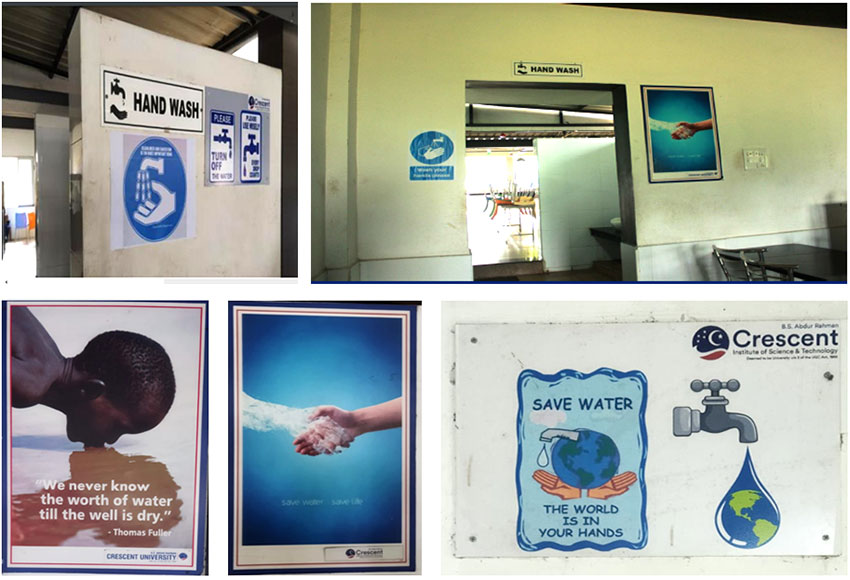
https://crescent.bytdigital.com/iqac-csi-sdg6-2021-23/#pcwu
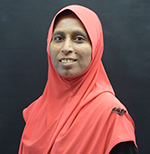
The Crescent Energy Club is a vibrant community of students, faculty, and professionals passionate about sustainable energy and its vital role in shaping our future. As an organization committed to promoting energy literacy and fostering a culture of sustainability, we invite you to join us on this exciting journey.
Our club serves as a platform for knowledge sharing, networking, and collaboration among individuals interested in energy-related fields. Through a wide range of activities and initiatives, we aim to empower our members to become leaders in the transition towards a clean and sustainable energy system. For more details: https://crescent.bytdigital.com/student-affairs/istd-clubs/crescent-energy-club
B.S. Abdur Rahman Crescent institute of Science and Technology received certificate for having actively participated in the IGEN GREEN DAY 2023 by taking Green action pledge and contributing towards the UN Sustainable Development Goals.

https://crescent.bytdigital.com/iqac-csi-sdg7-2021-23/#lco
“BSACIST plays a crucial role in the promotion towards renewable energy sources through advocacy efforts. Our institution actively supports the commitment by arranging meetings with key stakeholders, and organizing events and discussions”
By signing on behalf of BSACIST, we are accepting a key role in fighting global injustice and committing our institution to a central and transformational role in attaining the Sustainable Development Goals (SDGs) by 2030. This commitment will look different for each institution, and we look forward to work and to achieve aspirational levels of sustainability for our students, staff and the wider community.
Together we can help create the next generation of change agents and redress the balance between people, planet and prosperity.
IMPLEMENTATION / OUTCOME
| Annual SDG Accord Report 2023 | SDG Accord Report 2023 |
 | SDG ACCORD Certificate |
| Green Action Certification – I-Gen | Green Action Certification |
| STAR World Record Ambassador | IGEN – Star World Record Ambassador |
| IGEN – Sustainability Best Practices Award | IGEN Energathon Certificate |
| IGEN – Star Contributor | IGEN – Star Contributor |

https://crescent.bytdigital.com/iqac-csi-sdg7-2021-23/#rep

The Faculty members of BSACIST are encouraged to inform and support Government and NGOs in Clean Energy and Energy – Efficient technology to help the community to return to renewable energy sources and to reduce environmental impacts. In line with that, BSACIST joints hand with IGEN – The Institution of Green Engineers (IGEN) to connects green professionals worldwide, working towards SDG goals and providing solutions for a sustainable greener future through the 9 colour nonagon VIBBGGYOR society.
IGEN – Serve as a catalyst to connect all professionals for building a greener world.
To bring together all the professional practitioners working for creating a green community. To provide sustainable environmental solutions to achieve a green world. To inspire, inform and influence the global engineering community to adopt green engineering practices in their design, product, process and systems. https://www.theigen.org/
https://crescent.bytdigital.com/iqac-csi-sdg7-2021-23/#pct
By reducing energy demand, India can lessen the pressure on its energy infrastructure and reduce the need to build new power plants, which often use fossil fuels. Cost-effectiveness: Energy efficiency measures generally have a lower upfront cost compared to building new renewable energy infrastructure.
| Guidelines issued by the GOI | https://powermin.gov.in/en/content/energy-efficiency |


Academic Year 2020-21

Department of Civil Engineering, School of Infrastructure conducted a Virtual Alumni Meet on 05.06.2021 from 11.00 AM to 02.00 PM. Around 90+ Alumni attended the meet from almost all parts of the world. The main aim of the Alumni meet to create an awareness on “SDG 13 – Climate Action – Development with Environment, Pollution and Environmental Degradation”
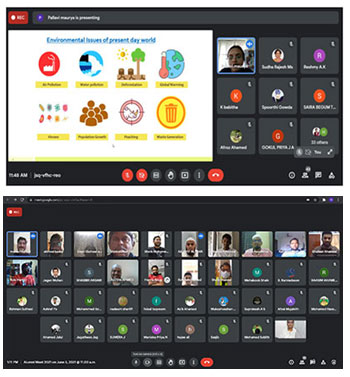
Alumni Entrepreneur Webinar – Special awareness program for creating awareness about SDGs 8 – Decent Work and Economic Growth, SDG 9 – Industry, Innovation & Infrastructure and SDG 12 – Responsible consumption and Production


Virtual Alumni Meet 2021 (4th September 2021) for creating awareness on SDGs 1 – No Poverty, SDG 2 – Zero Hunger, SDG 8 – Decent Work and Economic Growth, SDG 9 – Industry, Innovation and Infrastructure, SDG 16 – Peace, Justice and Strong Institutions and SDG 17 – Partnerships for the goals

The HoD briefed about the Department and introduced the faculty members. Dr. K. Ganesh, Director, Office of Alumni Relations felicitated the Alumni participants. All the Alumni participants introduced themselves, shared their experiences and given valuable feedback for building sustainable societies and organizing events for providing awareness to the local community on various SDGs.
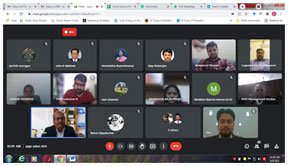
Creating awareness on SDG 3 – Good Health and Well-being

The camp was inaugurated by Mrs.Selva Sundari Rajendran, President of Keerapakkam village and Mr.A.K.G.Balaji, Vice-President of Keerapakkam village. Ms. Shanthi, headmistress of panchayat union middle school appreciated the efforts taken by the NSS unit for the benefits of school children. Nearly, 200 school students undergone medical investigation and got benefited by this free medical camp.

Creating awareness on SDG 3 – Good Health and Well-being, SDG 6 – Clean Water and Sanitation

The camp was inaugurated by Mrs.Selva Sundari Rajendran, President of Keerapakkam village and Mr.A.K.G.Balaji, Vice-President of Keerapakkam village. Ms. Shanthi, headmistress of panchayat union middle school appreciated the efforts taken by the NSS unit for the benefits of school children. Nearly, 200 school students undergone medical investigation and got benefited by this free medical camp.
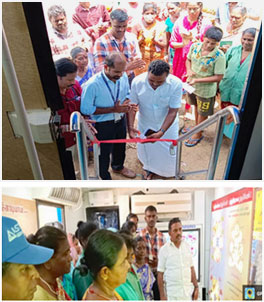
Educational Programme on SDG 10 – Reduced Inequalities and SDG 16 – Peace, Justice and Strong Institutions through Human Rights Day Celebration 10.12.2021


Education Programme on SDG 16 – Peace, Justice and Strong Institutions through Constitutional Day 26.11.2021

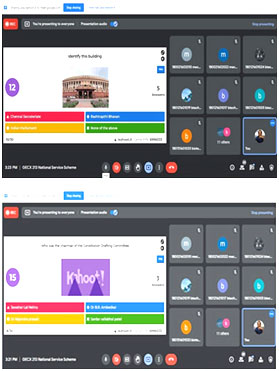
Exclusive Educational Awareness Programme on SDGs through NSS SPECIAL CAMP

NSS special camp was held during 09.03.2021 to 15.03.2021 to create awareness on sustainability living for the people of Adanur panchayat.
The camp started on 09.03.2021 with a formal inauguration. On 10.03..2021, NSS student volunteers are involved in forming the small teams among the people of the village and conducted various activities to impact the knowledge of the SDGs and importance of the same.
NSS student volunteers also distributed pamphlets to the public in and around the adopted village regarding the Sustainable Development Goals. A programme was also conducted by the self help group on 11.03.2021 to create awareness on SDG 3 and SDG 6.
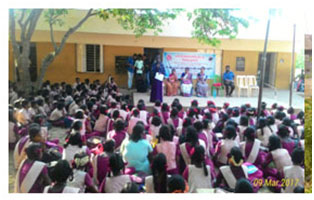
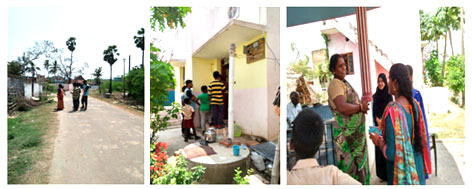
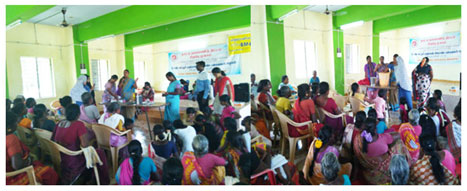
Demonstration session on SDG 3 – Good Health and Well-being, SDG 5 – Gender Equality, SDG 6 – Clean Water and Sanitation, SDG 10 – Reduced Inequalities


SDG 17
- Relationships with regional NGOs and government for SDG policy
- Cross sectoral dialogue about SDGs
- International collaboration data gathering for SDG
- Collaboration for SDG best practice
- Collaboration with NGOs for SDGs
- Publication of SDG reports
- Education for the SDGs Commitment to meaningful education
- Education for SDGs – Specific courses on sustainability
- Education for SDGs in the wider community
- Relationships with regional NGOs and government for SDG policy
- Cross sectoral dialogue about SDGs
- International collaboration data gathering for SDG
- Collaboration for SDG best practice
- Collaboration with NGOs for SDGs
- Publication of SDG reports
- Education for the SDGs Commitment to meaningful education
- Education for SDGs – Specific courses on sustainability
- Education for SDGs in the wider community


